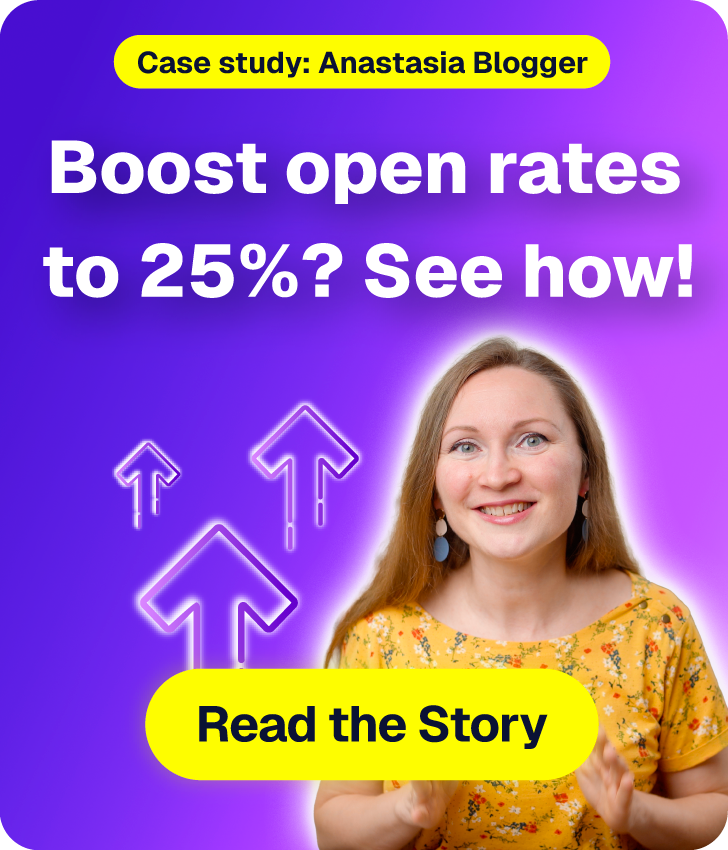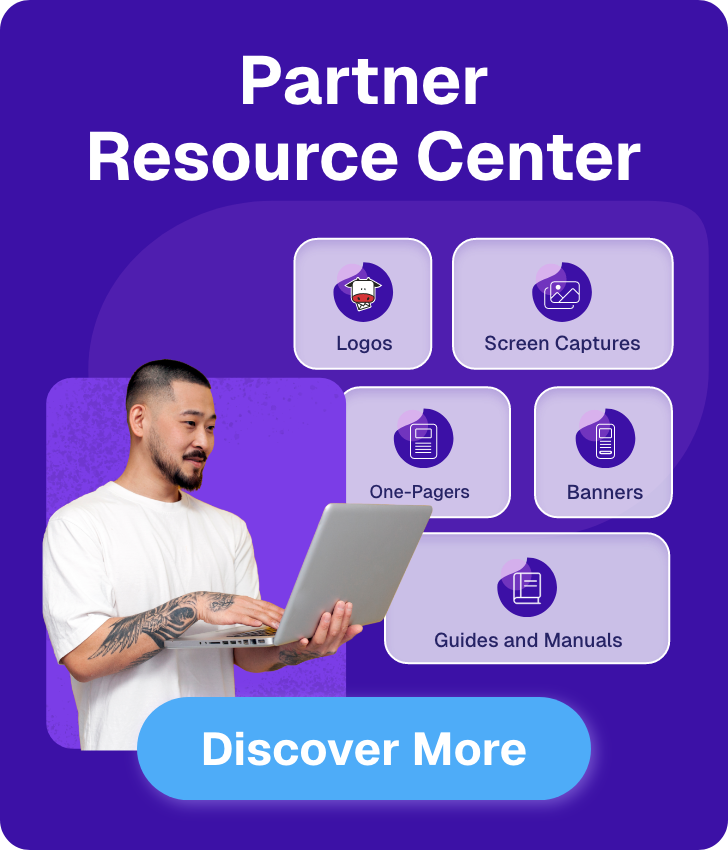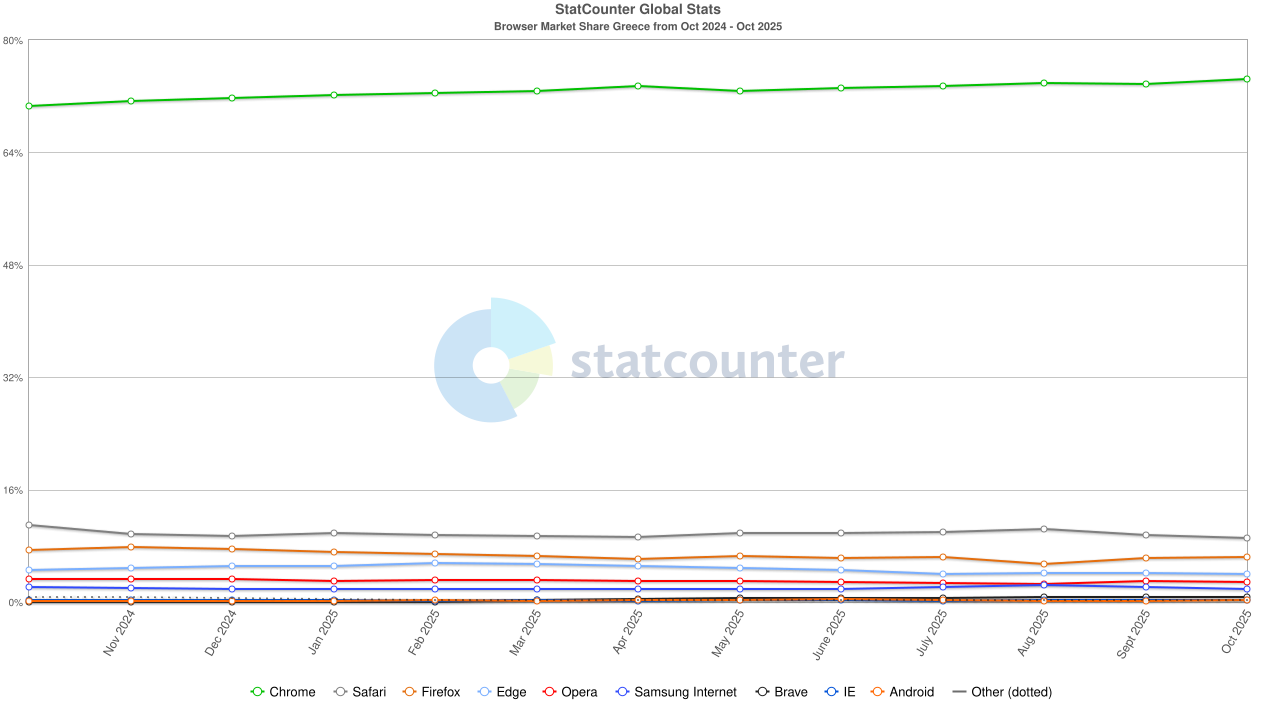Choosing between Postmark and SendGrid isn’t as simple as it looks. Both email services are leading players in transactional email, promising fast delivery and developer-friendly APIs. Yet they take very different approaches to how email should work.
If you’re trying to decide which service is better for your business, it comes down to more than sending a password reset or an order confirmation. You need to know which platform delivers faster, which is more reliable, how their APIs differ in practice, and whether either can support marketing campaigns when needed.
In this post, we’ll break down Postmark vs SendGrid across deliverability, API performance, templates, analytics, pricing, and marketing capabilities. By the end, you’ll know which service fits your stack, whether you’re building a product, scaling an app, or sending high-volume transactional emails.
Looking for an affordable yet powerful transactional API?
Deliver important transactional messages quickly and reliably.
Try MoosendPostmark vs SendGrid: Quick Comparison
Here’s a quick look at how the two platforms stack up:
| Postmark | SendGrid | |
| Free plan | Yes (100 emails/month) | 60-day free trial (100 emails/day) |
| Pricing | $15/month (10,000 emails) | $19.95/month (50,000 emails) |
| Ease of use | Easy | Easy |
| Email editor | Code editor | Visual + code editor |
| Templates | Yes | Yes |
| Testing tools | Spam score monitoring | Email preview, link validation |
| Analytics | Basic | Advanced |
| Email address validation | No | Yes |
| A/B testing | No | Yes |
| Deliverability | 82% | 78% |
Now let’s see more details about each category.
Setup & Ease of Use
Postmark:
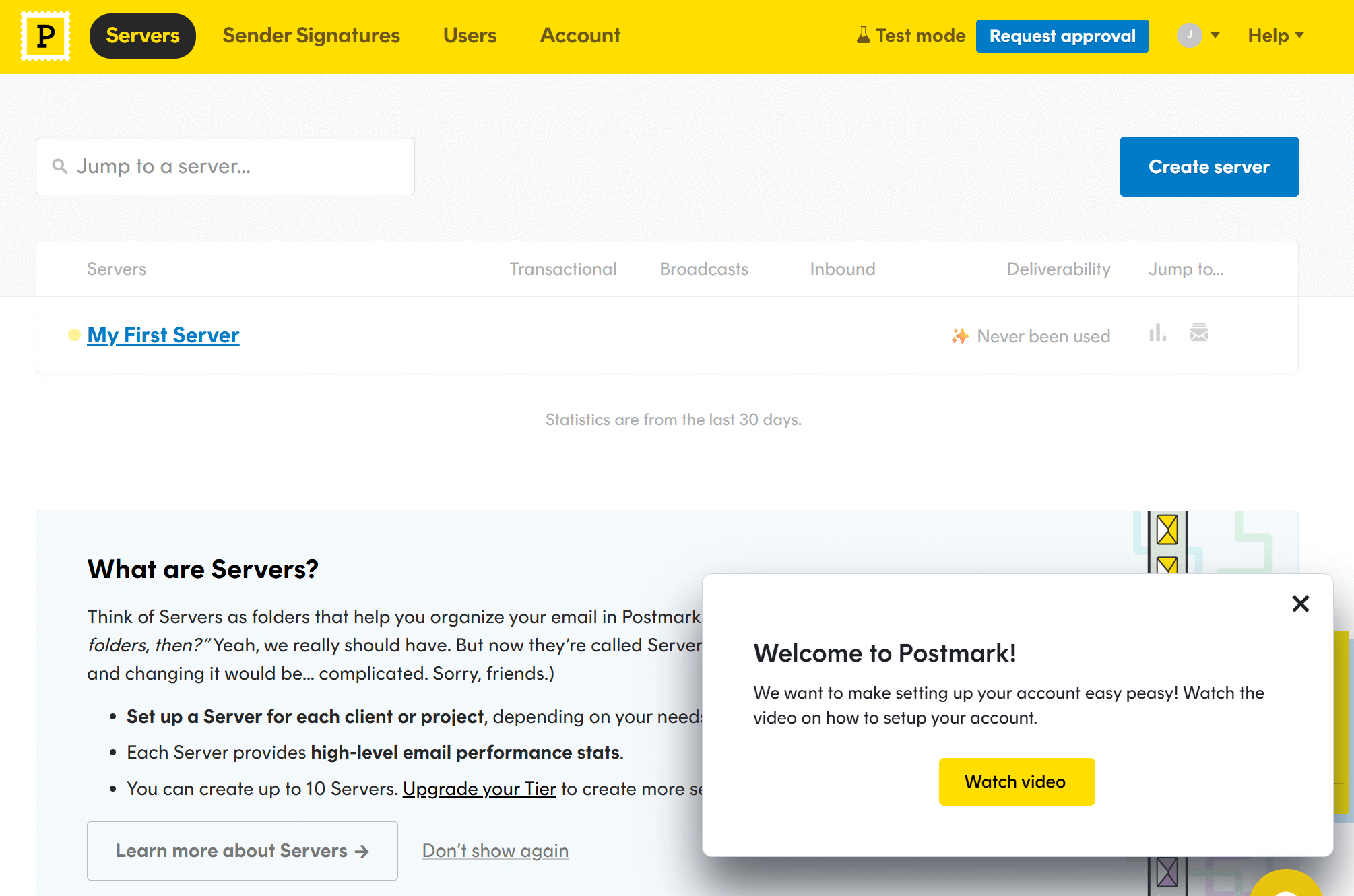
Setting up your Postmark account is simple and quick. The platform walks you through verifying your domain, setting up DNS records, and creating your first server. Upon entering your dashboard, you’re greeted with a welcome message prompting you to watch a quick setup video.
Postmark’s interface is intentionally simple, and you’ll notice the absence of unnecessary menus or complex settings right away.
Developers will appreciate the clear documentation, copy-ready snippets, and sample code in multiple languages to help you integrate the API or SMTP without friction. Everything feels streamlined, making the onboarding process fast.
Navigation is easy and almost clutter-free. If your goal is to send transactional messages reliably without managing a large marketing suite, the overall experience is refreshingly smooth.
SendGrid:
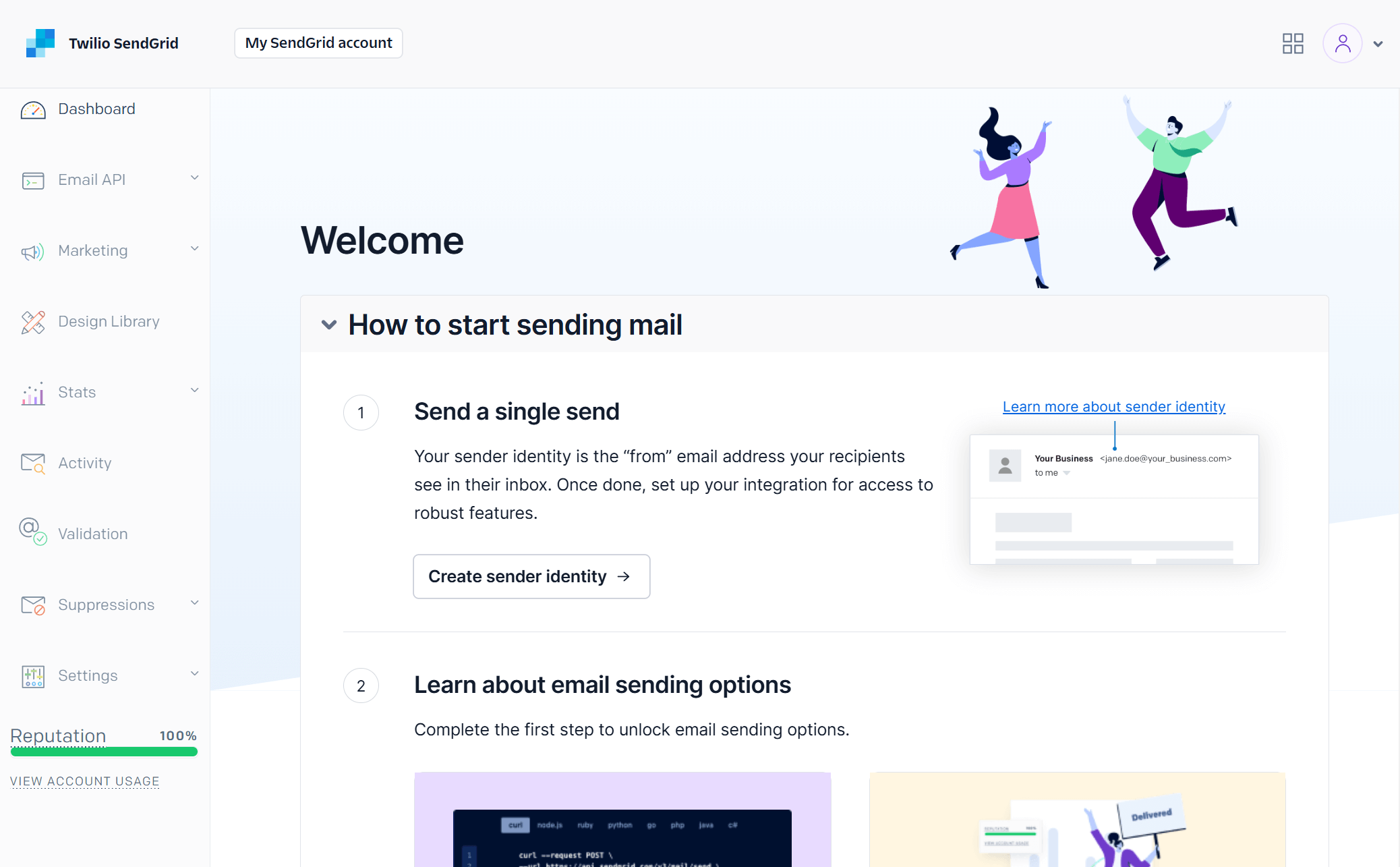
Creating an account with Twilio SendGrid is just as simple. The onboarding wizard provides step-by-step instructions for modifying your DNS records (including SPF and DKIM), IP warmup, configuring multiple senders, etc.
Compared to Postmark, SendGrid’s user interface is more cluttered since it includes more menus and settings. For example, you get a tab for your marketing emails, another for email validations, suppressions, and more.
Nevertheless, SendGrid provides guided setup paths for API integration, SMTP, marketing templates, signup forms, and automation. Everything in the platform is organized, so despite the learning curve, you’ll be able to navigate the platform well enough, whether you need to cover your transactional or marketing needs.
Winner: Postmark takes the lead here thanks to its cleaner interface, lightweight setup, and developer-friendly onboarding.
Email Design
Postmark:
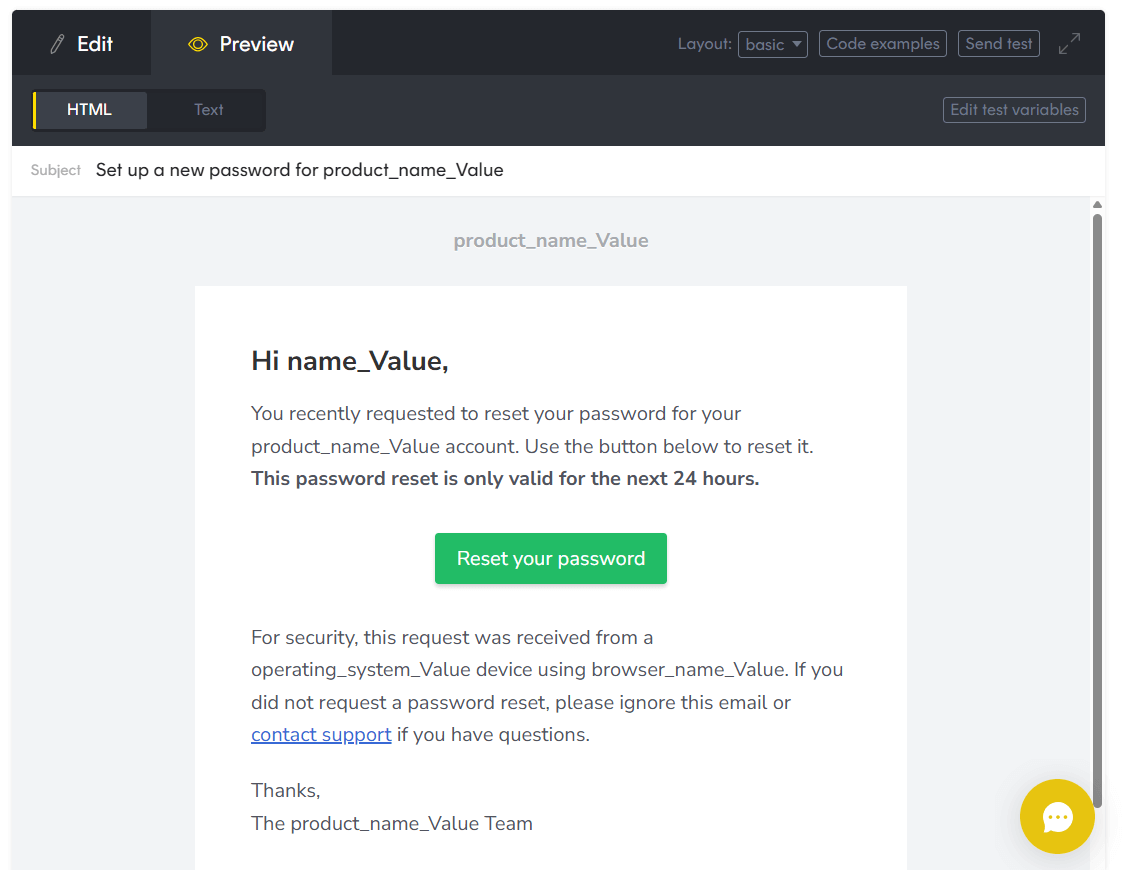
Postmark has a code editor (no drag-and-drop functionality) and a curated library of ready-made templates for common transactional messages such as password resets, welcome emails, invoices, and notifications. These templates follow best practices for deliverability and accessibility, and are easy to customize through HTML and CSS.
This editor is ideal for developers who prefer working directly with code, but less convenient for teams that want to create or modify emails without writing HTML. Overall, the editor keeps things simple, but it’s limited for more complex layouts or branding-heavy designs (e.g., marketing emails).
Note: If you want drag-and-drop functionality, Postmark lets you integrate with ActiveCampaign and use its visual editor to design your emails without writing HTML.
SendGrid:
SendGrid, on the other hand, lets you create email campaigns in two ways. You can use either a code editor with Handlebars syntax or the visual drag-and-drop design editor. Admittedly, the visual editor lets you customize your emails much faster.
Nevertheless, SendGrid makes email creation accessible for both marketers and developers. The latter can dive into raw HTML, while non-technical users can build templates using prebuilt blocks.

The visual editor allows you to insert images, buttons, social icons, and custom code into your campaigns. The platform also incorporates built-in version control for templates, which is helpful when testing different layouts.
Finally, SendGrid has a preview tool that lets you see how your email will appear on desktop and mobile devices.
Winner: SendGrid. It provides more out-of-the-box options for email design.
Templates
Postmark:
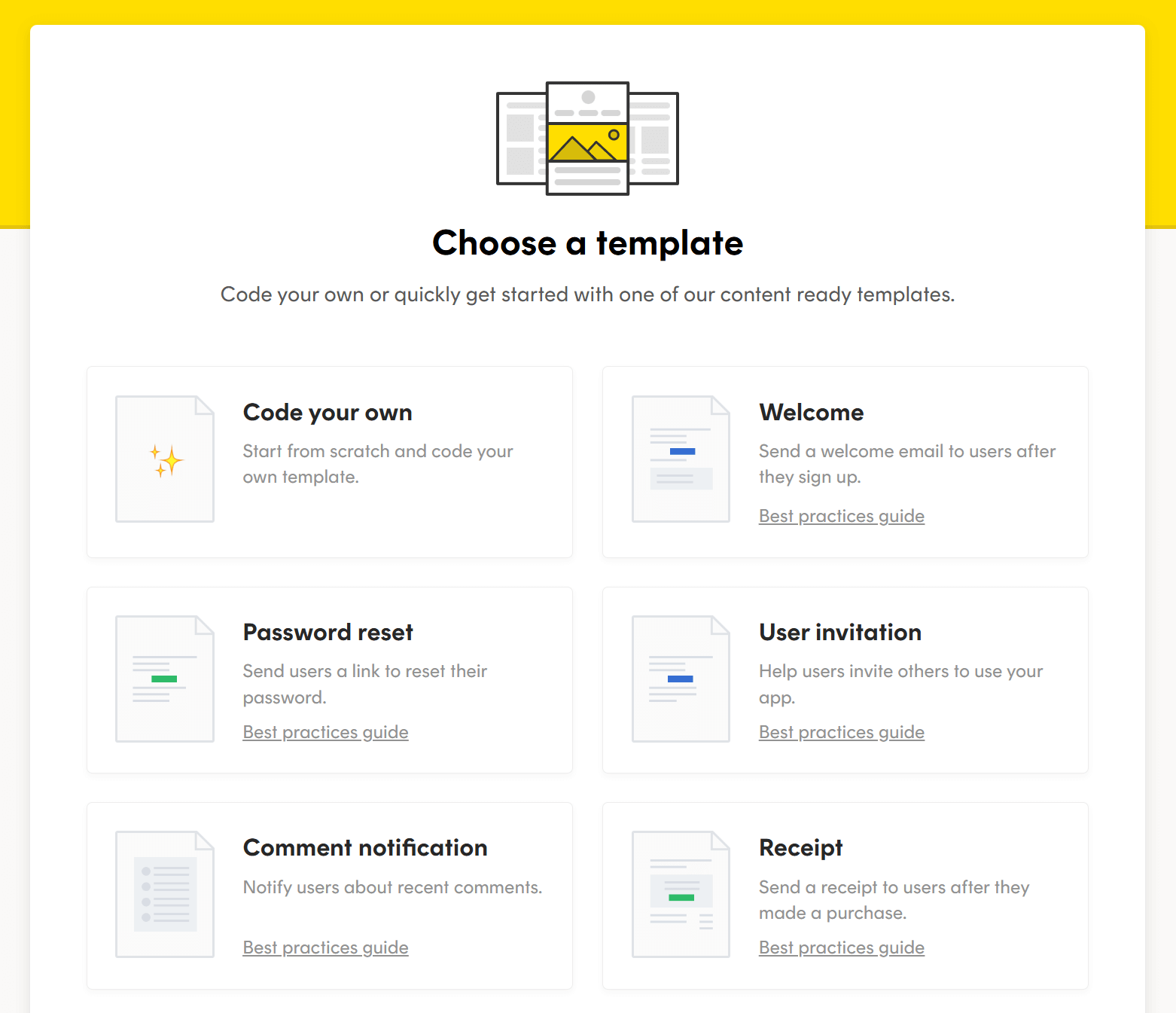
Postmark offers several ready-made templates, including welcome, password reset, order receipts, and comment notification emails. They cover all key transactional email use cases.
The templates are clean, lightweight, and optimized for deliverability. They follow modern HTML best practices and are easy to customize if you’re comfortable editing code. Postmark also offers template “layouts,” making it quick to reuse consistent branding across multiple transactional emails.
However, you won’t find any marketing-focused templates here.
SendGrid:

SendGrid’s library of pre-built templates is richer than Postmark’s, as it also includes templates for marketing purposes. You’ll find designs for use cases like order confirmations, password resets, account notifications, newsletters, promotions, and announcements.
These templates are fully customizable using either the code or the visual editor, giving teams flexibility based on their skills and workflows. You can save blocks and collaborate on these templates with your team, making it easier to maintain consistent branding across large campaigns.
Winner: SendGrid wins this category thanks to its extensive template library and dual editing options.
Email Testing & Previews
Postmark:
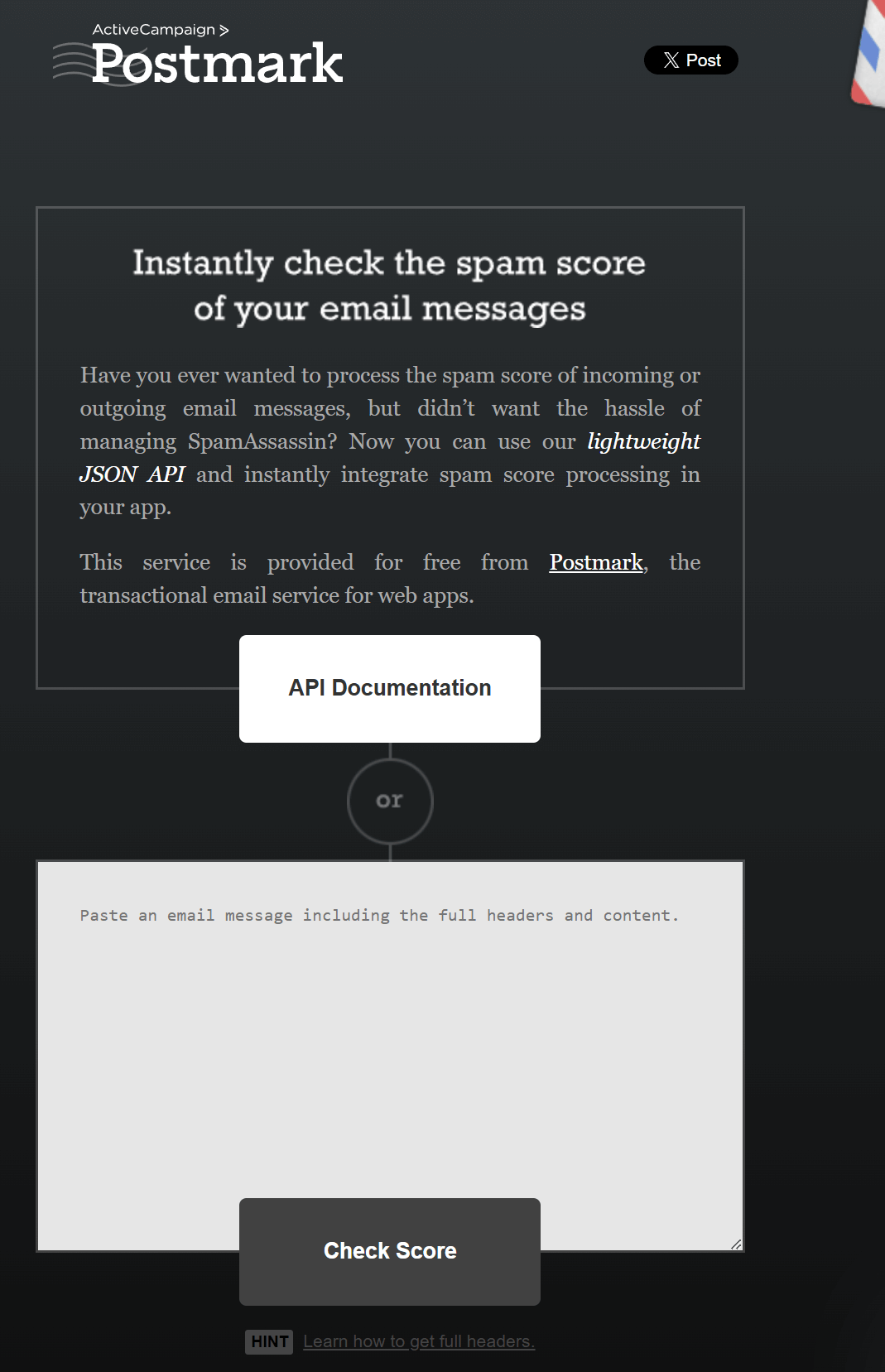
Postmark allows you to preview your templates directly in the editor and send test emails.
We also found that Postmark offers SpamAssassin-based spam score checks inside its template editor. Also, when you update or create a template, Postmark automatically runs a spam score evaluation and alerts you if any elements could affect inbox placement.
This feature is helpful for transactional email teams because it catches common issues early (phrasing, formatting, header problems, etc.) without requiring external testing tools.
SendGrid:
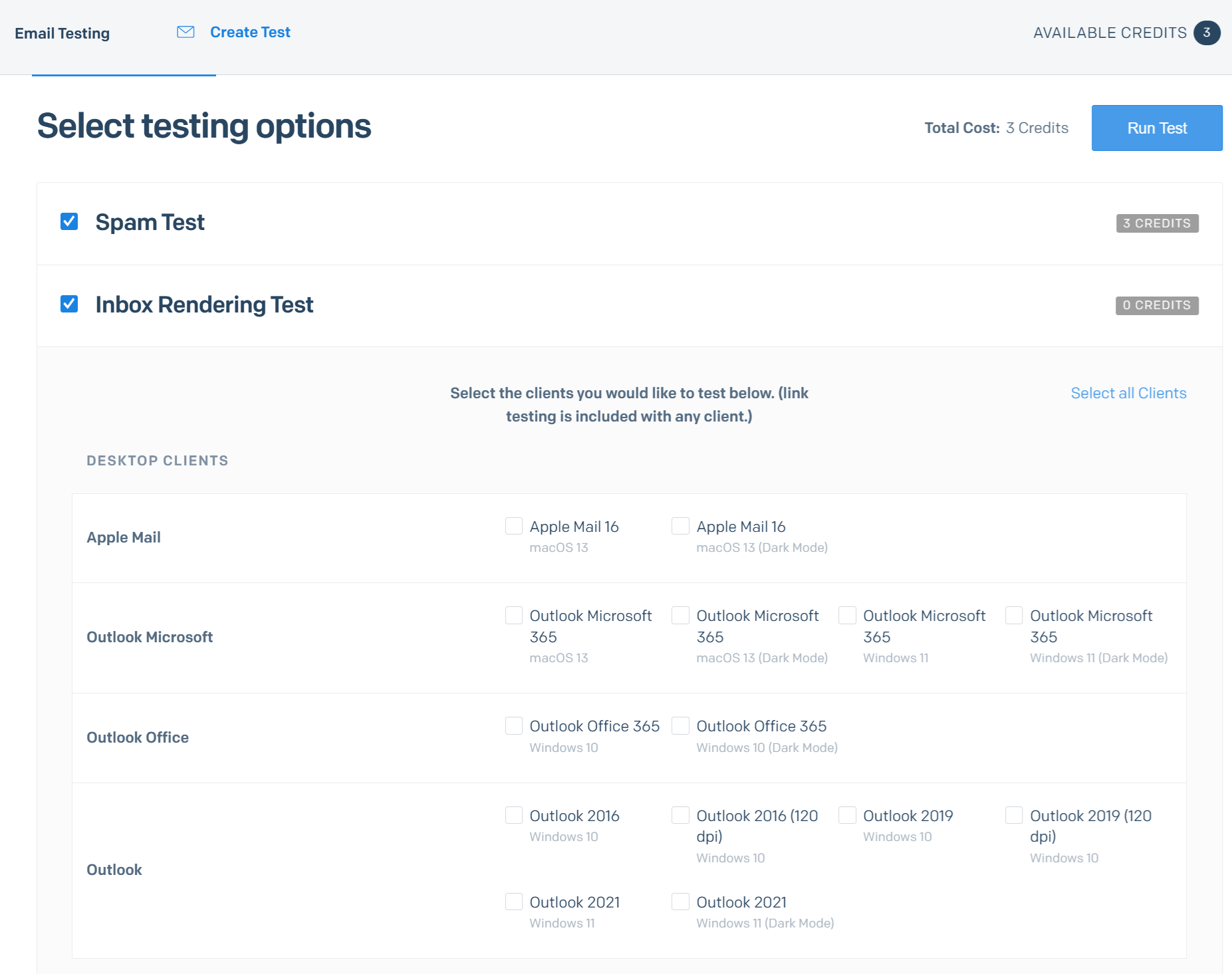
SendGrid, on the other hand, provides a more complete set of testing and preview capabilities, especially useful for businesses that send transactional emails across many device types and clients.
Specifically, you’ll find:
- Inbox rendering previews that allow you to see how an email appears in Gmail, Outlook, Apple Mail, mobile, dark mode, etc.
- Link validation to identify broken URLs
- Spam testing to detect issues that may impact inbox placement
These tools help teams catch design issues and deliverability risks early, particularly for transactional emails that must reach the inbox quickly and without formatting errors.
For developers, SendGrid also supports sending test emails via API calls or sandbox mode, which is useful during integration.
Winner: SendGrid wins this category thanks to its stronger built-in testing capabilities, making it easier to validate rendering, catch issues, and ensure transactional emails look correct in every user’s inbox.
Analytics
Postmark:
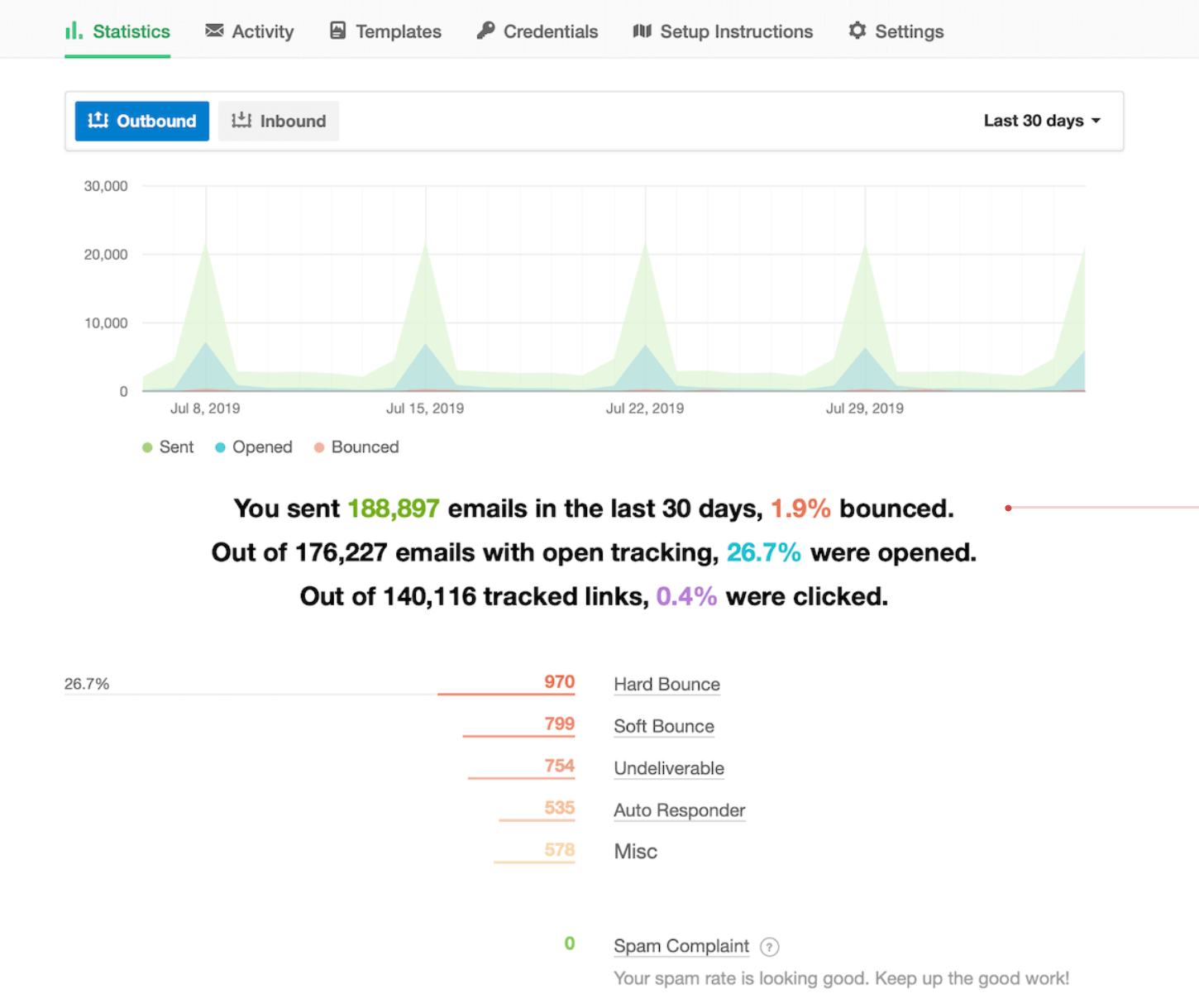
Upon reviewing Postmark, I found that it keeps analytics clean and focused on transactional performance. You won’t find marketing dashboards or overly complex reporting layers.
You get:
- Delivery and bounce tracking
- Open tracking (optional to protect user privacy)
- Link tracking for engagement
- Message-level event history
- Server-level activity dashboards
- Tag-based reporting to group related emails
One of Postmark’s strengths is its message activity view, which allows you to search, filter, and inspect individual email events with precision. Developers will love how transparent the logs are, especially when troubleshooting API issues.
SendGrid:
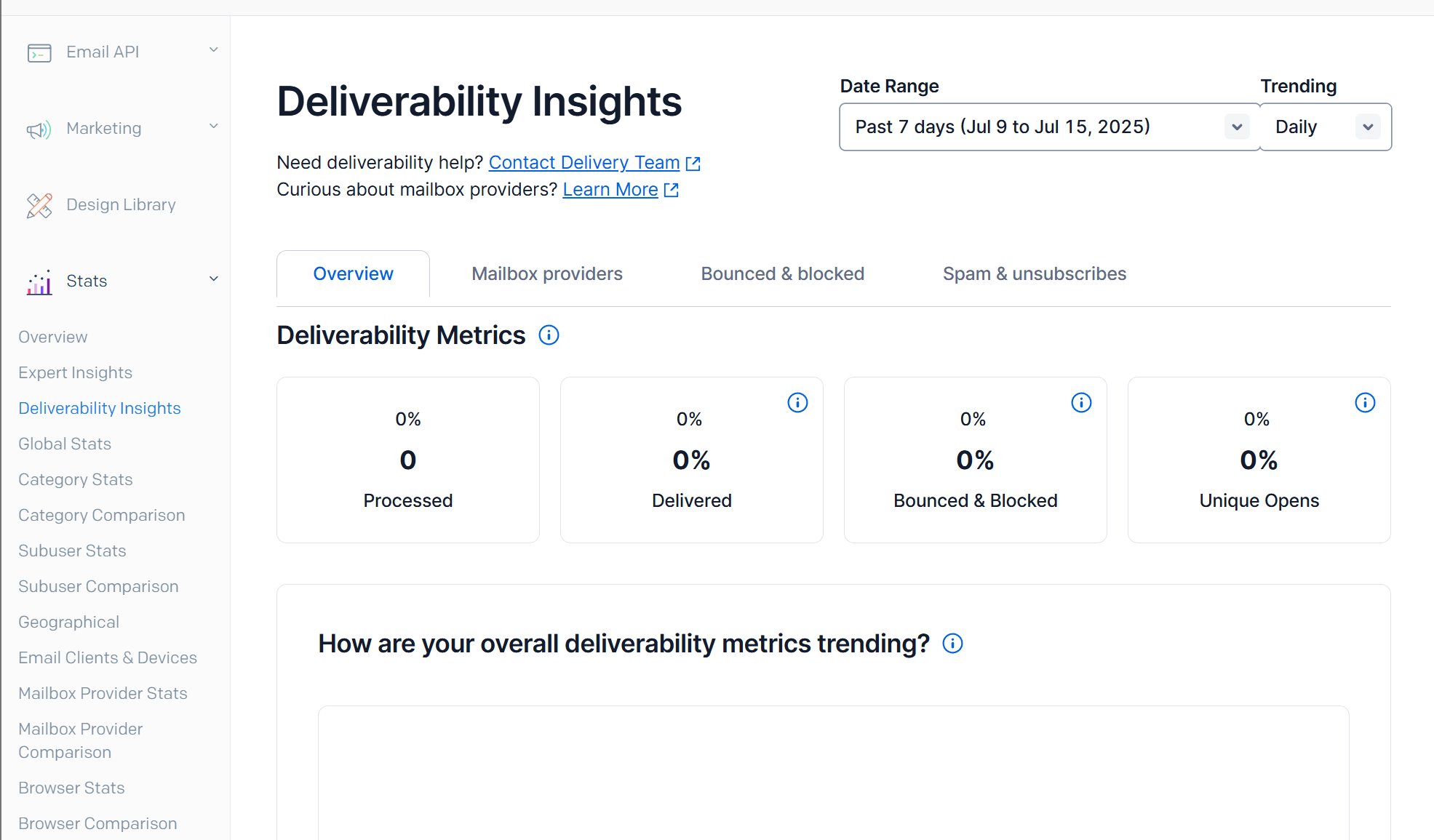
SendGrid offers a visual analytics dashboard with various key insights about your transactional email performance. You can see individual message-level events (delivered, bounced, opened) and how your emails are performing across specific mailbox providers.
The platform even lets you group and compare different transactional flows (e.g., your password resets vs. shipping alerts).
Compared to Postmark, the analytics dashboard is more robust but also more complex. Nevertheless, you get granular, real-time information about your email performance.
Winner: SendGrid, due to the depth of its analytics suite.
Postmark vs SendGrid: Email Deliverability
Deliverability is one of the most important factors when choosing an email service, especially for transactional messages where timing and inbox placement are crucial. Independent tests show noticeable differences between Postmark and SendGrid in inbox performance, spam placement, and overall reliability.
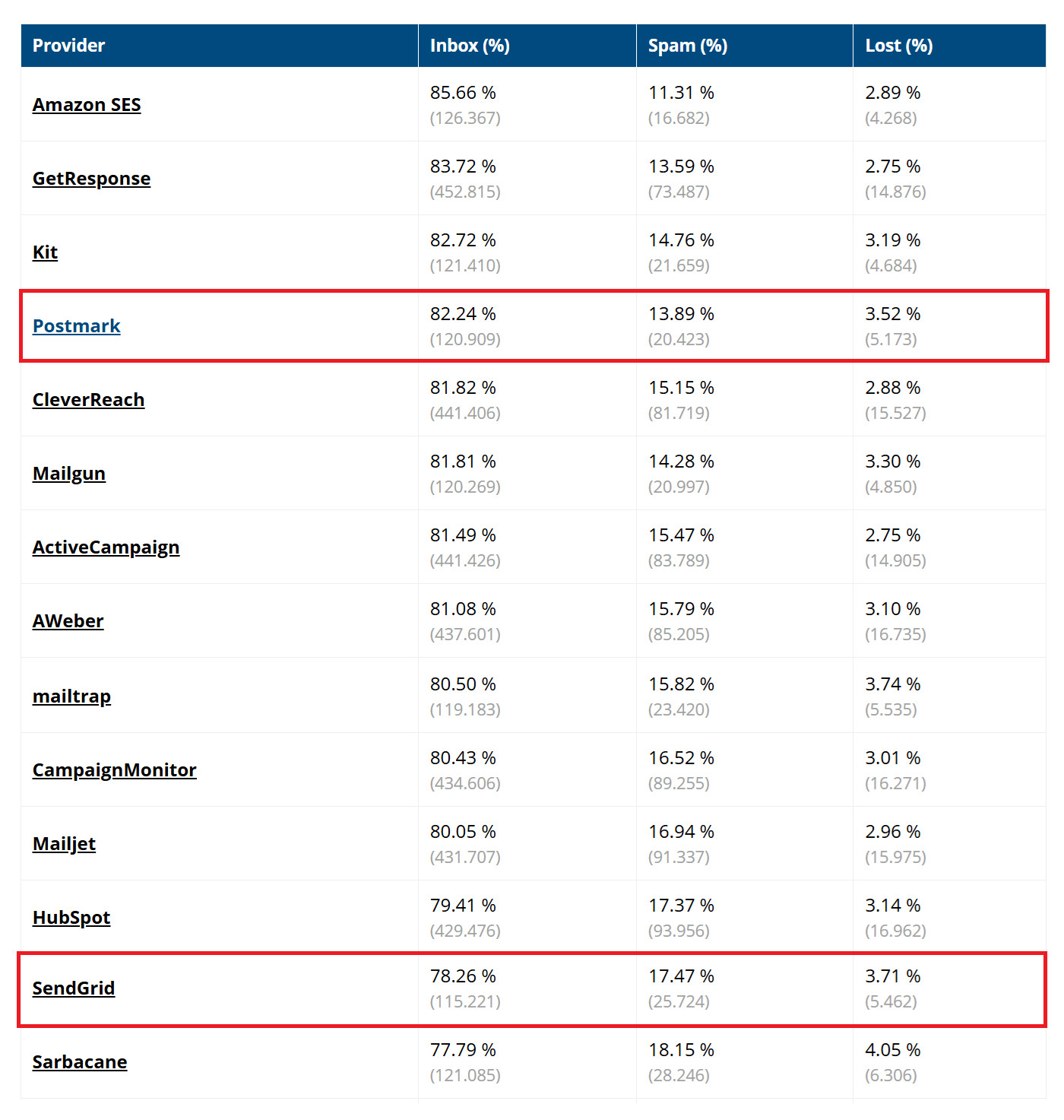
Postmark has built a strong reputation for excellent transactional deliverability, and the latest independent benchmarks support that. Its infrastructure is optimized for transactional traffic only, meaning messages are sent through clean, well-maintained IPs without marketing senders “harming” reputation. Postmark also pre-warms dedicated IPs to help you build trust with ISPs.
On the other hand, while SendGrid has a large, established sending infrastructure, its mixed-use environment (supporting both marketing and transactional emails at scale) affects its deliverability. Consequently, it ranks significantly lower than Postmark in inbox placement and has a higher percentage of emails getting caught by spam filters.
And while dedicated IPs and proper warm-up can improve performance, deliverability is less consistent compared to Postmark.
Winner: Postmark. For businesses where transactional reliability is non-negotiable, Postmark provides a more dependable sending environment.
Postmark vs SendGrid: Integrations
Postmark:
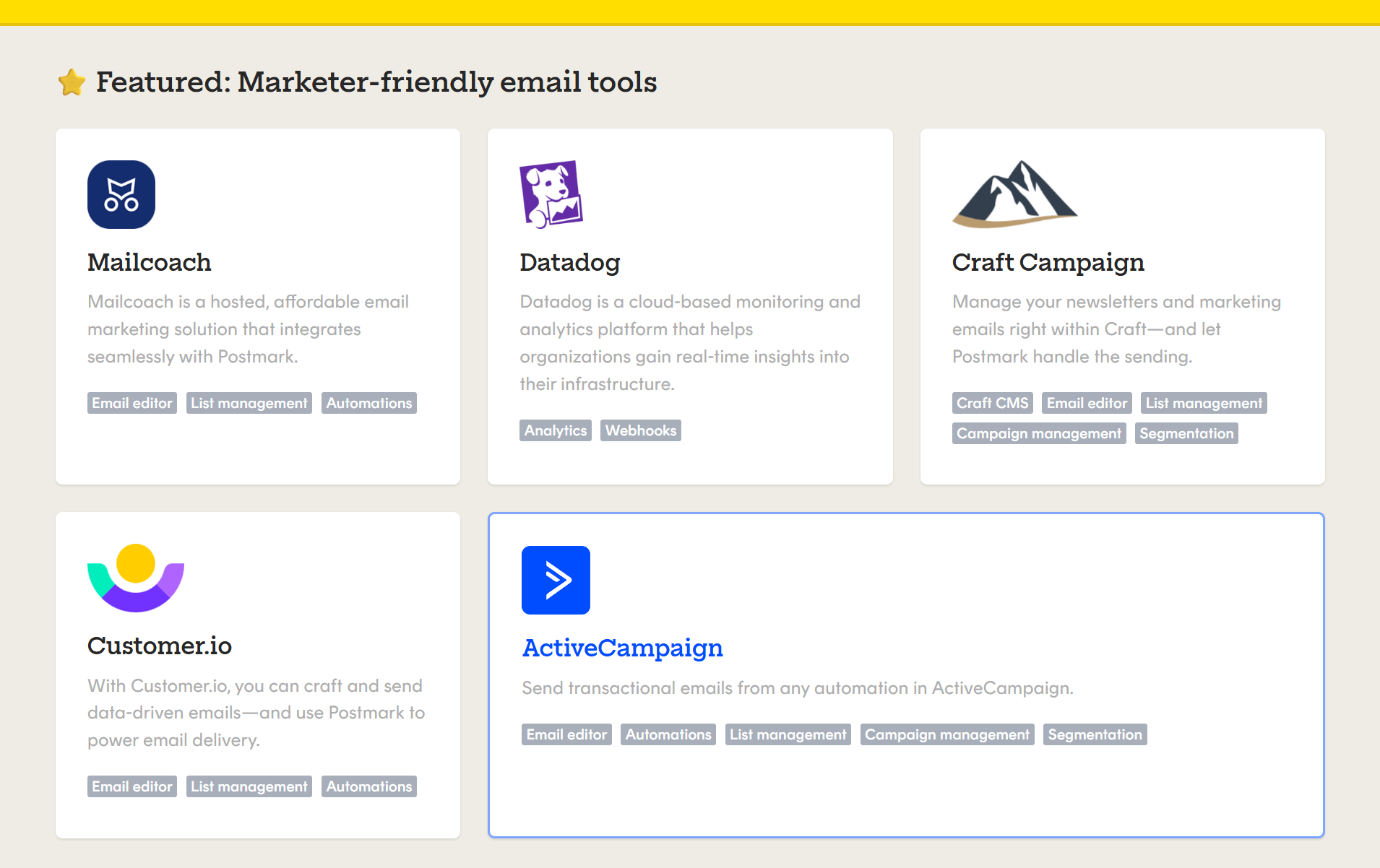
The platform offers 20+ native, first-party integrations covering popular apps such as WordPress, Slack, Stripe, GitHub, and Gravity Forms. However, using Zapier, you can connect Postmark with more than 300 other apps.
Despite the limited number of native integrations, developers report a 60% faster initial setup with Postmark based on comparison studies.
SendGrid:
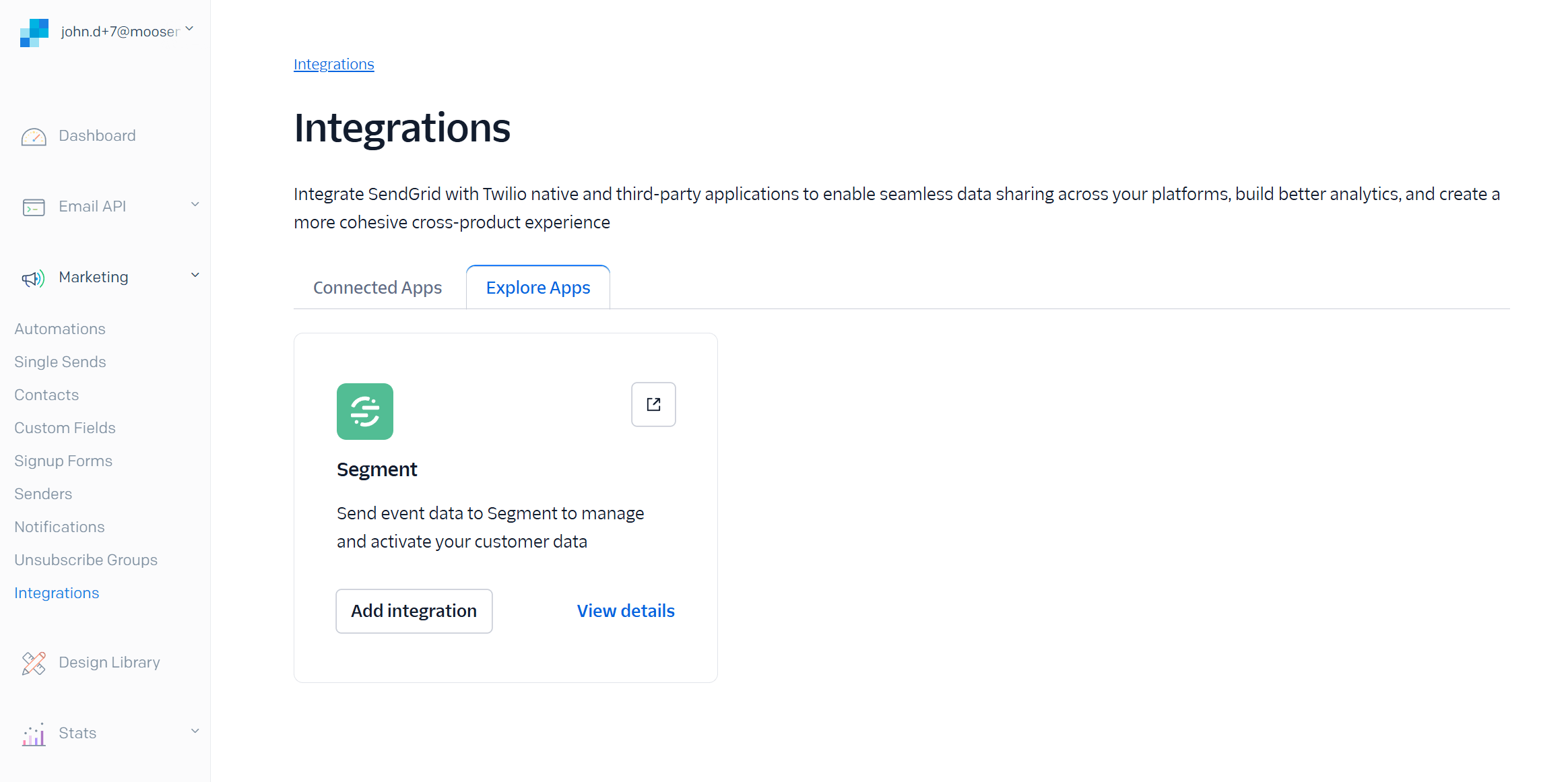
Because SendGrid is widely adopted, many third-party platforms also offer prebuilt connectors for it, making it easy to plug into marketing stacks, ecommerce systems, and enterprise workflows.
We found 130 integrations available, including Shopify, Magento, WordPress, Salesforce, Segment, and HubSpot. The platform also integrates with Zapier.
The integration experience is streamlined, with clear docs, test environments, and sandbox modes.
Winner: Even though SendGrid offers more native integrations, you won’t have integration issues with Postmark, as it can connect with Zapier. So, we have a tie.
Postmark vs SendGrid: Customer Support
Postmark:
Postmark provides the same level of support to all customers. You can contact support via email during business hours. According to users, responses typically arrive quickly.
The platform also provides extensive documentation and code examples, clear API guides, and a transparent status page with uptime and incident history.
SendGrid:
The platform offers different levels of customer support based on the user’s plan.
If you are on the free plan, you have access to self-help resources like documentation, public tutorials, and community forums. You can also contact support via a ticket 24/7.
Paid plan users can contact support via live chat (24/7) or phone, Monday – Friday during business hours.
There is also the option to purchase Personalized Support, which is the highest level of technical support available. This starts at $5,000/month and includes guaranteed response times and a dedicated technical account manager.
User reviews paint a rather “mixed” picture of SendGrid’s support, suggesting that high-quality support will cost more.
Winner: Postmark wins this category thanks to its consistently well-rated support, quick response times, and equal service for all customers.
Postmark vs SendGrid: Pricing
When comparing Postmark and SendGrid, the biggest difference is how easily you can understand what you’re paying for.
Postmark uses a simple, volume-based pricing model that includes all features, while SendGrid splits pricing across API access, marketing features, and add-ons, which can quickly increase the total cost.
Postmark:

Postmark keeps pricing predictable. All features are included, and plans scale primarily based on monthly email volume. Prices start at $15/month for 10,000 emails and $55/month for 50,000 emails. The Pro and Platform plans also allow you to get some optional add-ons. These include dedicated IPs, custom activity retention, and DMARC monitoring.
Postmark also offers a free plan that lets you send 100 emails/month, making it ideal for testing and development.
SendGrid:
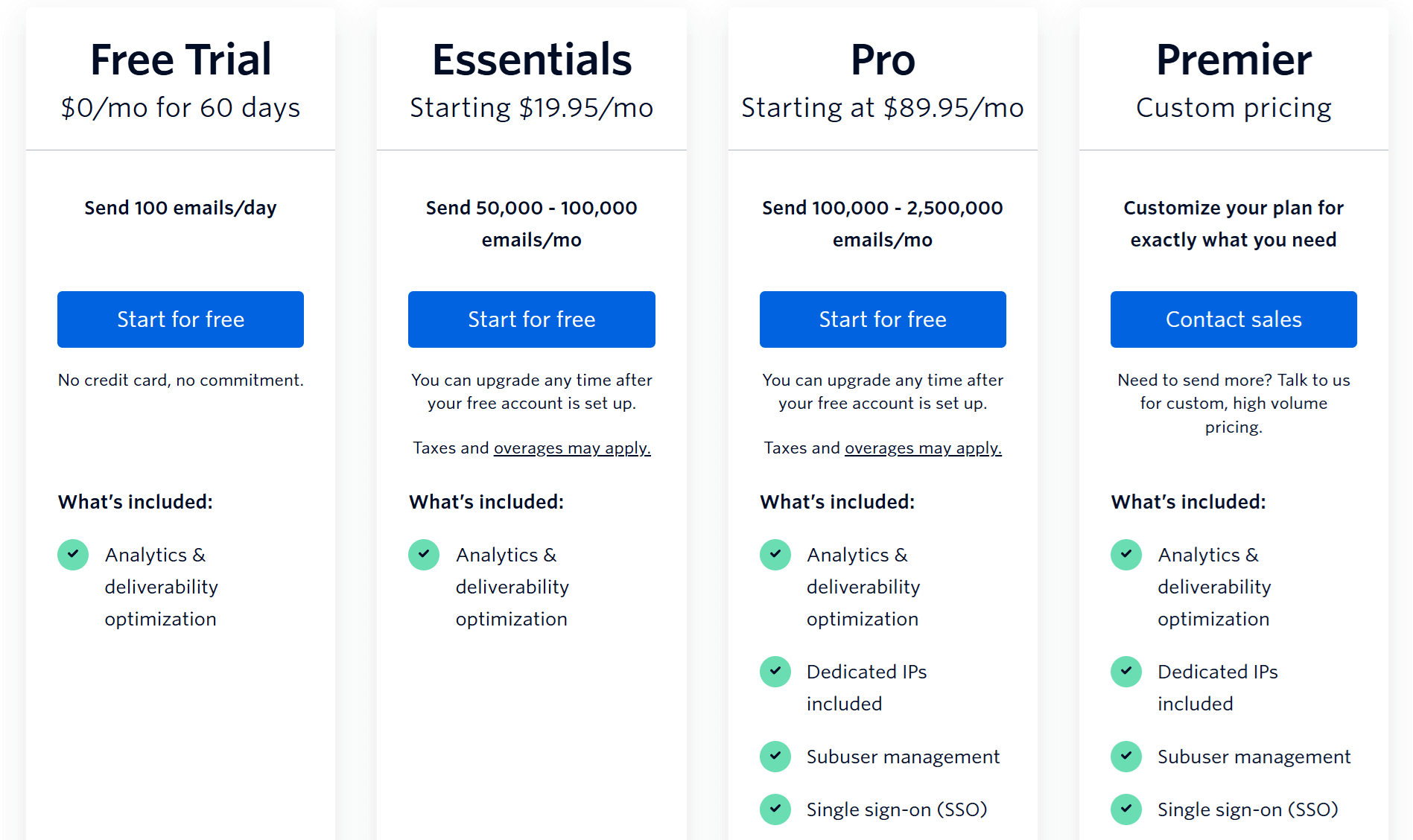
SendGrid’s pricing structure is more complex than Postmark’s. It consists of a free trial and three paid plans.
The Essentials plan starts at $19.95/month with 50K emails/month, deliverability tools, two webhooks, but no dedicated IP. The Pro plan adds a dedicated IP, subuser support, 7-day log retention, priority support, and email validations. Its pricing starts at $89.95/month. Finally, the Premier plan offers custom pricing for high-volume senders.
Unlike Postmark, SendGrid has no free plan. You can, however, use the free trial, which lasts for 60 days and allows you to send 100 emails per day. You get basic analytics, API/SMTP access, one teammate, and one webhook.
Winner: If you only need transactional email, Postmark is more cost-efficient and more transparent. If you need both transactional and marketing tools in one platform, SendGrid may be more convenient, but it comes at a higher cost.
Top Postmark vs SendGrid Alternatives
If you’re unsure about Postmark or SendGrid, or want to explore other alternatives, here are the top solutions.
1. Moosend
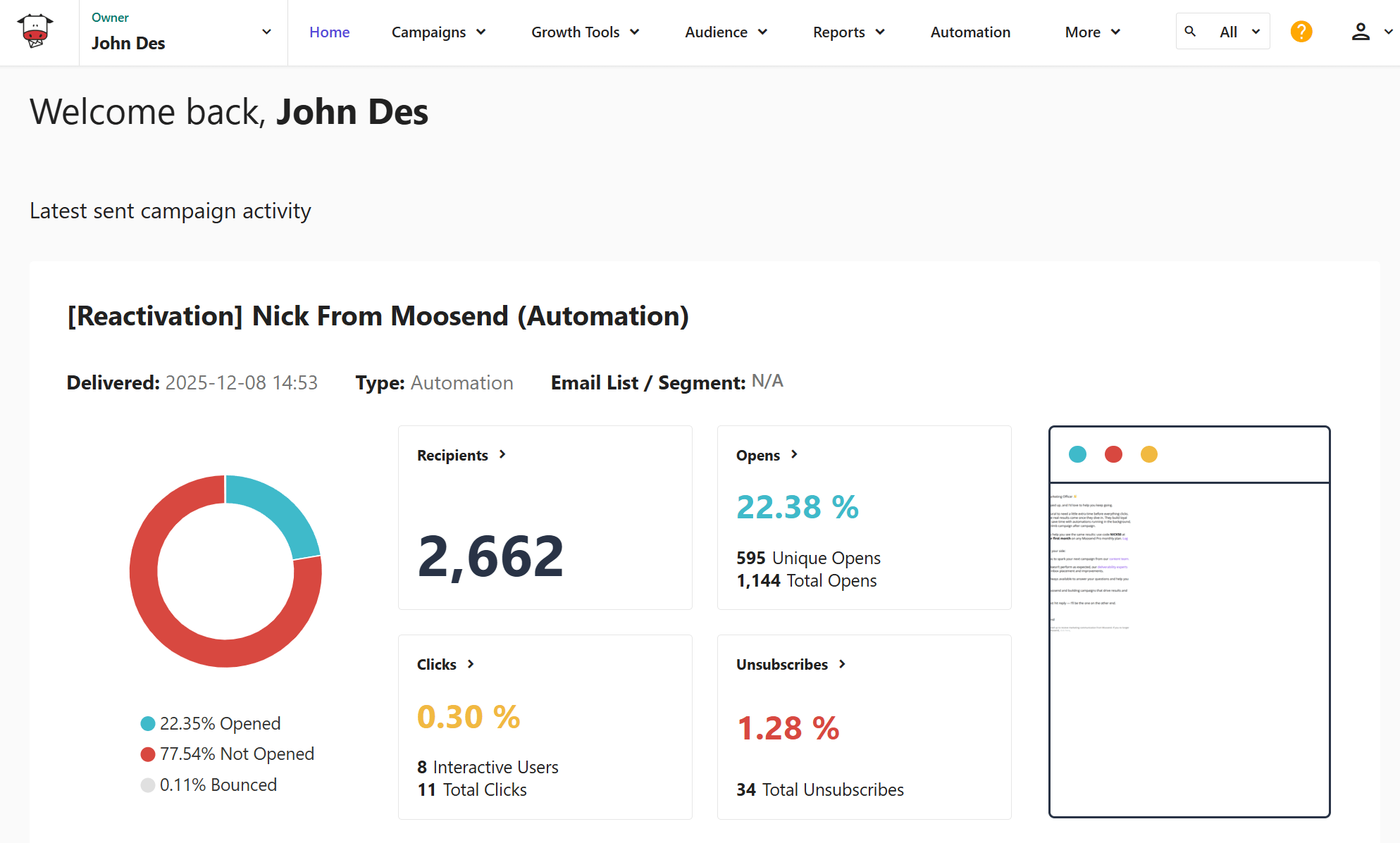
Pricing: Paid plans start at $9/month, 30-day free trial (Sign up here)
Moosend is a powerful, affordable alternative that combines transactional email, automated workflows, and marketing campaigns in a single platform. Its drag-and-drop editor, prebuilt automation recipes, and real-time analytics make it easy for businesses to manage both transactional and promotional emails without switching tools.
For API-driven use cases, Moosend offers a scalable transactional email API, SMTP relay, and detailed activity logs. Finally, Moosend has an email deliverability score of 98%, so you can deliver mission-critical email campaigns quickly and effectively.
2. Mailgun
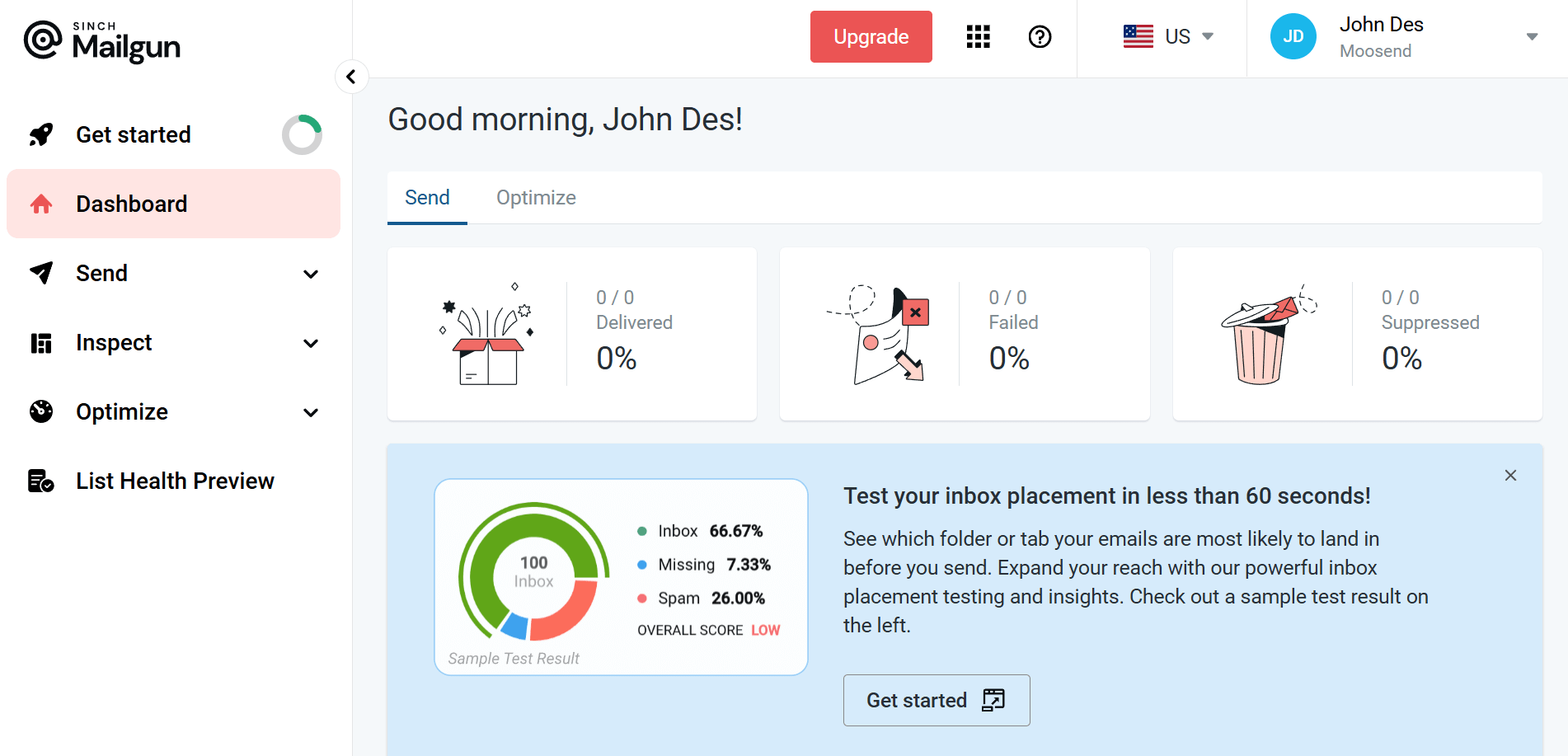
Pricing: Paid plans start at $15/month, free plan
Mailgun is a developer-focused email API service designed for high-volume transactional sending. It offers strong deliverability tools, detailed logs, inbox placement testing, and flexible API endpoints. Mailgun is ideal for SaaS platforms, apps, and engineering teams that want granular control over sending behavior and detailed tracking.
Compared to SendGrid, Mailgun offers more advanced analytics and inbox testing, while offering greater scalability than Postmark. However, marketing features are minimal, making it best suited for teams that want pure transactional functionality.
3. Amazon SES
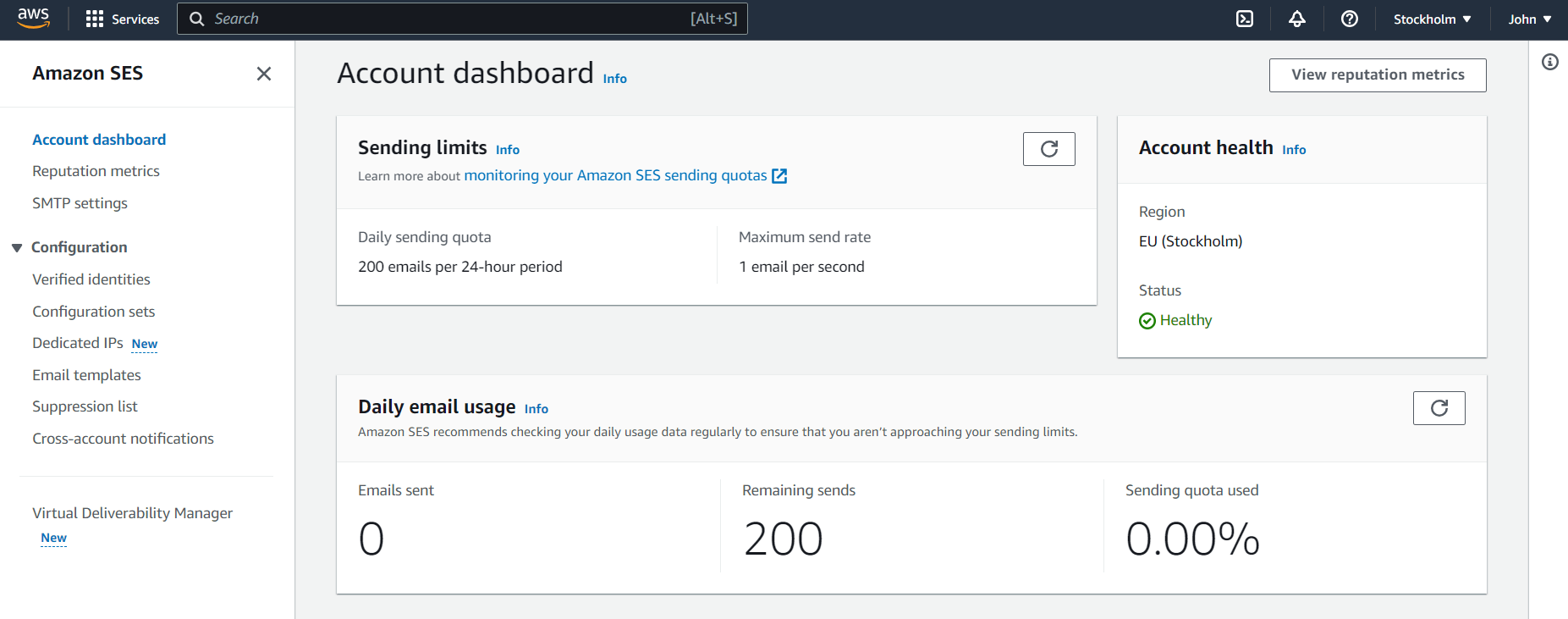
Pricing: $0.10 per 1,000 emails
Amazon SES is one of the most cost-effective transactional email services on the market. It’s highly scalable and integrates seamlessly with AWS infrastructure, making it ideal for developers already working within the AWS ecosystem.
However, Amazon SES is less beginner-friendly than Postmark or Moosend. Its setup requires technical knowledge, DNS configuration, and familiarity with the AWS console. It also lacks built-in templates, visual editing, and marketing tools, but offers unmatched scalability and exceptional deliverability when properly configured.
Additional Resources to Check
Here are a few resources to expand your reading:
Postmark vs SendGrid: The Takeaway
Choosing between Postmark and SendGrid ultimately depends on whether you value simplicity and transactional reliability or prefer an all-in-one platform with both marketing and transactional features.
Postmark is the stronger option for developers and teams focused on fast, reliable transactional email. Its clean interface, consistent inbox placement, straightforward pricing, and high-quality support make it ideal for SaaS products, apps, and businesses that prioritize deliverability above all else.
SendGrid, on the other hand, is better suited for teams that want a more comprehensive tool. If you need a visual email editor, A/B testing, advanced analytics, and both marketing and transactional capabilities in a single platform, SendGrid offers more flexibility at the cost of added complexity.
Frequently Asked Questions (FAQs)
Here are some frequently asked questions and their answers.
1. Which platform is better for transactional email?
Postmark generally performs better for transactional emails thanks to faster delivery, higher inbox placement, and a clean developer experience. SendGrid works well, too, but deliverability can vary depending on IP reputation and plan level.
2. Is Postmark more affordable than SendGrid?
For transactional use only, yes. Postmark’s pricing is simpler and typically cheaper at lower volumes. SendGrid can become more expensive, especially if you add marketing features, dedicated IPs, or higher support tiers.
3. Can I send marketing emails with Postmark?
Postmark is designed primarily for transactional email. While you can send broadcast messages, it cannot function as a standalone marketing platform. For marketing campaigns, SendGrid or a dedicated ESP like Moosend is a better fit.
4. Does SendGrid offer a visual email editor?
Yes, SendGrid includes a visual, drag-and-drop editor as well as an HTML code editor. You can use these to design transactional and marketing email campaigns. Postmark, on the other hand, offers only a code editor.
While AI tools, privacy updates, and social algorithms keep changing the digital space, email remains the one channel you can rely on to reach real people.
Recent reports back this up. Global open rates climbed from around 33% in 2023 to over 36% in 2024, and more than 80% of digital marketers now use email as a core part of their strategy. Most of them rely on automation for welcome flows, abandoned cart recovery, and order confirmations, proving that relevance and timing make all the difference.
With more brands moving toward automation and audience-first content, engagement today depends on quality, not volume. To see what truly works, we analyzed verified human activity across 30 industries from September 2024 to September 2025.
The Digital Context in Greece
Internet penetration, the percentage of the total population actively using the internet, reached around 87% at the start of 2025. This means that roughly 9 out of 10 people use the internet daily for email, eCommerce, social media, and mobile apps.
On a device level, Greece still leans heavily on desktop browsing, with 57.8% market share in September 2025, followed by 40.52% on mobile and 1.69% on tablets. This makes email a channel that adapts easily to how Greeks interact online, regardless of screen size or device.
Browser preferences in Greece are also clear, which simplifies email design decisions. The majority of users rely on only a handful of platforms:
According to the data:
- Chrome dominates with 70.56%
- Safari stays around 11%
- Firefox (7.37%), Edge (4.6%), and Opera (3.26%) are among the least used
In the Mobile OS market, Greek users have a strong preference for Android devices.
- Android leads at 74.2%
- iOS follows with 23.24%
- Samsung and Unknown have 0.88% and 0.12% respectively
But why are these numbers significant for email campaign performance?
These patterns create a highly predictable rendering environment. When most people use the same browsers and devices, emails behave more consistently, reducing the risk of layout or display issues across segments.
This stability makes email one of the most dependable channels for reaching real users. And when brands layer this predictable environment with automation and personalization through Moosend’s automation or transactional API, their campaigns become more relevant, consistent, and practical to maintain.
Moosend Benchmarks: Real Open Rates (Sept. 2024 – Sept. 2025)
Below is a table of real open rates across 30 industries in Greece. These numbers reflect verified human activity and exclude artificial interactions.
| Industry | Avg. Open Rate (%) |
| Government | 37.70 |
| Bank / Finance | 37.36 |
| Religion | 36.56 |
| Sports | 36.29 |
| Education and Training | 35.97 |
| Entertainment and Events | 35.69 |
| Higher Education | 35.17 |
| Hobbies | 34.89 |
| Medical, Dental & Healthcare | 34.17 |
| Health and Fitness | 33.17 |
| Legal | 32.17 |
| Music and Musicians | 32.12 |
| Restaurant | 31.65 |
| Media and Publishing | 31.64 |
| Marketing and Advertising | 30.07 |
| Consulting | 30.07 |
| Travel and Transportation | 29.97 |
| Arts and Artists | 29.92 |
| Non-Profit | 29.84 |
| Real Estate | 29.42 |
| Insurance | 28.70 |
| E-commerce | 28.67 |
| Public Relations | 28.67 |
| Manufacturing | 28.60 |
| Retail | 28.27 |
| Computer and Electronics | 26.47 |
| Construction | 26.14 |
| SaaS | 26.07 |
| Daily Deals / Coupons | 25.87 |
| Beauty and Personal Care | 25.79 |
| Telecommunications | 25.67 |
What the data shows:
- Trust-based industries like Government, Finance, Religion, and Education have the highest open rates, underscoring the importance of updates in driving attention.
- Community-driven sectors such as Sports, Entertainment, and Hobbies perform well thanks to timely, event-based communication.
- Retail, eCommerce, and other competitive industries stay in the mid-range, where segmentation and automation become essential to maintain engagement.
- B2B and service categories see stable performance, benefiting from educational content and recurring updates.
- Technology-heavy sectors like SaaS and Telecommunications face lower open rates, indicating the need for more personalized lifecycle flows.
- Story-led industries such as Non-Profit and Arts maintain healthy engagement, demonstrating the impact of emotionally driven, value-based messaging.
Overall, industries that send targeted, helpful, and expected emails consistently achieve higher open rates.
Industry Insights: What Works and How Brands Use Moosend
Here you’ll see how different industries achieve their results and which Moosend tools support those workflows.
Each example highlights a real use case to help you understand how automation and personalization improve engagement across sectors.
| Industry | Avg. Open Rate | Winning Strategy | Using Moosend |
| Retail | 28.27% | Weekly segmented campaigns + Automations (Welcome & Abandoned Cart) | Moosend’s abandoned cart automation + RSS feed of new arrivals |
| Insurance | 28.7% | Monthly newsletters + Transactional API reminders | Trigger policy-expiry notifications 3 days before due date via Transactional API |
| Education & Training | 35.97% | Automated learning journeys & event invitations | RSS automation for new courses + follow-ups when certificates are issued |
| Government | 37.7% | Clear communication & high trust updates | Transactional API for notifications + accessible preference centers |
| Beauty & Personal Care | 25.79% | Product recommendations + interactive content | Personalized dynamic blocks based on previous purchases |
| Media & Publishing | 31.64% | RSS auto-newsletters segmented by topic | Automatically deliver fresh stories using Moosend’s RSS-to-Email |
| SaaS | 26.07% | Drip campaigns & renewal flows | “Trial expiring soon” emails triggered via API |
| Non-Profit | 29.84% | Emotional storytelling + donation follow-ups | Year-end donor thank-you automation |
| Hospitality / Travel | 29.97% | Pre-trip sequences + loyalty engagement | Pre-departure tips + post-stay feedback emails via transactional API |
This breakdown helps each sector understand which tactics drive performance and how automation or API-driven communication supports better results.
Multilingual Audiences & Real Email Engagement in Greece
Email engagement improves when communication matches real user behavior. In Greece, this behavior is shifting fast due to the growing number of foreign-born residents and digital workers settling in the country.
During the Omnichannel Retail Conference in Athens, Daniel Meck (CCO of Moosend) shared insights showing how quickly Greece’s audience is changing. Non-Greek residents now contribute an estimated €1.7 billion in annual everyday spending. This includes digital nomads, Golden Visa holders, and international professionals who often prefer English or another language.
However, while foreign-born residents make up 11.3% of the population and have higher purchasing power, many Greek businesses still communicate only in Greek. And the poll conducted during the conference confirms this gap.
Attendees were asked two simple questions. Here’s what the data showed among 122 participants:
Q1: In which languages is your website published?
- 68% publish their website in both English and Greek, showing clear awareness of the multilingual audience in Greece.
- 25% operate Greek-only websites.
- 7% offer websites in more than two languages, targeting a broader international audience.
Q2: In which languages do you send newsletters?
- 57% send Greek-only newsletters.
- 43% send bilingual newsletters (English + Greek) based on subscriber preference.
- Less than 1% send newsletters in more than two languages.
Subscribers may browse in English but receive emails they can’t fully understand. This friction directly affects engagement, conversions, and customer retention. And with a growing multilingual audience in Greece, this gap becomes even more costly.
How to target a multilingual audience with email marketing
So, what does this mean for Greek businesses relying on email marketing?
The mismatch between bilingual websites and Greek-only newsletters shows a missed opportunity. Closing this gap can significantly improve engagement.
Here are a few steps that can help drive email growth:
- Asking subscribers for their preferred language at signup
- Segmenting subscribers based on language
- Offering English versions of core campaigns
- Using your ESP’s multilingual content generation feature in emails, forms, and landing pages
Given Greece’s strong internet usage and consistent device patterns, combined with an expanding international community, aligning email content with subscriber language preferences becomes essential.
When communication reflects the way people use the web in their daily lives, open rates and engagement metrics increase steadily.
Additional Resources
Here are some helpful email marketing guides for different industries.
- The Complete B2B Email Marketing Guide
- Ecommerce Email Marketing: Grow & Engage Your Audience
- Email Marketing For Hotels: Step-By-Step Guide
- How To Do Email Marketing For Small Businesses
- Email Marketing For Hospitals: The Ultimate Guide [2025]
- The Ultimate Email Marketing for Real Estate Businesses
- Email Marketing Guide For Nonprofits
Real Engagement Starts with Relevance
Email continues to evolve, but the fundamentals remain unchanged. When messages are timely, useful, and tailored to real user needs, engagement follows. Moosend’s data shows that once artificial signals are removed, authentic interactions become clear and measurable across every industry.
Brands that invest in relevance and automation see stronger performance, whether they operate in government, education, retail, or SaaS. Real engagement comes from understanding your audience and delivering content they expect and trust.
If you want to power campaigns with verified human activity, explore Moosend’s automations and transactional API to reach people with accuracy and impact.
If you’re lucky, you have a friend who knows what to say, when to say it, and when to let silence do the talking, just by reading your expression or behavior. Now, how do you get that same level of intuition with your subscribers?
You might not have the in-depth understanding of a longtime friend, but you know their actions. And with the right trigger emails, you can give your audience what they need, when they need it.
In this post, you’ll learn how to set up triggered flows that match the recipient’s stage in your funnel but also feel more resonant and less promotional. Moreover, you can explore trigger email examples in action, along with best practices for using them strategically.
Keep your subscribers happy and the burnout away
Deliver timely emails easily with Moosend’s automation features.
Start freeWhat Is a Trigger Email?
A trigger email is an automated campaign sent to subscribers based on their activity or predefined events. Here are some examples of actions that can set a workflow in motion:
- Signing up for an email list
- Downloading a lead magnet
- Browsing product or pricing pages
- Purchasing a product or service
- Clicking a link in an email
- Abandoning a shopping cart
And the list goes on. What you choose as a trigger event depends on your objectives and the subscriber’s level of engagement or stage in the customer journey, unlike more traditional marketing emails. But that’s not their only difference.
Trigger Emails vs Marketing Emails
So let’s review the key differences between these email types:
| Characteristics | Trigger emails | Marketing emails |
| Function | Sent automatically to each subscriber based on their behavior or events |
Set in advance to target a list or segment at a set date and time |
| Timing | Reaches recipients when the trigger action or event occurs |
Delivered according to a predefined schedule |
| Use cases | Onboarding, browse and cart abandonment, customer re-engagement |
Newsletter, product or feature announcements, seasonal sales |
| Personalization | Personalized based on the subscriber’s behavior and stage in the sales lifecycle |
Might rely on basic segmentation rules but less tailored due to their broader targeting |
| Engagement | Generally high due to their alignment with the recipient’s behavior |
Usually average but depends on list quality, content value, and email practices followed |
| Objectives | Prompting timely interactions, nurturing lifecycle stages, boosting customer retention |
Informing about announcements and updates, building brand awareness, increasing seasonal revenue |
Why Should You Deliver Automated Campaigns?
It might feel like a lot to handle, but the benefits of automated emails outweigh any effort required to set them up:
- Enhanced personalization: Unlike generic email blasts, automated campaigns allow brands to target subscribers with relevant content like onboarding, birthday offers, or post-purchase follow-ups.
- Improved engagement: Triggered emails follow an action or event that subscribers instantly recognize. They can find value in the message and engage with it, whether that’s a cross-sell promotion or a loyalty reward.
- Optimized experience: When timed properly, these emails feel like real-time customer support recipients get without moving a finger. Like in the case of a replenishment email that lands in their inbox just before they run low on a favorite product.
- Better retention: Consumers are loyal to brands that fulfill their needs and show up when it matters. Keeping customers in the loop with regular updates, tailored solutions, and exclusive perks lies at the heart of customer retention and loyalty.
- Scalability: With a single workflow, you can guide many subscribers throughout their customer journey at once, with messages that feel crafted just for them. And it keeps working as your list grows, helping you send hundreds of emails without hiring more people or spending more time.
Top Trigger Email Examples for Each Sales Funnel Stage
How can you know which emails to send and when? Here, you’ll find the most effective trigger email types based on the subscriber’s stage in your funnel, and real-life examples from popular brands.
Awareness
This is the stage of first impressions. You’ve gained your audience’s attention, and they’re open to learn more about your products or services and how they may serve them.
Welcome emails
A welcome campaign is typically triggered when someone signs up for a newsletter or creates an account.
Why they work:
As the first touch point between your business and new subscribers, they can make or break your relationship. Focus on making your audience feel valued right off the bat and setting expectations on what’s to come.
How to use them:
- Thank people for joining your list or share a note from your founder to make it more special.
- Introduce your brand’s values, mission, or key team members.
- Offer a rundown on what to expect next, including the email frequency.
- Highlight best sellers, new product lines, or core features.
- Give subscribers a first-time discount.
- Prompt them to complete their profile.
Welcome emails work for every industry since their main purpose is to start building real connections. But, depending on your business type, you may use different tactics to get there.
For a retailer, an effective way to get off on the right foot is to offer a promo code on the recipient’s first order. A non-profit could do so by briefly sharing their mission and impact stories.
Be My Eyes, for instance, added a video to this simple yet powerful welcome email to showcase how volunteering for their cause makes a difference.
Subject line: Welcome to Be My Eyes

Onboarding sequences
This kind of trigger emails are set in motion once someone signs up for a SaaS product, whether it’s a free trial or free version.
Why they work:
Onboarding sequences are designed to help users get started with your product or service. When you remove potential frustration through clear, digestible instructions, they feel confident about the next steps. Which, in turn, increases early adoption and customer satisfaction.
How to use them:
- Share resources to help prospects familiarize themselves with your products.
- Walk them through with demo videos since this content format is easier to consume.
- Include customer support options, plus links to your Help Center, webinars, or product tours.
- Take the step-by-step approach when navigating through different features to avoid information overload.
- Invite them to join social media groups so they can connect with other users and become part of the community.
Although onboarding sequences are associated with SaaS tools, other industries may use them to show common use cases for their products or help people get instant value from their services. For example, a fitness studio could guide new members through their first month.
In their onboarding sequence, monday.com invests in action-oriented copy to motivate subscribers to build their first workspace. There’s also a visual list of resources to choose from to explore what they can do with the product.
Subject line: Welcome to monday work management
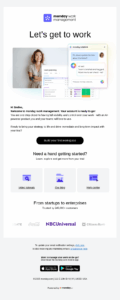
Consideration
Now your prospects are more aware of your brand and offers. But usually they also want to check other solutions before making their final decision.
Browse abandonment campaigns
Brands send browse abandonment emails to visitors who view product or pricing pages and leave without taking further action.
Why they work:
Browsing shoppers are likely engaging in product comparison or thorough research. With a well-timed and value-packed browse abandonment email, you can redirect their attention back to your offers and highlight why they stand out.
How to use them:
- Mention their action to ensure your email feels relevant and subscribers feel seen.
- Segment your audience so first-time visitors and returning customers don’t get the same offers.
- Throw in a free shipping incentive to reignite their interest.
- Add scarcity to the subject line and copy for limited-edition products that sell fast.
- Share downloadable resources like reports or case studies to keep them engaged.
- Show your willingness to help or guide them if they have questions.
These trigger emails are effective for businesses with longer buying cycles like premium items or services that require more consideration.
For example, a real estate company could offer a virtual tour to re-engage visitors, while an automotive business might include an exclusive insurance deal to prompt action.
Wuffes combines two tactics in the following browse abandonment email: social proof in the form of expert reviews and scarcity to highlight that the products are selling out quickly.
Subject line: We noticed you had your eye on this…

Wish to get those visitors back to your website with a targeted workflow? You can use Moosend’s built-in automation recipes to save time. Find the website re-engagement sequence and start tweaking it.
You can select the time interval to perfect your timing, customize the campaign through the email editor, and narrow down subscribers based on certain filters.
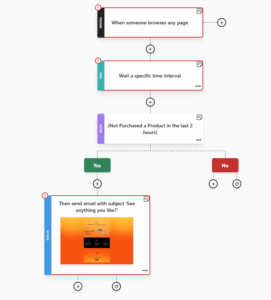
Decision
At this point, your prospects are seriously considering your products or services. Now it’s time to give them that gentle nudge that will persuade them to buy.
Abandoned cart campaigns
These automated emails are triggered every time a visitor adds one or more items to their cart but doesn’t check out.
Why they work:
With 71.72% of consumers leaving their cart behind, this is a revenue leak that you have to address. A cart recovery email sent shortly after visitors leave their cart is the perfect way to remind them of your products and why they wanted them.
How to use them:
- Send an automated sequence including at least two emails to gradually nudge people back.
- Add product images and descriptions to jog their memory.
- Use a second email to send a time-sensitive incentive like free shipping or a small discount.
- Ensure your CTA is clear and visible, bringing them directly to the checkout page to remove friction.
- Add social proof like customer testimonials to boost credibility.
Trust signals aren’t limited to testimonials or star ratings, though. For a B2B it might be security and compliance badges or logos of reputable companies trusting its services. For an online store, something as simple as a 30-day free return policy or “X customers bought this” could do the trick.
Loftie, for example, builds trust with a clear refund policy, free shipping, and free returns. They also make the offer more appealing by giving a discount code.
Subject line: Still not sure?

Purchase
The stage where dreams come true. Prospects turn into customers, and you should continue to inform and engage them, guiding them toward the ultimate goal: customer retention.
Confirmational emails
Automated confirmation emails are triggered when someone reaches your conversion point, whether that’s placing an order or scheduling a consultation.
Why they work:
Their main purpose is informational, helping businesses remove any transaction-related anxiety and let customers know that everything goes as it should. For this reason, they’re essential for making them trust you, offering a flawless experience.
How to use them:
- Deliver them within a reasonable time frame so customers don’t start worrying if something went wrong.
- Include all the order and payment details, along with an expected delivery date, or send a second email when it’s finalized.
- Add product or service images as visual reminders to build anticipation.
- Thank customers for their preference, letting them know that you value their trust.
- Wait for a few days after they receive the products or use your services to send a feedback request email.
These emails may take different forms depending on your industry. In healthcare email marketing, for example, they serve to confirm and manage appointments. On the flip side, a travel company uses these trigger emails to inform customers about their booking and provide stay or itinerary tips.
Just like Delta Air Lines does in the email below, displaying the flight details while sharing resources on the departure process, flight security tips, and travel optimization options.
Subject line: Your GSP > SFO Trip Details

If you need more ideas on how to design confirmational emails and other transactional messages, check out these transactional email templates to find the one that suits your needs.
Retention
The purchase isn’t the end of the journey, but rather the beginning of customer retention. In this stage, you should focus on turning one-time buyers into repeat customers.
Post-purchase follow-ups
Post-purchase follow-ups are triggered emails sent after a conversion to ensure satisfaction, encourage reviews, and bring future purchases.
Why they work:
Consumers appreciate brands that stay in touch after-sale. Sending post-purchase emails demonstrates that you care about offering value beyond the transaction. This interest may take the form of helpful content or tailored product recommendations. It’s also the perfect time to ask them to rate their experience.
How to use them:
- Invite subscribers to leave a review or offer feedback after they’ve received the product.
- Follow the “penny-for-your-thoughts” approach, offering an incentive like a small discount in return for their input.
- Include product usage resources like maintenance tutorials or warranty registration to improve satisfaction.
- Send personalized cross-sell promotions to suggest complementary products to enhance your customers’ experience.
- Invite them to join your loyalty program, ensuring you mention all the exclusive perks included.
For example, a cosmetic brand may leverage a post-purchase replenishment email to remind customers when they’ll probably run low on a product and suggest a refill. Similarly, a food brand can give out relevant recipes or storage tips.
Best Day Brewing’s email is as simple as it gets, with a straightforward subject line, an NPS survey, and a clever thank-you note.
Subject line: Can We Ask You One Question? 🙏
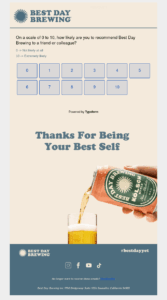
Milestone emails
Milestone emails are triggered when a certain important date is reached (e.g., a subscriber’s birthday or business anniversary) or when a customer completes a goal using your product or service.
Why they work:
With these emails, businesses acknowledge subscriber achievements or special days. They’re even more effective when combined with tailored deals, for example personalized birthday offers that 84% of consumers love receiving.
How to use them:
- Make sure the subject line mentions the occasion and any incentive involved.
- Start with heartfelt wishes if it’s a birthday or anniversary email.
- Use festive emojis or GIFs to get subscribers into the celebration mood.
- Remind your customers of their starting point to highlight how far they’ve come in their goal-setting journey.
- Leverage the opportunity to get recipients excited about what comes next with early access to new products or exciting events.
Regardless of the industry, it all comes down to rewarding your customers with highly personalized messages. For example, a subscription-based business might share detailed insights about the user’s activity and progress.
On the other hand, an online store could deliver a BOGO deal or freebie that matches their past purchase behavior.
Starbucks does everything right in this birthday email, using a relevant subject line, positive language, and clear instructions on how to claim the birthday offer.
Subject line: Open on your birthday 🎁 (Actually, you can open now)

Advocacy
After customer retention comes advocacy. You can get there by encouraging loyal customers to become brand ambassadors or simply satisfying them to the maximum.
Referral program emails
These triggered campaigns encourage loyal customers to refer their friends in return for a mutual reward. They may have different triggers, such as customers reaching a product usage milestone or filling out a post-purchase survey.
Why they work:
Consumers prefer products or services their friends or peers recommend or rate high. You won’t find better marketers than those who’ve tried and loved your offers. So, referral emails can contribute to a loop where a satisfied customer brings in new people.
How to use them:
- Clearly explain the action required, displaying all the details on what both the referrer and referred person will get out of the offer.
- Make sure the incentive is relevant to the customer’s preferences and buying behavior.
- Consider making the reward time-sensitive and highlight it with elements like urgency-focused copy or countdown timers.
- Feature referrer testimonials talking about the benefits of joining your program.
- Let customers know that you won’t spam their friends with too many or irrelevant messages.
You might think that eCommerce referral programs are the only ones that bring results, but that’s not the case. For instance, an airline could reward their loyal customers with points for each successful referral, whereas a SaaS business could add credits to their accounts.
In this referral email, Cometeer communicates the benefit with a bold headline and a relevant image so recipients instantly know what’s in it for them. The generous and time-limited offer is front and center, naturally guiding subscribers to the CTA.
Subject line: One week only: Share Cometeer, earn a free pack
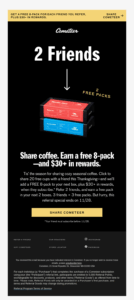
Re-engagement
What about those customers who are at the doorstep, ready to turn away from you? They aren’t necessarily a lost cause. You can reignite their interest through targeted re-engagement emails.
Win-back emails
Businesses deliver win-back emails after a specific period of inactivity to gain back dormant customers’ attention. These may be people who stopped purchasing or engaging with your content after a specific period of time.
Why they work:
Re-engagement emails allow you to share relevant deals and content to remind inactive subscribers why they preferred your products. If you don’t hear back, you can remove them from your lists to secure a good deliverability rate and allocate your resources to subscribers who bring back value.
How to use them:
- Share rundowns of what you’ve been up to during their inactivity (e.g., new product lines, features, collaborations, awards, etc.).
- Reintroduce your offers with fresh content like case studies.
- Incentivize them with a freebie, a discount, or other special deals.
- Ask subscribers to adjust their email preferences so they receive fewer or more relevant emails.
- Don’t be afraid to get emotional, using phrases like “we miss you” or “we want you back” (just keep it balanced).
Let’s say that you own an online course platform. You can send a re-engagement email with a promo code on the next course your customer signs up for. On another note, an online magazine could target recipients with fresh content tailored to their browsing habits.
Here’s how New York Magazine handles it, centering the uncluttered design around their latest articles. The email copy highlights the subscriber-only perks, and, in case this doesn’t work either, there’s a generous discount for those who resubscribe.
Subject line: What You Missed at New York Magazine

Trigger Email Best Practices
Inspiration isn’t enough to build effective triggered campaigns. Here’s how to use the data at your disposal to its fullest potential to ensure that your trigger emails work:
Personalize the message
About 74% of consumers expect better personalization when they share more data with brands. Your audience wants one-on-one conversations that feel relevant and perfectly-timed.
Create trigger email content that speaks to them directly and helps them understand why you asked for their information. For instance, if your subscription form required their job role, you should deliver emails with offers, content, and solutions that match their profile.
Referencing their recent actions will also make them think: “This was written just for me.” Besides behavioral insights from your website, use data sources like your signup forms, email or social media interactions, and customer support insights.
Dynamic content is another way to put the right offer in front of each recipient. This powerful tool adjusts the content blocks shown to subscribers based on specific characteristics like their location or preferences.
Just like Netflix does in its emails, sharing tailored recommendations using the user’s viewing history.
Subject line: What to watch after Sex Education

Deliver clear value
A trigger email campaign serves multiple goals, such as guiding, educating, and rewarding subscribers with compelling content and promotions. To win them, start your message with short and engaging email copy that answers the question: “Why should I care?”
Value doesn’t always come from freebies or discounts. It might also look like:
- A free resource like a template or report that makes a professional’s day-to-day easier.
- A dietary, workout, or skincare routine that matches subscriber preferences and habits.
- A personalized product or service recommendation.
- A customer testimonial or case study that analyzes how other consumers are using your product or service.
- An interactive trivia quiz where subscribers discover themselves and your value proposition through fun questions.
To decide what brings the most value, marketers should consider parameters like their subscribers’ lifecycle stage, behavioral patterns, and stated preferences (e.g., in surveys).
You could look at the resources they download or read, the products and services they explore, or the goals they set during account creation.
Mind your call-to-action
When you ask your audience to perform an action, your top priority is to make things easy for them. That’s what your call-to-action represents.
Place your email CTA prominently, preferably within the first scroll, to catch the reader’s eye immediately. If it makes sense, you can repeat it later on so skimmers won’t miss it. Surrounding it with white space or using color contrast is another way to make it pop.
It’s also better to keep your email focused on a single call-to-action. For example, if you want shoppers to return to their cart, it’s not the perfect time to invite them to your referral program, as well.
Just like in this email by McDonald’s that focuses on reminding subscribers of their order and urging them to go back to their app to place it.
Subject line: Your order is ready to place 👍
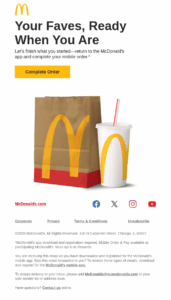
Craft email sequences
A single email isn’t always enough to reach your objective. In some cases, you should engage your audience gradually and keep the conversation going until they’re ready to convert.
This includes occasions where the process is multi-step, the information seems complex, or subscribers need more time to get from point A to point B. That’s when an email sequence makes more sense than a single message.
For example, onboarding users as a feature-rich SaaS platform takes more than one email. First, you’ll need to start with the basics like configuring settings, then create an educational loop to help your audience grasp advanced features and tackle challenging tasks.
Regardless of the unique goal, email follow-ups increase the chances of recipients noticing your emails and keeping your offer top of mind.
Deliver timely campaigns
In triggered emails, timing is of the essence. Send them too early, and you might come across as pushy. Send them too late, and the subscriber will have forgotten all about the trigger event.
So, a website visitor that checks out a product page and leaves should get a reminder after a few hours, not a week later. But to consider a customer disengaged, you have to decide on a longer timeframe (like 30 days or more) to trigger a win-back email.
Triggered emails aren’t the only messages you send to your audience, so it’s important to time automated emails with marketing campaigns when needed. Let’s say you run a flash sale. You might consider excluding people in the onboarding phase from the sale list, as they’ve just converted.
Don’t go overboard
While some triggered campaigns call for an email sequence, brands still need to mind their email frequency to avoid overloading subscribers.
First, make sure you schedule your emails to reach customers at thoughtful intervals. Which means you should space them out by at least one day, or more, depending on the campaign type.
Setting caps on your trigger emails within a specific timeframe lets recipients digest your messages, whereas emails that land one after another in their inbox may cause email fatigue. Which, in turn, results in disengagement, or even worse, unsubscribes and spam complaints.
Test, monitor, and pivot
Spray and pray doesn’t bring results in email marketing, which is why you should always consider A/B testing. Start by creating a second email version that differs in one element. This may be the subject line, sender name, email copy, or send time.
Then, monitor performance to determine which variant performed better and optimize your workflows based on the findings. Make sure to do this process regularly to avoid missing opportunities for conversions.
Also, you need to constantly check email metrics like opens, clicks, conversions, and unsubscribes to measure the effectiveness of your trigger emails. If you find tactics, content, or offers that don’t work, it’s time to pivot and experiment with new strategies.
How to Set Up a Trigger Email with Moosend
You may have the inspiration but lack the time or expertise to create a trigger email. Fear not! Moosend comes with a visual automation builder and an easy-to-navigate interface that lets you create your own email automation templates in a few minutes.
Once you select to build a custom workflow, you’ll land in the builder. Using the left-side menu, you can edit the automation name, check its status, and see a list of all pending tasks.
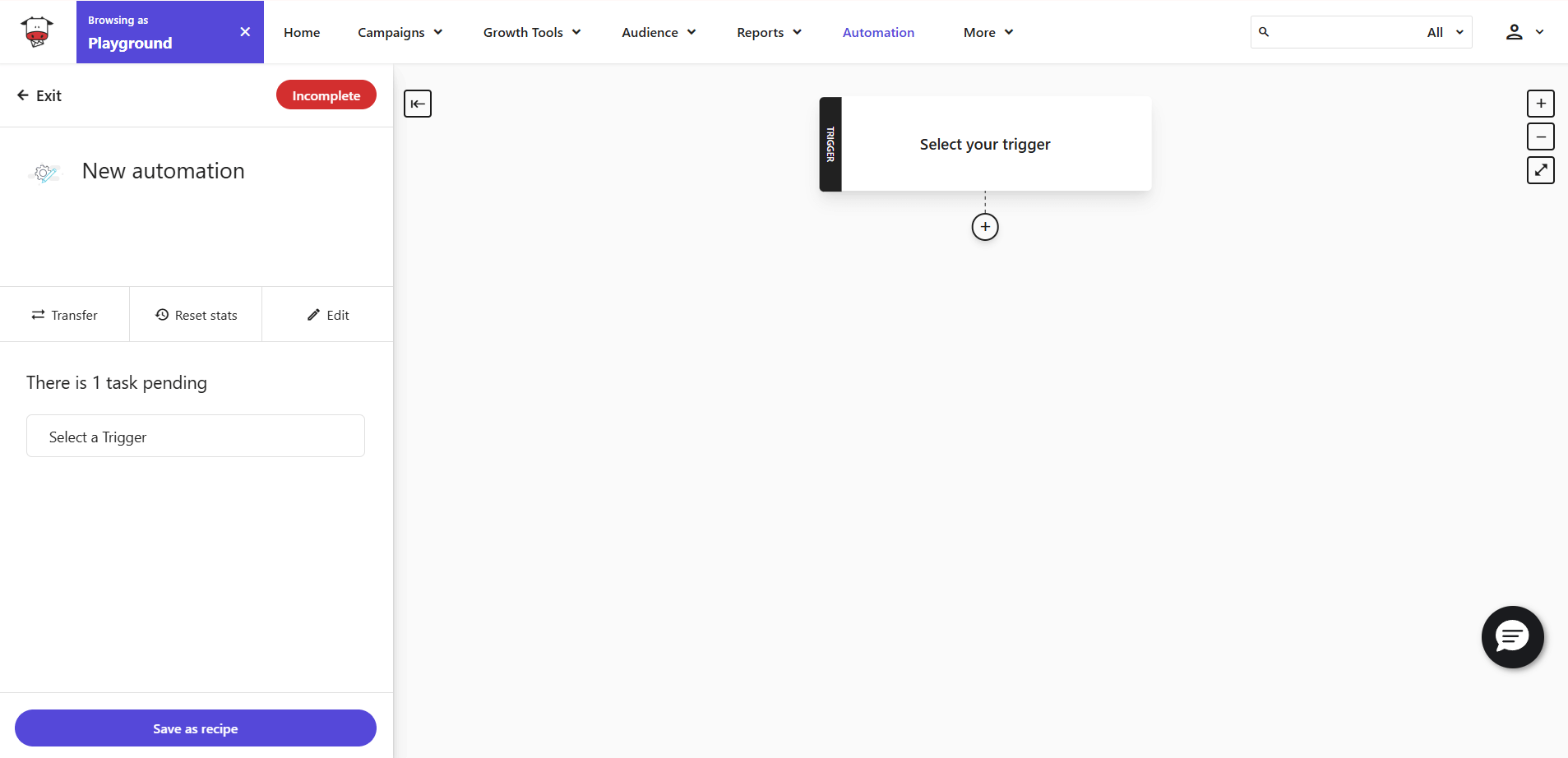
The first step is to set the right trigger, choosing from a variety of interactions on your website, email campaigns, list, and more.
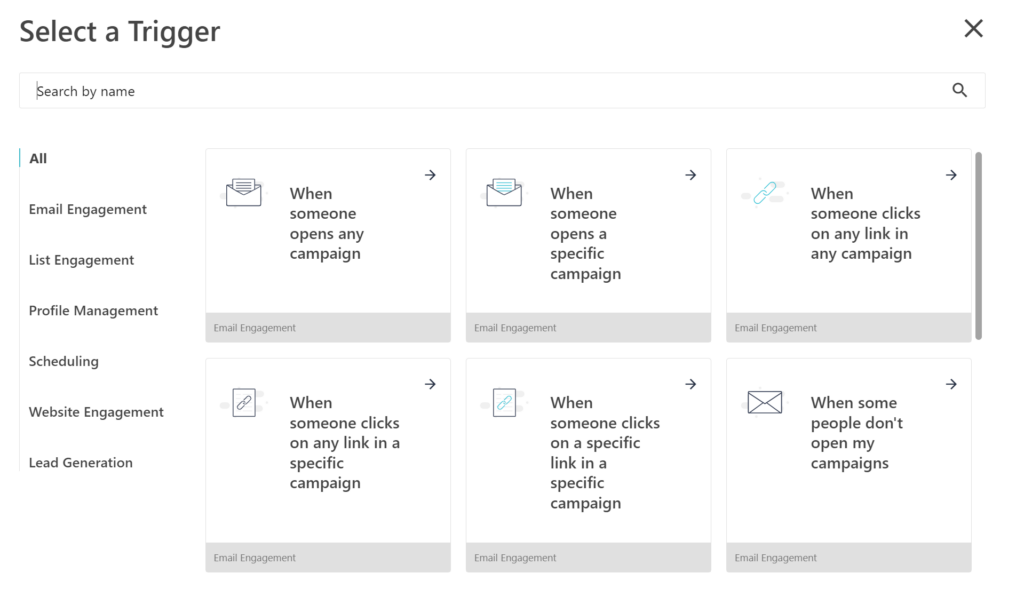
After that, add the conditional steps that control which subscribers will receive your emails and when. For instance, you can choose to break up your workflow and display different content based on the weather conditions in the recipient’s location.
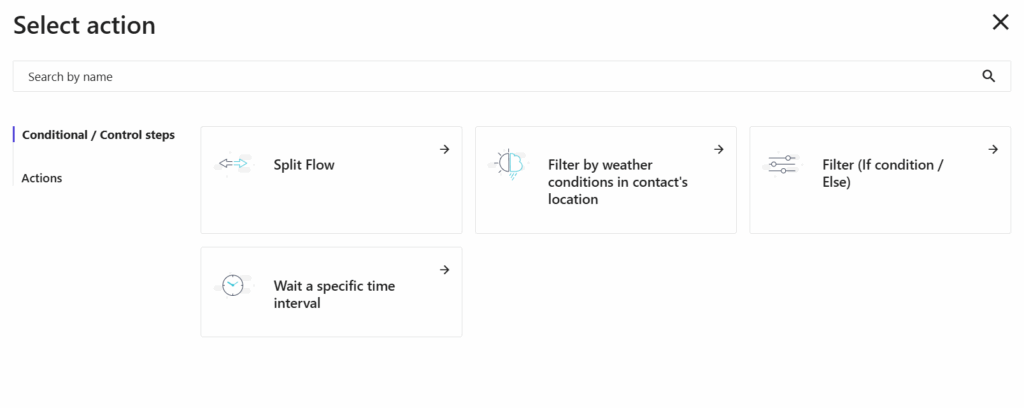
Then, it’s time to define the action you want to take. These include (among others):
- Sending email campaign
- Adding member tags
- Triggering another automation
When you choose the “Send email campaign,” you can either use the text editor or the HTML editor. In the second case, you have the option to visit the template library and choose one of the predesigned layouts as the foundation of your campaign.
Here’s an email automation template example we created using Moosend’s automation designer:
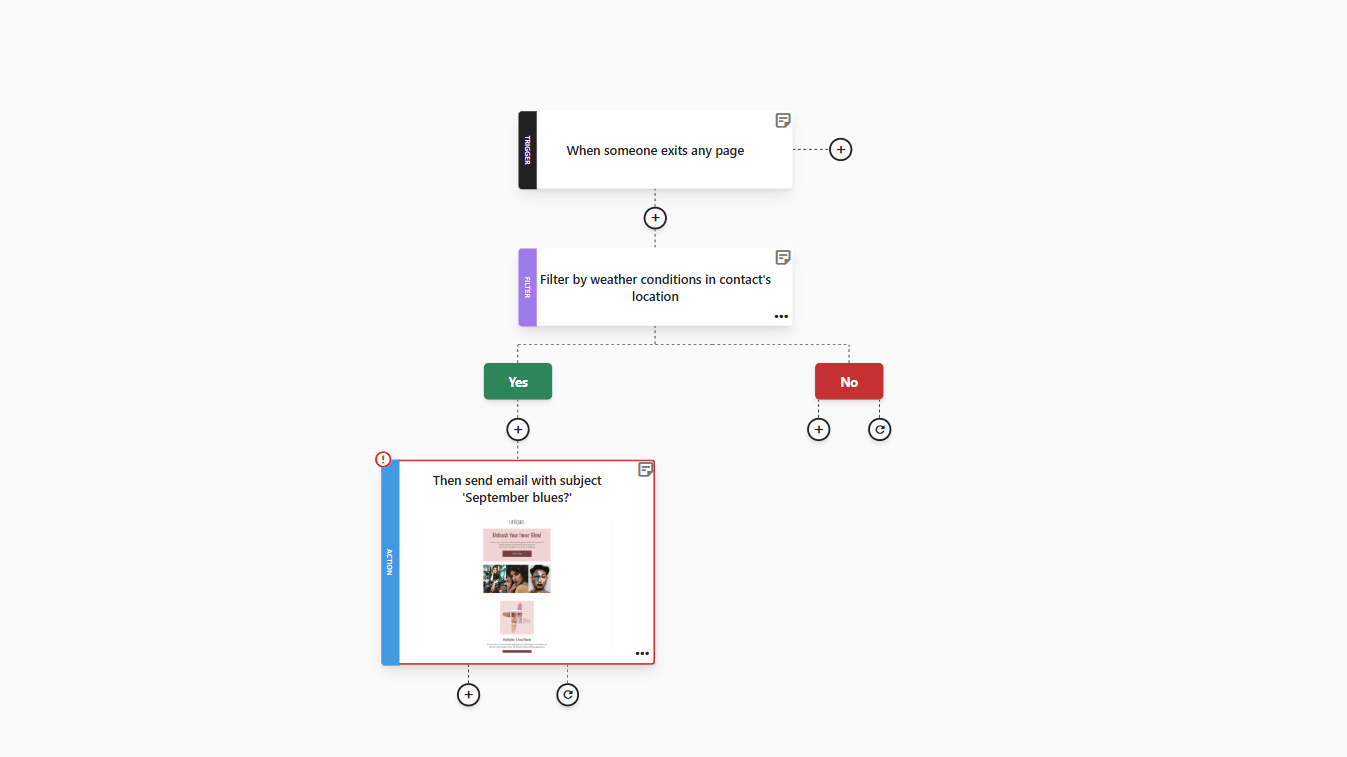
You can edit it by adding or removing triggers, duplicating or deleting steps, or including notes for seamless collaboration with other team members.
Does it look exactly like you wanted? Then, you can save it as a recipe so it’s ready to use for future campaigns.
In case you don’t want to start from scratch, just select one of the platform’s built-in automation recipes for every occasion and tweak it as you please.
All you need to do is sign up for a Moosend account and you’ll instantly access ready-made automation recipes, the flexible builder, A/B testing, and email preview features.
Trigger Conversions with Minimum Effort
Your customers don’t need more emails, they need the right ones. Meaning messages delivered at the perfect moment they can’t say no to. That’s exactly what triggered emails do.
By responding to each customer with content that meets their needs in real-time, every conversion feels like the next logical step, not a hard sale.
Of course, inspiration and effective strategies are just the starting point, as a reliable email automation tool is what will put your ideas in motion.
From there, you can build, monitor, and refine your workflows effectively while freeing up time to dive deeper into what drives your audience, when their interest shifts, and how to stay ahead.
FAQs
Let’s review some frequently asked questions about trigger emails:
1. What do you need to automate your emails effectively?
You should have an email automation platform with a user-friendly email and automation builder to design your campaigns. It should also offer ready-made workflows, email reporting, A/B testing, plus excellent deliverability and support. Look for a wide list of integrations, so you can combine data from other sources like your CRM or social media.
2. How can you ensure that trigger emails and regular campaigns won’t overlap?
If you send other campaign types like newsletters or seasonal deals, carefully plan when they land in inboxes and who receives them. For example, a subscriber shouldn’t receive both a cart abandonment email and a newsletter within an hour. Create an email hierarchy, set proper caps and intervals, and consider segmenting certain subscribers out of some regular campaigns to avoid email fatigue.
3. Why do you need to audit automated campaigns?
Brands should audit their automated workflows to catch bottlenecks before they turn into revenue leaks. Make sure that your segmentation, triggers, and messaging are still on point. Regular audits also help you keep trigger emails up to date with industry trends, consumer preferences, or changes in your branding.
4. What’s the right audit cadence for your workflows?
For most campaigns, a biannual audit cadence works fine. But you could consider quarterly audits for campaigns with ongoing promotions. You must also check how your campaigns are performing outside the regular cadence if needed; for instance, in case of spikes in spam complaints and unsubscribes or technical issues like broken links.
The new year is here, but some ads from 2025 still live rent-free in our heads.
As the holiday mood gives way to routine, some campaigns continue to shine, proving that great storytelling transcends the calendar.
Last year gave us ads that made us laugh, feel nostalgic, pause for a second, or rethink a brand entirely. So, let’s rewind and revisit the best ad campaigns that made 2025 one to remember.
1. The Most Inspirational Ad Campaign
Ad: No Decision Without Us | World Down Syndrome Day 2025
Following last year’s campaign “Assume That I Can,” World Down Syndrome Day shifts the focus from breaking stereotypes to claiming agency.
The story begins with a young woman with Down syndrome whose parents choose her clothes and ends with her confidently making her own choice. She stands alongside individuals with different disabilities as they raise their fists under the powerful message “No Decision Without Us.”
What sets this year’s spot apart is its broader representation. It shows people with Down syndrome, individuals with visual and hearing impairments, wheelchair users, and people with prosthetic limbs start meaningful conversations about inclusion at work, in public spaces, and in everyday life.
Why it’s successful:
The campaign builds naturally on last year’s message, turning inspiration into empowerment through music. Its storytelling is authentic, emotional, and visually compelling, reminding viewers that true inclusion means participation rather than permission.
2. The Cleverest Collab Ad Campaign
Ad: Meal of Misfortune | Wendy’s x Wednesday
Set on a gloomy, rainy day, Wendy’s ad opens with the Addams Family car pulling up to one of its restaurants.
Wednesday types the receipt on a vintage typewriter, narrating that she’d usually be against this kind of “corporate partnership,” until Wendy’s let her create her own Frosty. The spot ends with her unveiling her custom Frosty and the line, “There’s nothing happy about this meal.”
Why it’s successful:
This is a perfectly executed crossover between Wendy’s and Netflix’s Wednesday series. The campaign combines dark humor with their branding, playing off Jenna Ortega’s cultural impact and Wednesday’s recent popularity. The result is turning a fast-food promo into one of the year’s most entertaining collaborations. Not to mention that both characters share the same pigtails and dry wit, which made the pairing oddly perfect.
3. The Most Empowering Campaign
Ad: So Win | Nike
This is Nike’s first major ad in 27 years. The campaign, dedicated to women in sports, delivers a black-and-white anthem celebrating female athletes who refuse to be limited.
Featuring stars like basketball player Caitlin Clark and runner Sha’Carri Richardson, the spot combines powerful narration that flips a stereotype with Led Zeppelin’s “Whole Lotta Love” playing in the background.
Why it’s successful:
It stands out because it feels genuine rather than promotional. The black-and-white visuals and narration give it real power, while the use of emotion and grit makes the message stick. By focusing on real athletes and moments of resistance, Nike turns “So Win” into a statement about confidence, equality, and owning your voice.
4. The Most Nostalgic Campaign
Ad: Home, But Not Alone | Home Instead
Home Instead leverages holiday nostalgia by bringing back Macaulay Culkin as Kevin, 35 years after Home Alone. In the ad, Kevin is outside wrapping his yard in bubble wrap “to keep mom safe” as she’s getting older, still over-preparing in true Kevin fashion.
He jumps when he spots a figure with a shovel, only to realize it’s Old Man Marley’s granddaughter. The two share a moment that mirrors the original film, and she gently encourages him to talk to his mom about getting help at home.
Why it’s successful:
Viewers get the familiar humor, references, and warmth of Home Alone, while the ad naturally shifts into a conversation about caring for aging parents. It’s heartfelt, familiar, and makes a sensitive topic feel approachable. Plus, Macaulay Culkin reprising his iconic role as Kevin is always a crowd-pleaser.
5. The Most Entertaining Super Bowl Spot
Ad: Seal & Becky G | Mountain Dew
Mountain Dew brought pure fun to the Super Bowl with a quirky ad starring Becky G and Seal. After taking a sip of Mountain Dew Baja Blast, Becky falls into a tropical world where she lands on a boat and finds Seal performing a parody of “Kiss from a Rose,” now “Kiss from a Lime.”
The result is a playful combo of color, music, and humor that perfectly captures the brand’s bold energy.
Why it’s successful:
This ad campaign stands out because it embraces the bizarre. With surreal visuals, playful humor, and a nod to the over-the-top style once made famous by Old Spice, Mountain Dew doesn’t try to make sense, and that’s exactly why it works. By leaning fully into absurdity and pop nostalgia, it created one of the most memorable and talked-about Super Bowl spots of the year.
6. The Most Thought-Provoking Ad Campaign
Ad: Beep (starring Ambika Mod) | Make My Money Matter
This ad campaign by Make My Money Matter turns a simple card tap into something quite unusual. Each “beep” sets a plant on fire, showing how everyday banking choices can fuel environmental destruction.
British actress and comedian Ambika Mod plays a cashier processing payments as flames spread around her. The spot closes with the line: “Our planet is burning, and our banks are fuelling the fire,” calling people to act now.
Why it’s successful:
It’s bold, unsettling, and straight to the point. By showing the hidden cost of our financial habits, Beep makes climate responsibility personal. Instead of relying on performative messaging, this ad puts real change front and center.
7. The Most Shocking Public Safety Ad
Ad: Blood on Your Hands | RSA (Road Safety Authority)
The RSA returned to hard-hitting storytelling with “Blood on Your Hands” to remind people that drunk driving doesn’t just affect one person but implicates everyone who stays silent.
The ad follows a man meeting friends at a local pub, where the night seems ordinary until their hands slowly become stained with blood. When he finally leaves with a friend who is clearly intoxicated, the man watches him drive away as the message “Don’t let your friends drink and drive” appears.
Why it’s successful:
The ad above is simple yet brutally effective, leaving some viewers with shivers running down their spines. The realism and slow pacing make it feel heavier, reflecting the shock value of early 2000s road safety campaigns. By showing that silence can be just as dangerous as the act itself, the RSA revives a style of advertising that confronts viewers head-on with something shocking and uncomfortably honest.
8. The Most Cinematic Ad
Ad: The Detective | Nespresso
Nespresso’s “The Detective” plays like a mini-movie, with a style reminiscent of an Agatha Christie mystery.
George Clooney returns as the funny coffee-loving detective, joined by Eva Longoria, Camille Cottin, and Kim Go Eun on a luxurious train. The story follows a fun search for missing coffee pods, or “jewels,” employing Clooney’s humor and charm.
Why it’s successful:
Nespresso stands out for turning a simple coffee ad into a full story. The light mystery keeps you hooked, while the beautiful setting and humor make it feel effortless, from start to end. It’s proof that with the right cast and fun twist, even a few missing coffee pods can turn into an enjoyable experience.
9. The Most Gen Z Ad Campaign
Ad: We’re Here | Instacart
Now, Instacart brings together iconic brand mascots like the Pillsbury Doughboy, Mr. Clean, Cheetos’ Chester, and even the Old Spice Guy, all racing toward a family’s home, only to transform into grocery bags at the door.
Just when it seems perfect, the dad asks, “Did you get the milk?” The mom forgot, but Instacart’s cow speeds toward the house in a cart to save the day as the tagline “We’re here” drops.
Why it’s successful:
By mixing classic brand icons with modern humor and fast-paced storytelling, Instacart speaks to Gen Z and older audiences alike. It’s weird, funny, and refreshing, which is everything a modern ad should be to capture the attention of Gen Z.
10. The Most Heartfelt Campaign
Ad: Dream Job | Google
Google’s “Dream Job” follows a man preparing for an interview using Gemini Live on his Pixel phone. As he practices typical interview questions, the ad cuts to moments from his life as a new dad, like feeding his child, comforting her, and teaching her small lessons as she grows up.
The ad shows that these experiences are what truly prepared him for this moment.
Why it’s successful:
This could have easily been another futuristic, tech-driven ad like OpenAI’s “The Intelligence Age.” Instead, Google takes a more thoughtful approach, using AI to highlight human experience rather than overshadow it. By combining everyday moments with technology, it tells a story that feels personal and genuinely relatable.
11. The Funniest Performance
Ad: Five Star Theater: “Slippers” | Amazon
Amazon’s “Five Star Theater” takes real customer reviews and gives them the Hollywood treatment. In “Slippers,” one of many short videos Amazon has released so far, Benedict Cumberbatch delivers a dramatic review of a man who secretly wears his mother’s fuzzy slippers.
The setting perfectly reflects the holidays, and the addition of a pianist in the background, along with his reactions to Cumberbatch’s monologue, makes it even more enjoyable.
Why it’s successful:
It’s clever, absurd, and perfectly self-aware, as reviews should be. By turning something as ordinary as an Amazon review into a dramatic monologue, the campaign celebrates the humor in everyday customer stories. Cumberbatch’s over-the-top delivery also makes it unforgettable and proves that even product reviews can be pure entertainment.
12. The Best “Have a Break” Moment
Ad: KitKat x Formula 1 | The Official Chocolate Bar of F1
KitKat’s spot shows an overworked office employee wandering through a park, glued to his phone and clearly running on empty. As he sits on a bench, a pit-crew team dressed in bright red KitKat suits suddenly appears, just like an F1 box crew.
They take his phone, hand him a KitKat, swap his shoes for comfy slippers, give him a quick massage, and tidy him up before stepping back. In seconds, the man goes from stressed to relaxed as the voiceover reminds us, “Have a break, have a KitKat.”
Why it’s successful:
By pairing Formula 1’s high-speed pit-stop energy with KitKat’s classic “have a break” message, the ad delivers a clever visual joke that works for both F1 fans and everyday viewers. It’s simple, relatable, and a fresh take on a timeless slogan.
13. The Most Unexpectedly Cool Campaign
Ad: New Coca-Cola Zero | Coca-Cola Korea
Coca-Cola’s Zero new ad opens at what feels like a dull outdoor festival, until V from BTS, the globally famous K-pop group, pulls up in the iconic red Coca-Cola truck and says, “Looks like we need something thrilling, right?”
When V presses the red Coca-Cola button inside the truck, the side swings open to reveal a burst of energy: people celebrating with Coke Zero, confetti in the air, lights flashing, and music taking over. The line “Need something thrilling? Try the new Coca-Cola Zero” neatly seals the moment.
Why it’s successful:
It’s a modern twist on a classic formula that resonated far beyond Korea. With BTS’s global influence and Taehyung’s global appeal, the campaign turned a local product launch into a worldwide moment. The use of nostalgia, energy, and modern style captures the spirit of Coca-Cola while proving that great storytelling (and star power) can transcend borders.
New Ad Campaign Inspiration Delivered
Looking back, the best campaigns of 2025 all had one thing in common. They knew exactly what they wanted to say, and they trusted the audience to get it.
Some leaned on nostalgia, others on humor, discomfort, or pure fun. None of them tried too hard to explain themselves. They just told a good story at the right moment, either through humor or honesty.
And maybe that’s why they stuck. Like Kevin finally realizing he doesn’t have to do everything alone, these ads remind us that the simplest ideas often work best when they’re done with care.
If 2025 set the bar, 2026 has some big shoes to fill.
You’ve built your landing page, launched a few campaigns, and seen some results. But have you really found the formula for lasting success?
The truth is, what works today might not work a few months from now. Consumer behavior changes, trends evolve, and so should your campaigns. That’s where landing page split testing comes in to help you discover what resonates with your audience and improve your landing page performance over time.
In this guide, we’ll cover the key landing page elements to test, how to run effective split tests, the do’s and don’ts to follow, and how to analyze your results to make smarter, data-driven decisions.
Bring your landing page idea to life
Use pre-made layouts, add your copy, and launch a page that feels truly yours.
Try MoosendWhat Is Landing Page A/B Testing?
Landing page A/B testing, also called split testing, is the process of comparing two versions of a landing page to see which one performs better.

You can change elements like the headline or call-to-action and split your traffic evenly between the two versions. The one that gets more conversions, clicks, or signups is your winner.
You can also test multiple variations against your original page to explore different ideas at once (multivariate testing).
Why You Should A/B Test Your Landing Pages
The obvious reason is to boost conversions, but that’s just one of the benefits of A/B testing.
Here’s what it can do for you:
- Understand what drives action: A/B testing helps you discover which design, message, or offer resonates most with your audience, i.e., whether it’s strong visuals, clear value, or a sense of urgency. Once you know what works, you can apply those insights to improve future landing pages and campaigns.
- Make data-driven decisions: By analyzing how visitors interact with your landing pages, you can focus your time and budget on strategies that deliver measurable results rather than following generic tips.
- Get more from your existing traffic: A small improvement in conversion rate can turn the same number of visitors into significantly more leads or customers.
- Build a habit of optimization: Continuous testing lets you spot new opportunities, adapt to changing user behavior, and keep improving your results rather than settling for easy wins.
Which Elements to Test on a Landing Page
Not every part of your landing page needs testing. However, some can make or break your results.
Start with the areas that directly affect how visitors read, click, and convert. Also, keep in mind that the tests you run may depend on your landing page type. For instance, a sales page might focus on product features or offer placement, a lead generation page on form fields or lead magnet visuals, and a webinar page on headlines, host details, or registration CTAs.
Before we learn how to run an A/B test, let’s see what elements you can test.
1. Headlines and subheadlines
Your headline is the first thing visitors notice, and it shapes whether they stay or leave. You can test different headline styles. For instance, you can experiment with a benefit-driven, emotional, or question-based one to see which captures attention best.
The same applies to your subheadlines, where you can further clarify or boost your main value proposition. Here, even small wording changes can dramatically impact engagement.
Let’s say you’re promoting a webinar through a landing page:
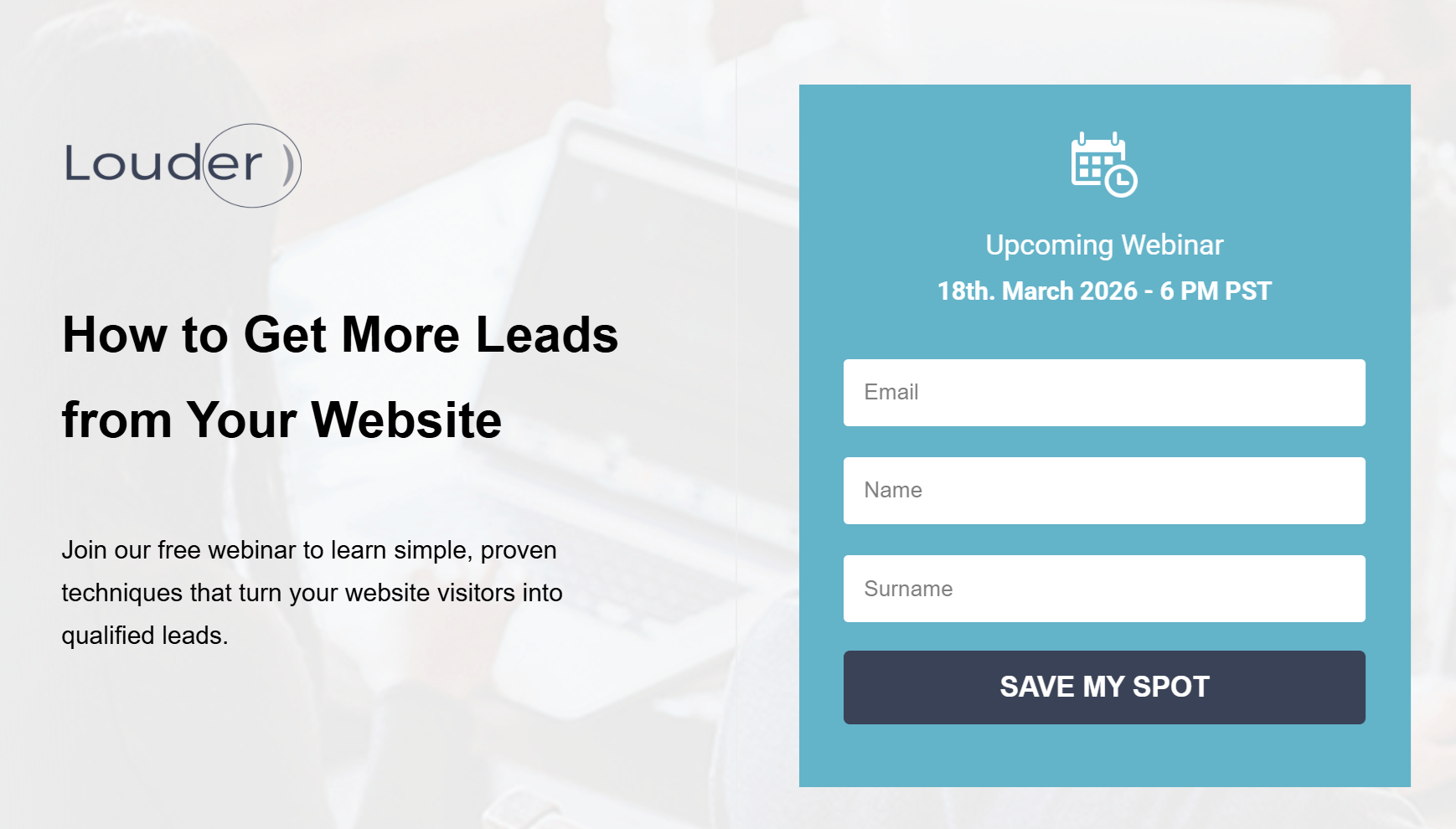
Your original version (control) is simple and clearly states what the webinar is about. This version may appeal to readers who want practical, actionable tips.
Now, let’s see a variation that uses curiosity and promises a specific result.
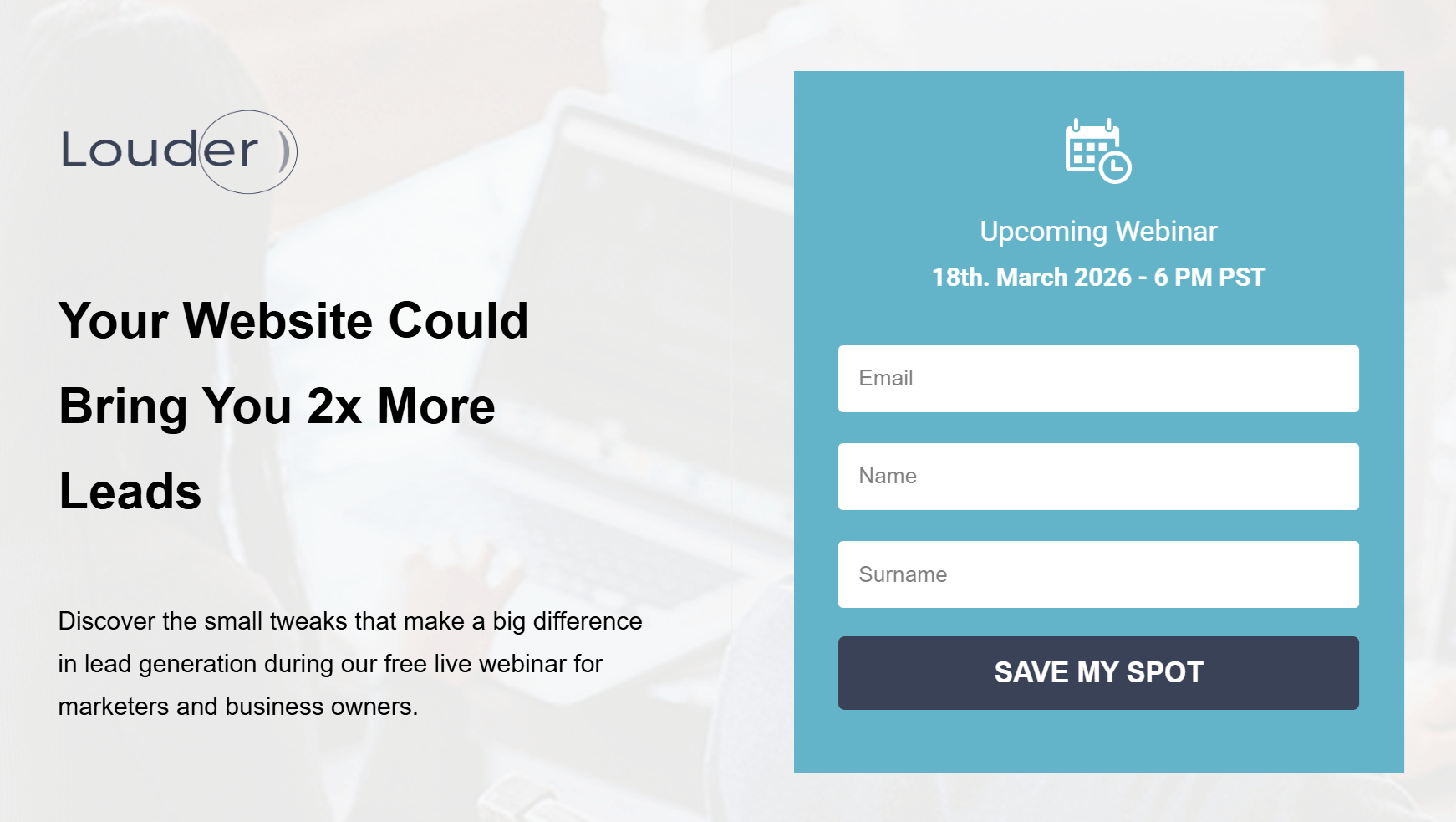
Here, the “2x more leads” claim adds a measurable benefit, while the subheadline provides context and credibility by explaining what the webinar covers and who it’s for.
2. Hero images or videos
Your hero section needs to communicate value instantly. Whether you use a static image or a short video, this area should support your message and harmonize with the rest of your page.
When A/B testing, you can experiment with:
- Image type: Try a product image versus a photo of someone using the product to see which creates a stronger connection.
- Video vs. image: Test a short explainer video that adds motion and context against a static image to measure engagement. Keep in mind that videos can affect page load speed.
- Tone and color: Compare bold visuals that grab attention with more minimal designs to see what keeps your audience engaged.
For example, your variant page could feature a short video of a marketer sharing how your product or your tips helped them achieve a goal.
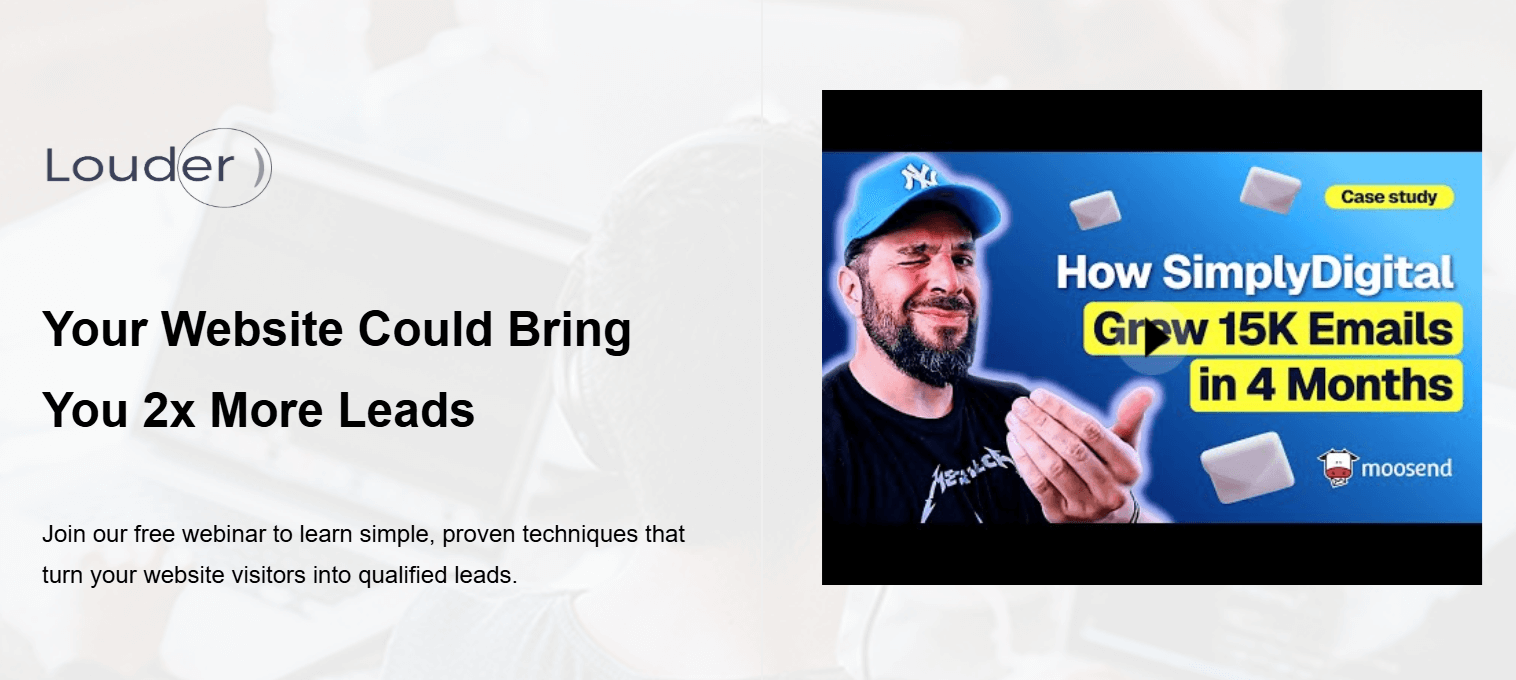
This kind of authentic, experience-based visual can make your event feel more credible and relatable, especially for new visitors deciding whether to register.
Overall, testing visual elements on your pages will help you discover which format tells your story best and leads visitors to click through.
3. Landing page forms
Your form is where visitors decide whether to take the next step, so finding the right combination of elements is key to getting them to click.
You can test the number of fields, their order, or where the form appears on the page. For example, a shorter form above the fold might attract quick signups, while a slightly longer one placed lower could bring in more qualified leads.
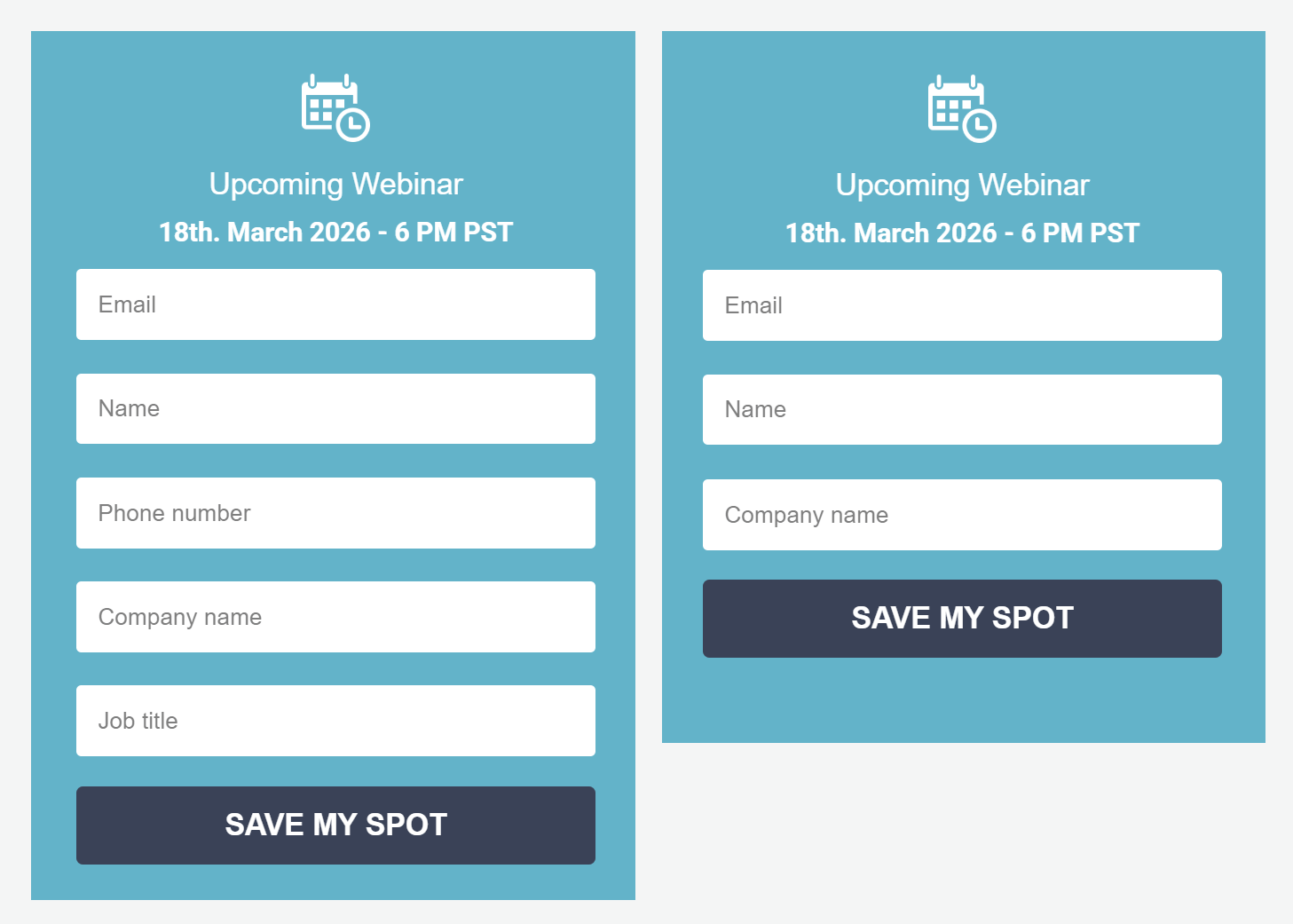
Once you’ve optimized your form fields, the next step is your CTA button.
4. CTA buttons
Without a strong call-to-action, your form won’t capture new leads. To get the best results, you can test variations in color, wording, and placement to see what draws attention and encourages clicks.
In this example, imagine testing two versions of the same landing page:
- Version A: A dark blue “Save My Spot” button that blends naturally with the design.
- Version B: A brighter, pink button with the exact text.
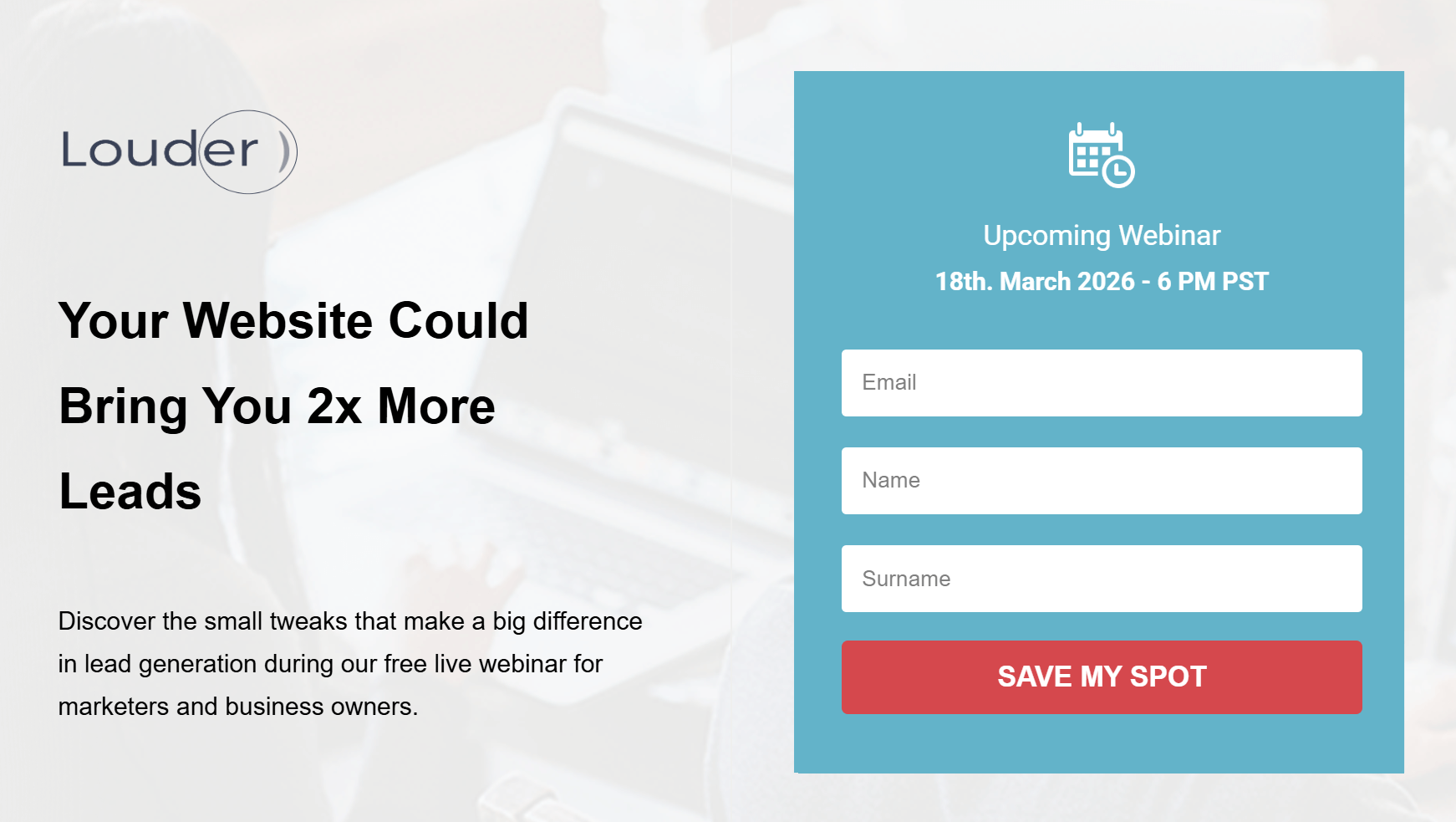
While both are functional, Version B might outperform simply because it stands out more, guiding the visitor’s eye and creating a sense of urgency. The key is to ensure your button contrasts enough to be noticed but still fits your brand’s look and feel.
Tip: Once you’ve nailed the color, experiment with button copy like “Join Free,” “Reserve My Seat,” or “Get Instant Access” to see what language motivates your audience most.
5. Landing page copy
Testing your landing page copy helps you identify the tone, structure, and value proposition that resonates most with your audience.
Even small wording changes, like switching from “Start your free trial” to “Try it free for 30 days,” can shift how users perceive value, urgency, and credibility. Focus on highlighting what makes your offer unique and why it matters to your audience.
Here are some aspects to consider:
- Tone: Conversational vs professional.
- Focus: Benefit-driven copy vs feature-heavy descriptions.
- Length: Short, punchy text vs longer, explanatory copy.
- Value proposition: Emphasizing savings vs results.
For example, your Version A might use straightforward copy that explains what attendees will learn in a sort of “bullet” format.
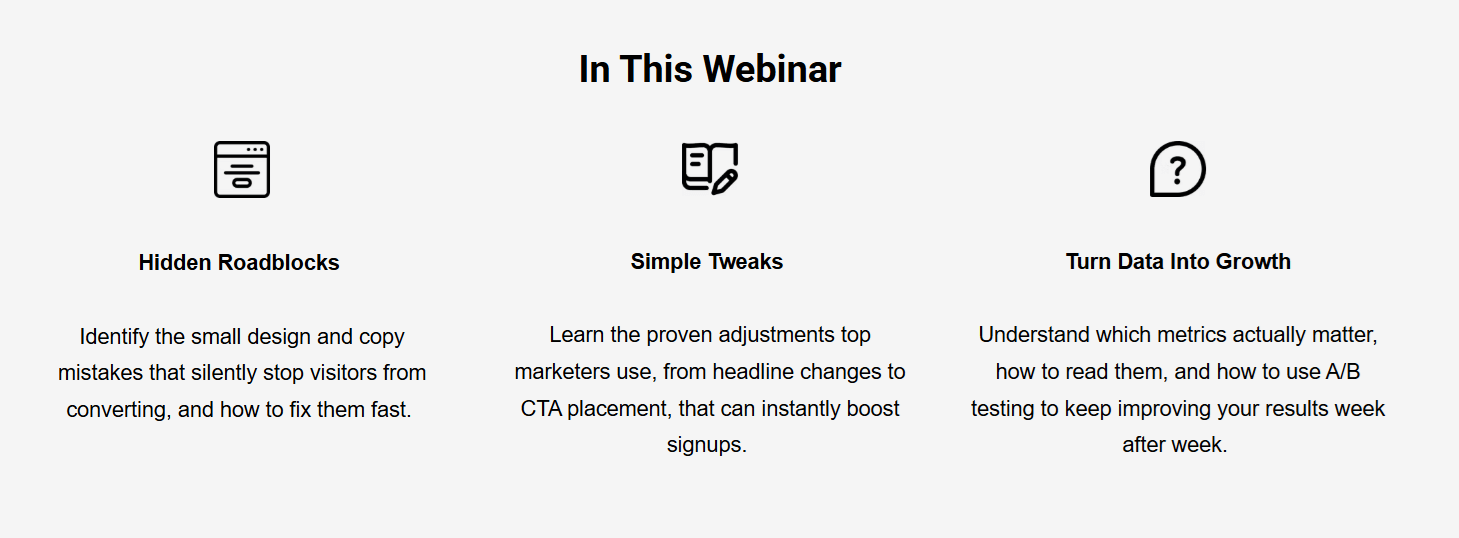
Your Version B, on the other hand, can focus on transformation and results. For example, “Get the proven framework to turn your website into a 24/7 lead-generating machine,” etc.
6. Countdown timers
Countdown timers can add a sense of urgency to your landing page, especially for webinars, product launches, or limited-time offers. When used correctly, they encourage visitors to act before time runs out.
Below, the countdown shows how much time is left until the webinar starts.
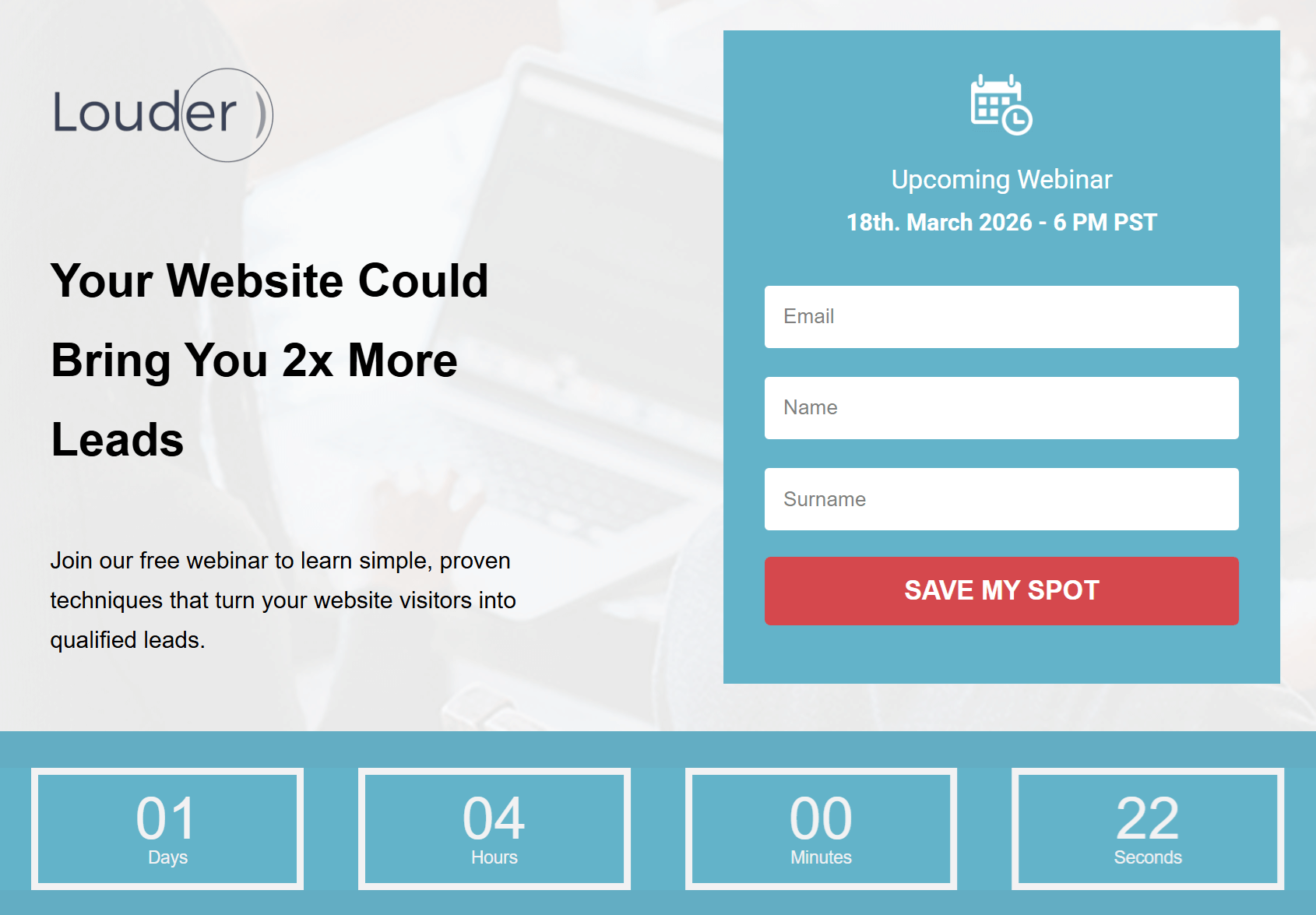
During your A/B test, you could create:
- Version A without a timer. Instead, the page focuses only on the form and event details.
- Version B with a visible timer right below the headline.
The one with the timer might lead to more signups because it highlights scarcity and motivates quicker decisions.
Tip: If you’re using countdowns for recurring events, set them to reset automatically to avoid fake urgency.
7. Social proof
Visitors are more likely to trust your offer when they see what others have already gained from you. Adding social proof, such as testimonials, reviews, or logos of past clients, can strengthen your value proposition and reduce hesitation.
For instance, you could test two versions of your landing page: one focused solely on the webinar details and form, and another with short testimonials from past attendees.
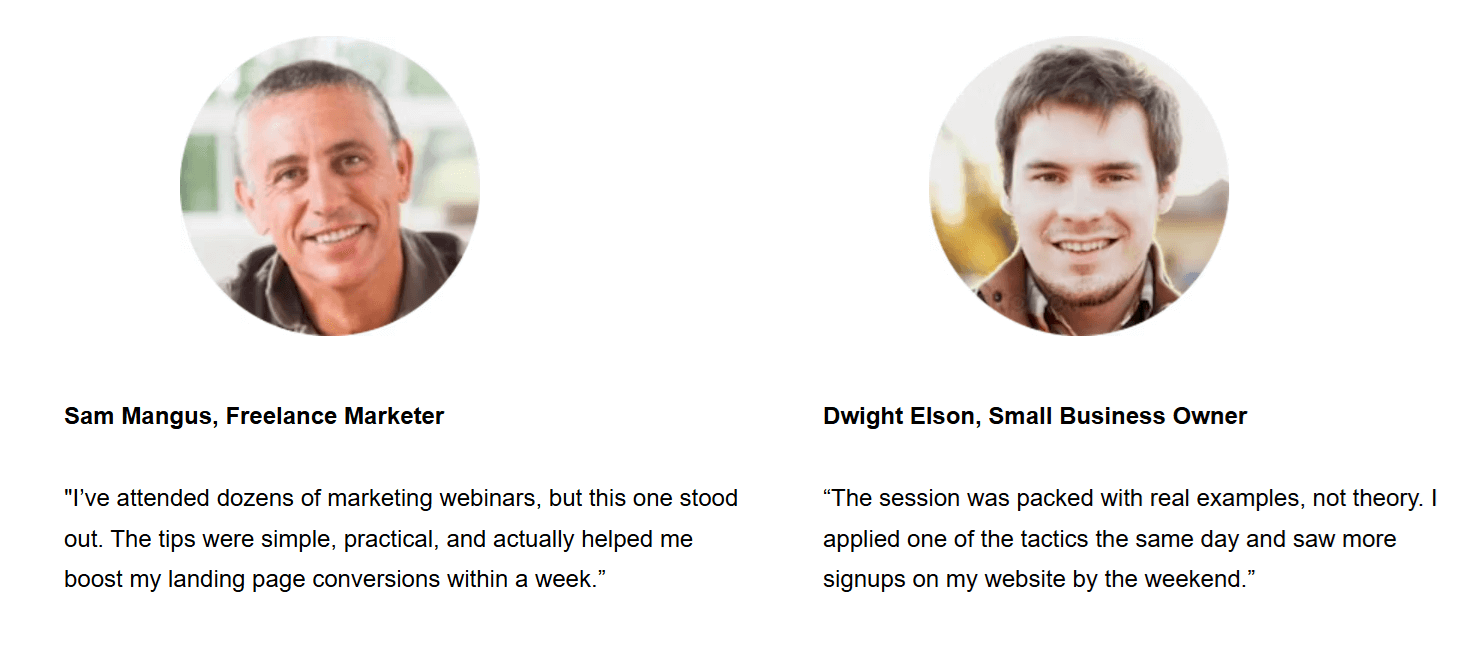
The second version may perform better because it builds credibility and makes the outcome attainable.
8. Layout and navigation
Your layout guides visitors through your page and shapes how easily they find key information. A clear, focused design keeps attention on your offer and CTA.
Here, you can test:
- Page length: A short, minimal page vs a longer one with detailed sections and testimonials.
- Section order: Placing the form above the fold vs after the benefits section.
- Visual hierarchy: Headline-first layouts vs image-led designs.
- Navigation: Single-scroll landing pages vs those with anchor links or sticky menus.
For example, a more extended version of your webinar page might build trust with added speaker bios and FAQs, while a shorter one could boost signups by reducing distractions.
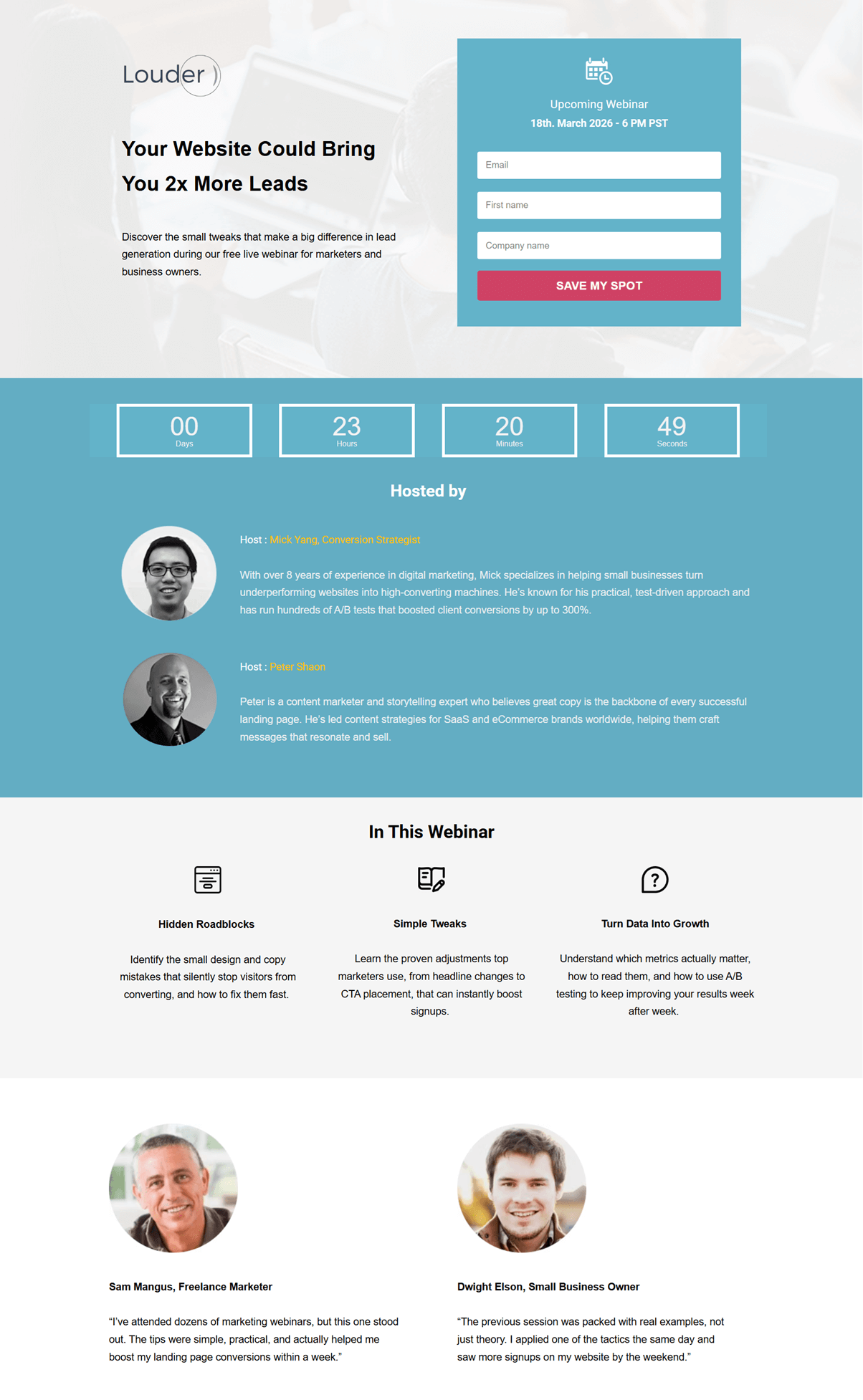
Testing both reveals which structure best fits your audience’s decision-making style. And remember, every audience is different. What works for another brand might not work for yours.
How to Run a Landing Page A/B Test Step-by-Step
Consistently improving your conversion rate depends on following a clear, structured strategy for your A/B tests. While each platform has its own process, the core steps remain the same:
Step#1: Set a clear goal
Start by defining exactly what you want this test to achieve. Your goal should be specific and measurable so you can easily compare the performance of Version A and Version B. This could be increasing webinar signups, getting more demo requests, boosting purchases, or encouraging visitors to download a lead magnet.
Pick one primary goal and make sure the element you plan to test directly supports it. This will help you stay focused and avoid running tests that don’t move the metric that matters most.
Step#2: Make your A/B test hypothesis
Before launching your test, create a clear hypothesis. This brief statement explains the change you’re making and the outcome you expect. A good hypothesis connects your goal to a specific element on your page.
For example, you might say: “Changing the CTA button color from blue to pink will increase webinar signups by at least 10%.”
This keeps your test focused and gives you a measurable target to evaluate after the experiment. We’ll use statistical significance later to confirm whether your hypothesis was correct. For now, the goal is simply to define what you expect and why.
Step#3: Choose what element to test
Now that you’ve defined your hypothesis, it’s time to choose the specific element you’ll change to test it. Since you already know what you want to improve (clicks, conversions, etc.), start by selecting the element that directly supports your hypothesis.
For example, if your goal is clarity, test your headline. If you want to boost engagement, focus on your CTA button. And if you’re trying to reduce friction, start with your form.
As a rule of thumb, test one element at a time. However, you can test two closely related elements together when they function as a single unit. Here are some combinations to consider:
- Headline & subheadline: Ideal for testing new angles or supporting your value proposition.
- CTA button color & CTA copy: Works well if you’re experimenting with a stronger action prompt.
- Form fields & form title: Useful when improving the signup flow.
- Hero image & headline placement: Helpful when testing how layout affects attention.
Just make sure these combinations stay tightly connected to your hypothesis so your results remain clear and meaningful.
Step#4: Create your variations and split your traffic evenly
With your element selected, you can now use your landing page builder to create your landing page variations.
- Version A (control): Your current landing page.
- Version B (variation): The same page with the single change you’re testing.
Keep everything else identical—layout, copy, visuals, and timing—so the results reflect the impact of that one change.
Once your versions are ready, split your traffic evenly between them. Most A/B testing tools handle this automatically, routing 50% of visitors to each version. If you’re testing manually, make sure both versions are shared with audiences of similar size and behavior so the comparison stays fair.
Even traffic distribution ensures both pages compete under the same conditions, giving you trustworthy results. If one version receives more or higher-quality visitors, your test will skew, and the winner won’t be reliable.
Step#5: Determine the ideal test duration
How long your A/B test should run depends on factors like traffic volume, conversion rate, and how quickly you can collect reliable data.
As a general benchmark, AB Tasty suggests that most tests need around two weeks to gather enough activity for meaningful results. This gives both versions enough exposure and helps capture natural fluctuations in user behavior across different days.
Another approach, recommended by Invesp, is to calculate your minimum sample size based on your expected improvement and daily traffic. Once you know the sample size, you can estimate how long your test needs to run using this formula:
Expected experiment duration = sample size ÷ people visiting the tested page (daily)
Even if you reach your sample size sooner than expected, avoid stopping early. Running your test for at least two weeks and no more than four ensures your results are representative and not influenced by short-term spikes, seasonal effects, or campaign-specific traffic.
This balanced timeframe helps you gather stable data and gives both page versions a fair chance to perform under real conditions.
Step#6: Analyze and interpret your test results
After your test has run for the appropriate time and collected sufficient data, you can start evaluating how each version performed. Begin with the core metrics that show how visitors interacted with your landing page:
- Conversion rate: The percentage of visitors who completed your goal (e.g., signed up for a webinar or your newsletter, or made a purchase).
- Click-through rate (CTR): How many users clicked your CTA or key link.
- Bounce rate: The percentage of users who left without taking action.
- Time on page: How long visitors stayed before converting or leaving.
These metrics tell you which variation performed better on the surface. To confirm whether the difference is meaningful, check for statistical significance, which shows whether your results are real or just random, using your p-value:
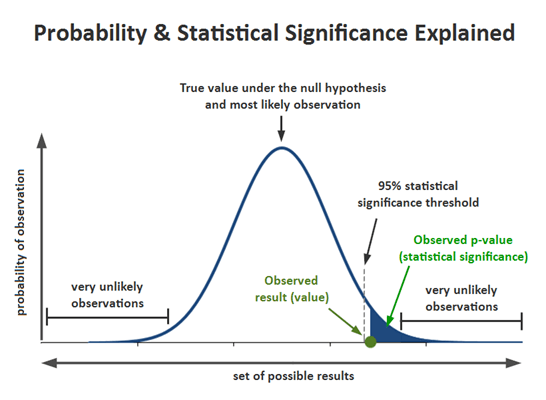
Most marketers consider a test significant when the p-value (probability) is 0.05 or lower, meaning there’s a 95% chance the winning variation truly performs better.
- If p ≤ 0.05: The difference is statistically significant, meaning your winning version likely performs better in reality.
- If p > 0.05: The result isn’t strong enough to declare a true winner and may be due to chance.
For example, if your variation improved webinar signups from 12% to 15% and the p-value is below 0.05, you can be confident this uplift is meaningful and not just a one-off spike. If the p-value is higher, the increase might look promising, but it isn’t reliable enough to roll out yet.
Most platforms and A/B testing tools, such as VWO and Optimizely, automatically find the value. If you’re curious about how it works, though, here’s the basic logic behind the p-value:
- Set your null hypothesis (H₀): No difference between Version A and Version B.
- Set your alternative hypothesis (H₁): One version performs better.
- Collect your data: Visitors and conversions for both versions.
- Run a z-test or use an A/B testing calculator to generate your p-value.
Again, before finalizing your decision, make sure your test has run for at least two weeks and reached its minimum sample size. Even if the results are inconclusive, your data can still reveal patterns, highlight friction points, and inspire your next round of testing.
Do’s and Don’ts of Landing Page Split Testing
To get reliable results from your A/B tests, you need a structured approach. Following a few best practices can help you avoid common pitfalls that’ll waste valuable time, data, and resources.
Do’s
- Test one element at a time: Focus on a single change like your headline, CTA, or form length so you can clearly identify what caused the performance difference.
- Define clear hypotheses: Start every test with a statement you can measure, such as “Adding testimonials will increase signups by 10%.” This keeps your experiment focused and purposeful.
- Use reliable data and proper tools: Leverage platforms that provide accurate traffic distribution, significance tracking, and device segmentation. Reliable data is key to making confident decisions.
- Let tests run long enough: Stop only after reaching your target sample size and statistical significance (usually p ≤ 0.05). Running tests for at least one to two weeks ensures you capture different visitor behaviors across days.
- Prioritize mobile experience: Since a large portion of users browse on mobile, always test and review your variations across devices to avoid misleading desktop-only results.
Don’ts
- Rely on small data sets: Drawing conclusions from too little traffic leads to false positives. Wait until your test collects enough conversions per variation before declaring a winner.
- Assume correlation equals causation: Just because conversions increased doesn’t mean your change caused it. Always confirm significance with statistical testing and contextual analysis.
- Forget to test user segments: Different audiences behave differently. A variation that wins with new visitors may not perform as well with returning users or mobile traffic.
- End a test too early: A sudden spike doesn’t mean you’ve found your winner. Stopping early can lead to unreliable or misleading outcomes.
Setting up a Landing Page with Moosend
Even though Moosend’s landing page builder doesn’t currently include built-in A/B testing functionality, you can still create, customize, and optimize pages directly from your account using the intuitive drag-and-drop editor.
If you’re a beginner, you can use the tool to familiarize yourself with landing page creation. All you need to do is sign up for a Moosend account and then:
- Click on Growth Tools and select Landing Pages
- Create a new landing page from the New button on the top right side
- Set the basic settings and design your page through the drag-and-drop builder
- Choose how to track your conversions and enable cookie consent
- Select the “Publishing method” and finally “Publish” your landing page
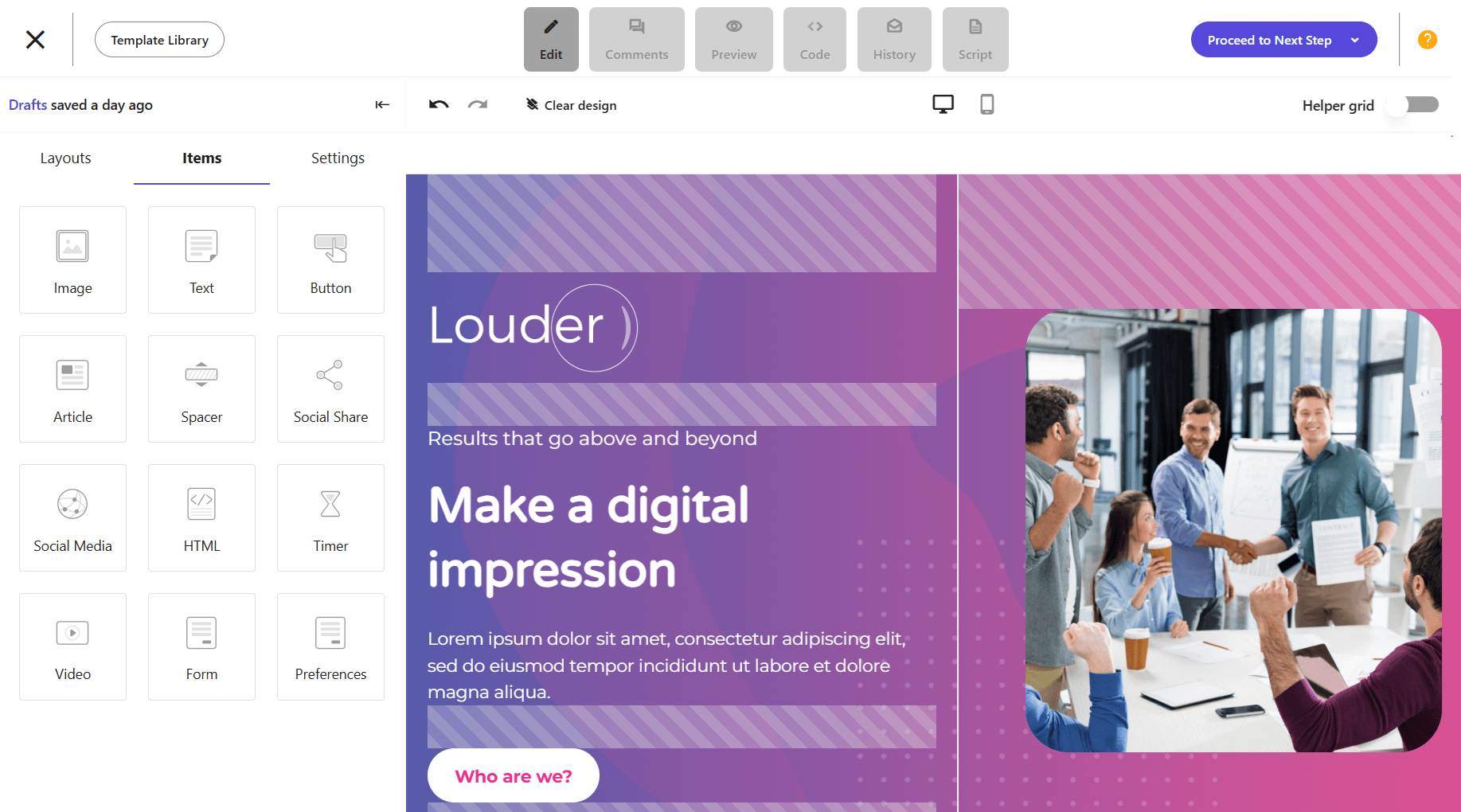
Even without dedicated tools, you can simulate A/B testing by creating two variations of the same landing page. Then, share them with different audience segments, and use Moosend’s reporting tools to see which one drives more conversions.
This is the simplest way to perform a pseudo-test with the tools you already have.
A/B Testing One Landing Page at a Time
A/B testing is a continuous process that takes time to set up, run, and analyze, but it’s worth it. Audiences change, trends shift, and what worked last quarter might not perform as well today. Testing regularly helps you stay proactive, allowing you to improve your landing pages before performance drops.
Each test brings you closer to understanding your audience’s behavior and preferences. And remember, the goal isn’t to find a single “perfect” version, but to keep learning more about your audience and implementing what you learn to keep your business thriving.
FAQs
Below, let’s see some common questions regarding landing page split testing.
1. What is an A/B test hypothesis?
An A/B test hypothesis is a clear statement that predicts how a specific change will impact user behavior or conversions. For example, if you change your headline from “Join Our Free Webinar” to “Learn How to Double Your Leads in 30 Minutes,” your hypothesis could be that the new, benefit-driven headline will increase signups by 15%.
2. What is statistical significance?
Statistical significance shows whether your A/B test results are reliable or happened by chance. A test is usually considered statistically significant when the p-value is 0.05 or lower, meaning there’s a 95% chance your variation actually performs better.
3. What affects your A/B test p-value?
Several factors influence your p-value, including sample size, differences in conversion rates, and traffic quality. Running your test long enough and gathering enough data helps ensure your p-value reflects a true difference, not random variation.
4. What is an A/A test?
An A/A test compares two identical versions of a page to check that your testing setup works correctly. Since both versions are the same, the results should be nearly identical. If they aren’t, it’s a sign something’s off with your tracking, traffic split, or analytics setup before you move on to real A/B testing.
Many creators and business owners struggle with email list growth, often resorting to generic lead generation tactics that fail to capture attention.
But what if you could offer a valuable and fun experience that not only converts new leads but also makes existing subscribers look forward to your emails every single day? Email challenges are made just for that.
This guide will show you exactly how to create a high-converting email challenge, including the best planning practices and real-world examples you need to achieve your business goals.
Inbox, we have a challenge
Get Moosend’s pre-made workflows and email templates at a low cost.
Start freeWhat is an Email Challenge?
An email challenge is a marketing strategy that involves delivering a series of action-oriented or educational emails to people who’ve subscribed to receive this content. It’s a powerful lead magnet and engagement tool where a marketer guides participants through a process over a set period to achieve a specific, tangible goal.
For instance:
- A yoga instructor can create a 30-day challenge with short programs to help participants boost their well-being goals.
- A food blogger can host a 7-Day Meal Prep Challenge during back-to-school season to grow their list.
Apart from list building and audience engagement, the hosts can also promote relevant products and services to boost their business, from books and courses to affiliate links.
Why You Should Launch Email Challenges
Here are some of the main benefits of running email marketing challenges to help you decide if it’s an appropriate strategy for your business:
- Grow your email list: Apart from gaining new subscribers, you ensure these people are highly interested in your offers and less likely to unsubscribe.
- Engage your existing audience: Email challenges bring value to your current subscribers and help revive your relationships with contacts who have started to disengage.
- Promote relevant offers: Participants are more likely to consider purchasing your products or services if they see them as a natural part of the challenge experience.
- Improve your sender reputation: Since participants have specifically chosen to receive this content, they’re highly likely to engage with it, which boosts your sender reputation and email deliverability.
- Build trust through expertise: Providing immediate, actionable value will help subscribers view you as a leading expert in your niche and show more trust in your future recommendations.
But how can you reap all those benefits? You need to build a dedicated email marketing strategy that will secure high open rates and conversions.
Best Practices for Converting Email Challenges
Follow this step-by-step guide to streamline your email challenge effectively.
1. Create an email marketing plan
A great strategy starts with clarity, especially in goal-setting. Asking yourself these questions can point you in the right direction:
- What do you want to achieve through the email challenge, apart from list growth?
- Will your email campaigns be content-based, or do you also plan to promote specific services or products?
- Are you targeting a specific audience segment?
- What tools will you need to implement this, except for an Email Service Provider (ESP)?
Once the email content and calls-to-action (CTAs) become clearer, determine how much time participants will need to execute the challenge, and add it to your email marketing calendar. Sit down with your team to create a dedicated marketing plan and allocate different tasks. Then, decide how much time you can invest and pick the optimal duration for the challenge based on your goals.
Next, consider whether personalized content will help achieve your goals faster. While a bulk email is often enough, you can use customer segmentation or dynamic content to send targeted challenge emails and create a sense of exclusivity.
Moreover, choose if you prefer an evergreen or a limited-time email challenge. In the first option, people join at their convenience, but if you want to instill urgency, the second option is more suitable.
2. Choose the right challenge for your audience
In addition to setting the best goals for your business, you should follow the same process for your target audience. To get them to sign up for your email challenge, you should focus on delivering the highest possible value.
First, research where you can find the winning topic. You can start by reviewing your own data. Check out your analytics to see which subjects have the most traction. Use data from high-performing blog posts, previous successful newsletters, social media engagement statistics, and lead magnets that performed well.
Also, leverage current trends in your niche, but ensure you offer a fresh angle to stand out from the competition. Seasonal themes, such as back-to-school organization or holiday dinner prep, often convert well if they offer a unique solution.
Interested in people’s opinions before investing in this project? Use social media (like Instagram Stories or Facebook) or send out a quick survey via email to ask followers what type of challenge they’d prefer to join.
Moreover, if you have an ongoing feedback stream with loyal customers or influential accounts, ask them what specific challenge they would follow and pay attention to their needs.
3. Craft your email challenge content
Once your plan is ready, move on to the creative part. Find the best way to deliver high-quality content to your audience without wearing them out or boring them, especially if the challenge lasts more than one week, as your contacts might get distracted along the way.
Starting with the subject line, make sure each email begins with the day of the challenge and clearly introduces the topic to boost open rates.
Here’s an example from Better Brand that sets the tone.
Subject line: Challenge #4 – A Random Act Of Kindness

People generally don’t spend much time reading a single email, no matter how invested they feel in a challenge. Find the right balance between text and visuals in each email, as Better Brand did to boost campaign performance. You can also add interactive content, such as quizzes, short videos, or downloadable checklists, to make the process more engaging and hands-on.
Empower participants to keep up the challenge despite the potential difficulty. For instance, if you’re delivering a mindfulness challenge, start with simpler exercises and acknowledge how hard it can be to stay in the present moment.
Finally, avoid overtly salesy language when promoting relevant products or services. Participants opted in for a different reason and might get confused. Instead, share how these paid offers can help them sustain their progress beyond the challenge.
4. Prepare additional challenge resources
While some marketers use existing content for these challenges, others prefer to craft fresh resources for this cause. From exclusive videos to podcasts or tutorials, they choose to offer a rich experience that doesn’t feel familiar.
Understandably, it can be challenging to craft all that content from scratch. This is where repurposing your existing content and packaging it in a unique way becomes highly valuable.
Here are two practical content scenarios:
- The Knitting Challenge: Create a simple 7-day challenge where subscribers learn one small technique each day. You can take instructions from your blog posts, tweak them, and create short, exclusive video tutorials using that copy as a script. This adds a valuable new format without starting from zero.
- The Leadership Challenge: Train new leaders on essential skills to prepare them for their new role. You can turn existing podcasts into a newsletter series featuring key quotes, actionable summaries, and links to the full episode for those who want more.
It’s up to you to decide the perfect content format for your audience based on available tools, time, and other resources. Combine data from your analytics tools to find what works best for your audience and drives the most engagement.
5. Design your emails for consistency and conversion
Apart from a consistent subject line that secures a high open rate, it’s best to keep the same format for your email series. Using the same fonts and colors provides users with the stability they need to dive deeper into the content without getting distracted.
You can, of course, play with assets and visuals. For example, enhance certain emails with videos, infographics, or GIFs, but ensure they always add value to the challenge participants. Divide your emails into different sections with white space and use bullet points and short paragraphs to improve readability. Remember, participants are looking for instructions, not prose.
If you use CTAs in your emails, make sure they stand out from the rest of the text. Use a distinct color for your button and place it at a prominent location so it is easy to find.
Want to save time? Many notable design or email marketing services offer pre-made templates. Choose your favorite and customize it based on your needs.
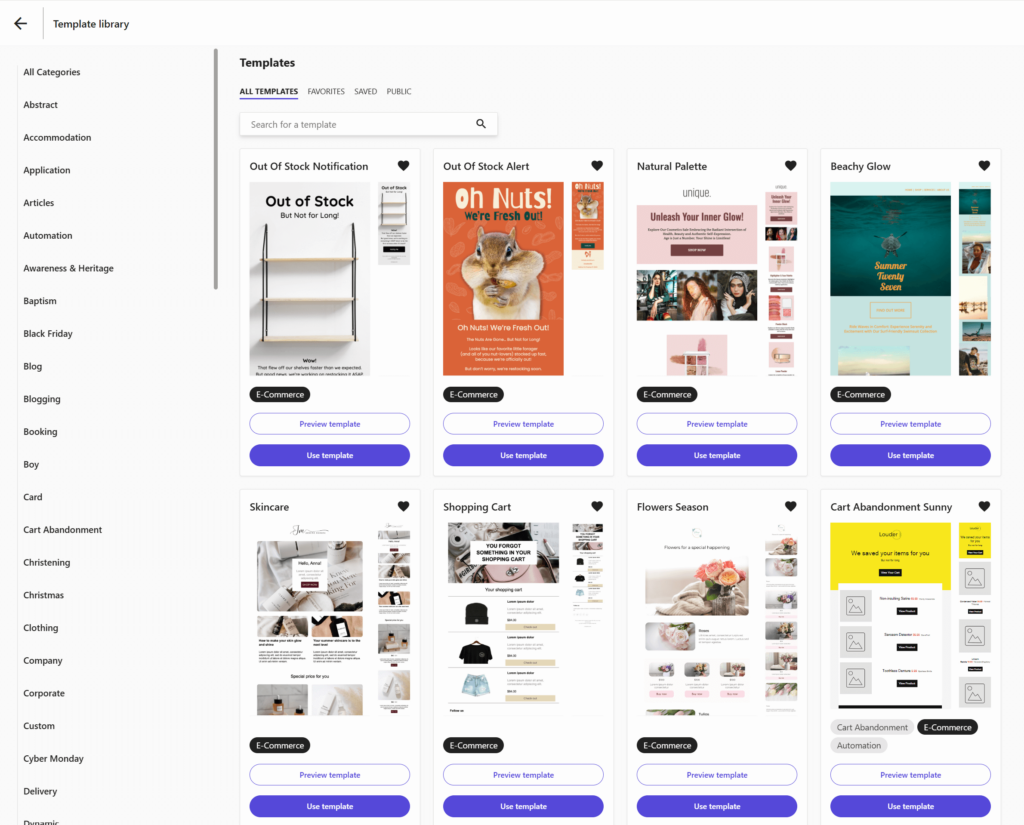
7. Create a dedicated landing page
One of the most essential assets to promote your email challenge is a landing page. This standalone web page has everything a prospect needs to sign up for your channel without getting distracted by other links or marketing actions.
Here’s an inspiring example by Simplish for their 7-Day Productivity Detox:

A great landing page consists of the following elements:
- A clear headline that includes the name and scope of the challenge.
- Supporting copy that clearly details the benefits the user will receive and the challenge Unique Selling Proposition (USP).
- A clear call-to-action button and a signup form to easily collect email addresses.
- Visual elements like clean graphics or mockups that optimize the reader’s experience and draw attention to the key information.
To gain trust faster, use social proof like testimonials from people who’ve joined the challenge or logos from brands that have trusted your business. Also, write your copy in a motivational tone to boost registrations and set expectations about the challenge agenda.
If it’s your first time designing a landing page, you can save significant time by using a dedicated landing page builder with pre-made templates. All you need to do is customize them with your brand’s elements.
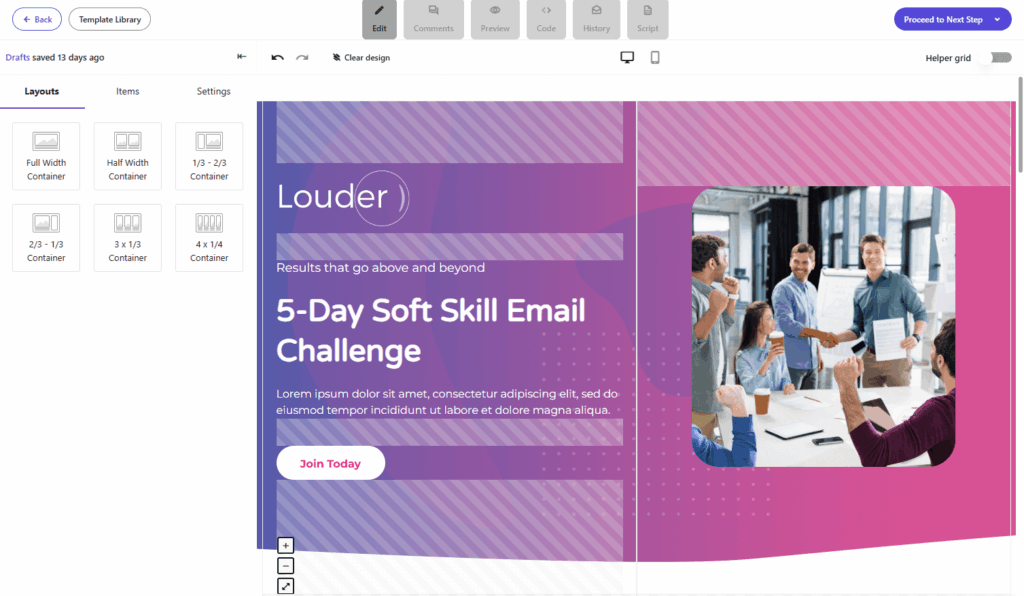
Check out these additional resources:
- Best Practices for Landing Page Copy With Examples
- Landing Page Mistakes You Should Avoid
- Landing Page Design Examples To Inspire Your Layout
7. Set up your automated email series
Sending these emails manually would waste a lot of your time. By pre-writing and scheduling your entire sequence, you ensure every participant receives the right content at the right time.
Most email marketing software, like Moosend and Constant Contact, offer pre-made email automation workflows to help you create them easily. The first step is selecting the trigger, the activity that enrolls the person in the challenge.
This is typically a sign-up for a dedicated landing page form. Then, you can choose the actions that will set the sequence in motion (e.g., send email, wait X days, add tag, remove from other lists).
Immediately tag the participant (e.g., 5-Day Challenge), so they receive this dedicated series. This also allows you to exclude them from other newsletters during the challenge period, preventing inbox clutter. Map the flow of the journey, including pre- and post-challenge, such as welcome emails or surveys.
When you finish, sign up through a testing email address to ensure everything’s spot on. Verify that the content, links, images, and timing in every email are correct before making your challenge public.
8. Promote your email challenge on various channels
You’ve planned, designed, and automated your challenge; now it’s time to collect those sign-ups. To get the best results, you need to share your dedicated landing page across multiple channels as part of your promotional plan.
Start where your existing traffic is: your website. Create a pop-up sign-up form with a compelling offer and place a static banner or bar at the top of every page to attract visitors. Additionally, send an invitation email to existing subscribers and encourage them to forward your challenge link to friends and family members who might also be interested.
You can also post your challenge link on popular platforms where your audience spends time. For example, use link-in-bio or profile links on Instagram/TikTok or share a post detailing the specific professional skill or result the challenge delivers.
If you believe the challenge is worth allocating some budget to, paid ads can bring rapid growth. Social media ads (Facebook/Instagram) and Google ads are top options, depending on where your target audience searches for solutions to the problem your challenge solves.
Email Challenge Examples & Why They Work
Let’s explore different email challenges to inspire you and why their promotional assets are effective.
Holistic Wellness
Holistic Wellness promoted a self-care reset challenge for moms with a simple yet beautiful landing page.
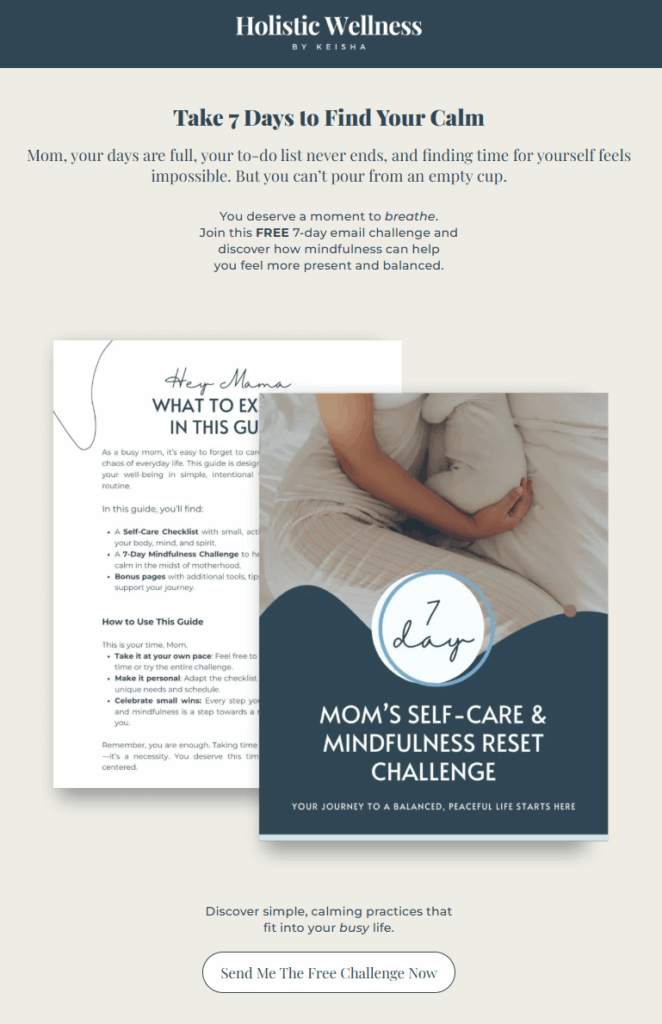
Why it works:
- The headline and supporting copy effectively introduce the challenge copy, written in an emotional tone to encourage busy mothers to join.
- The visuals in the middle clearly set expectations for the email content and supporting resources participants will get.
- The call-to-action button is easy to spot, including the words “free” and “now” to yield more clicks by emphasizing both value and urgency.
A Beautiful Mess
A Beautiful Mess invited their subscribers to their 5-day blogging challenge with this email.
Subject line: FREE 5-day blog challenge!
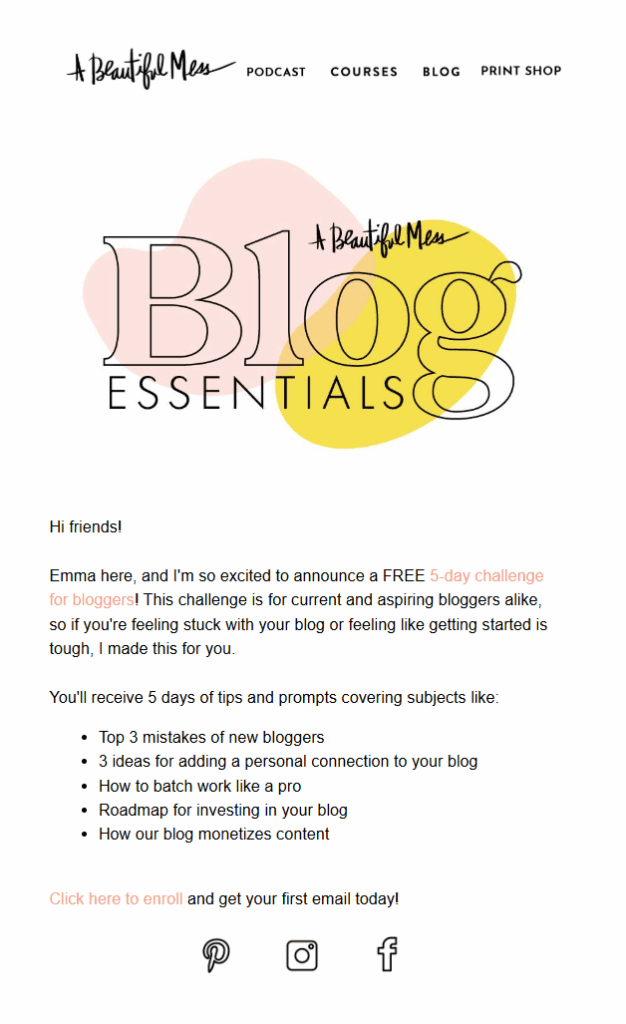
Why it works:
- The subject line introduces the email’s topic to attract the target audience straight away.
- The email copy outlines the intent of this email challenge and lists the main subjects in bullet points for better readability.
- The inline call-to-action is easy to spot and invites readers to join the challenge immediately.
The Recipe Well
This breakfast prep email challenge from The Recipe Well is everything busy people need to begin their day healthily.
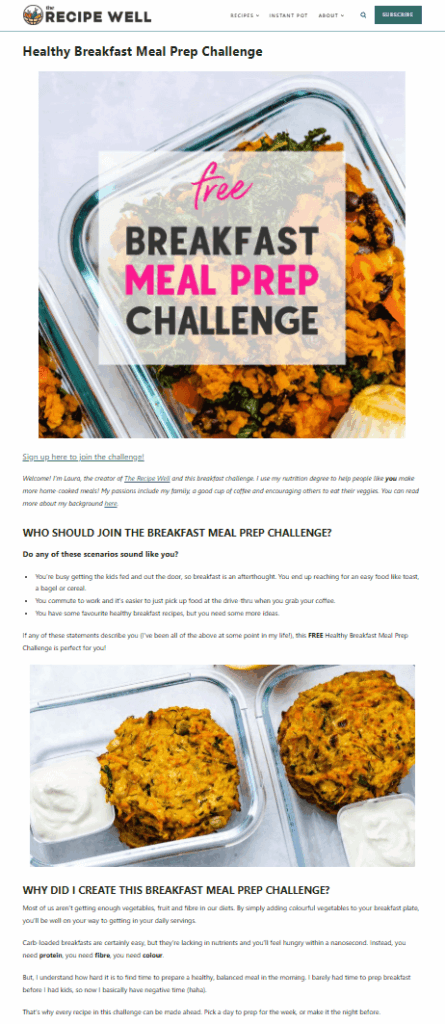
Why it works:
- The copy successfully focuses on describing the target audience for this challenge and the host’s mission, which instantly increases relevance and conversions for that specific segment.
- The images of delicious breakfast meals help readers visualize the outcome (what the recipes will be like).
- Even though they didn’t include a distinct CTA button, they strategically placed the signup link at the top of the content to boost visibility and enrollment.
JulieWG
Julie Winkle Giuloni created a 21-day habit-building challenge to help leaders grow their teams through skill development.
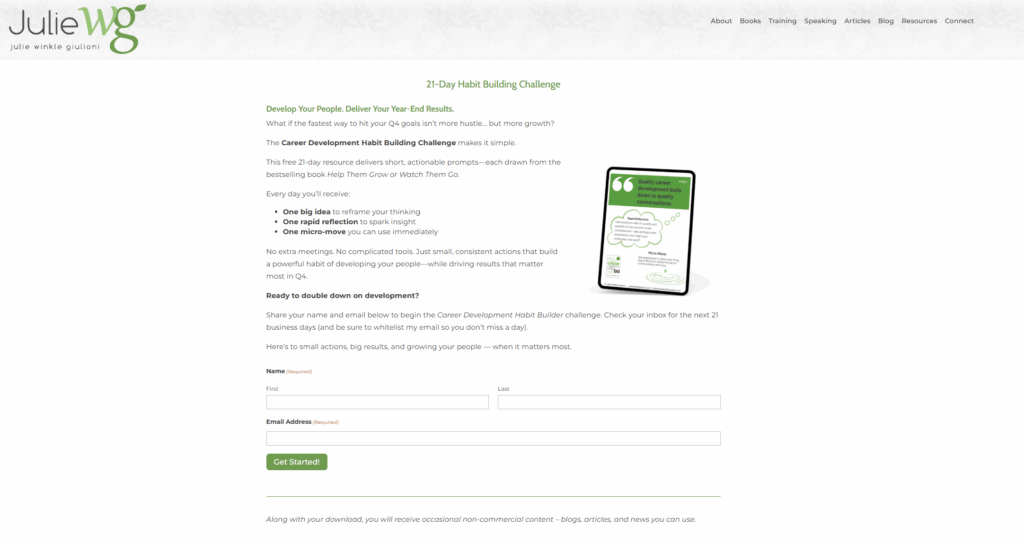
Why it works:
- The landing page copy is written in a motivational tone to promote immediate action and boost conversions among leaders seeking growth.
- They used a short listicle and bolded important phrases to make the key benefits immediately scannable and grab the reader’s attention faster.
- The signup form is short and readily visible (above the fold) to reduce friction and increase challenge subscriptions.
Plan Your Next Email Challenge
Ready to invite your audience on an inspiring mission? Find a goal that makes sense to them and commit to sharing value through content.
Remember: the goal isn’t perfection, but progress. Launch your challenge, learn from your first cohort, and iterate as you go. You already have the tools and the plan.
And if you don’t, Moosend has all the features needed to power up your email challenge, from a landing page builder to pre-made design templates to automation workflows. Sign up for an account today and give it a spin.
FAQs
Explore these frequently asked questions regarding email challenges.
1. How long should an email challenge be?
Most email challenges range from 5 to 7 days, which provides enough time to deliver a meaningful result without overwhelming your subscribers. However, some challenges can last longer (up to 30 days), especially when they aim at guiding participants through a larger, complex project step-by-step.
2. Should the email challenge be evergreen or live?
It depends on your goal. Evergreen email challenges are passive lead magnets that people can join at any time. Live challenges (where everyone starts on the same day) create a sense of urgency, but they require significantly more effort and scheduled promotion.
3. When is the best time to promote your paid product?
It’s best to pitch your offer at the end of your email challenge. This strategic timing works because participants have already experienced your expertise firsthand and are much more likely to trust you and purchase your next product or service.
Subscription forms are often the first touchpoint between your brand and a potential customer. So, why treat them as a checkbox rather than a strategic channel?
For marketers who already understand what subscription forms are, the real question is how to turn them into a measurable, optimizable part of their overall marketing strategy.
A signup only matters if it leads to something, whether that’s an engaged reader or a sale. Subscription form analytics help connect user experience with real results by showing who engages, where subscribers come from, and how long it takes for a signup to deliver value.
This guide will show you which metrics to track, practical ways to capture engagement signals, and the business decisions you can make from them.
Go from analytics to action
Track, analyze, optimize and get more leads in with Moosend’s subscription form analytics.
Start for freeWhy Subscription Form Analytics Matter
For many marketing teams, subscription forms are just a way to boost their newsletter signups or gather information on their leads. This is why you can often find them tucked into a footer or embedded on a landing page. They quietly collect emails, but the “real work” happens while nurturing leads, segmenting users, creating your newsletters, and sending your campaigns.
However, if you’re not tracking how your subscription forms perform, you’re making your lead generation strategy harder than it needs to be. Form analytics can help you understand the users you’re attracting, why they convert (or don’t), and how those users ultimately impact revenue.
But what do subscription form analytics do for your marketing plan, exactly?
They tie form performance to marketing success
Subscription forms mark the moment someone goes from an anonymous visitor to a known contact. When you analyze how each form performs, you’re essentially mapping your traffic and which pages, campaigns, and channels contribute real value.
This is where metrics like conversion rate, acquisition source, and cost per lead start to matter. If forms on blog posts convert better than forms on product pages, or if traffic from LinkedIn yields higher-value subscribers than traffic from Instagram, that’s a strategic shift. Analytics help you redirect time, spend, and creative energy toward what actually works.
They reveal friction points that hurt conversion
A form doesn’t need to be long or complicated to be difficult. Sometimes, a single unclear label or an extra field can cause your conversions to drop, as each added step creates extra friction.
Of course, the above doesn’t mean that all subscription forms perform the same. Tracking friction points is important because it reveals why your audience doesn’t convert.
Maybe shorter forms will perform better for you, or maybe you’re not leading prospects further on their journey because your copy is unclear. The objective here is to create a smoother, more intuitive user experience.
They power better segmentation and personalization
The information you collect upon signup is often the foundation for your nurture strategy. But to use it effectively, you need to understand how it ties to engagement and shapes your demographic segmentation strategy.
For example:
- Do people who select “Informational content” on your preference center’s drop-down menu respond better to case studies?
- Do subscribers from webinar signups convert faster than those from blog CTAs?
- Do prospects from X country display a different buying behavior than those from Y region?
- Does job title influence activation?
Analyzing patterns like these allows you to send the right content to the right people. That’s what leads to higher engagement and faster funnel progression.
They inform your content strategy
Not all content attracts the same type of subscriber. A tutorial might bring in readers looking for practical how-tos, while a deep-dive industry article might attract strategic decision-makers who are closer to buying.
By tying content source to signup, engagement, and, ultimately, conversion, you learn which content actually attracts the right audience. This is how you can go from making more content to creating content that impacts your bottom line and attracts high-value subscribers.
They connect top-of-funnel performance to revenue
This is where subscription form analytics become genuinely powerful. When you track what happens after the signup (opens, activations, conversions, upgrades), you can answer the question that drives investment decisions: “Is this form generating subscribers who eventually become customers?”
Answering this question allows marketing teams to:
- Prioritize forms and placements that lead to paying users
- Eliminate unnecessary friction (like verification or qualifying questions)
- Scale channels that reliably produce profitable subscribers
That way, your form analytics can turn lead capture into a valuable source of prospective customers.
Subscription forms might seem small, but they can influence engagement, segmentation, conversions, and generate revenue in a way that’s more predictable, more efficient, and far more profitable.
Most Important Subscription Form Analytics to Track
Before you start on your metrics journey, think about what you need to track. A small set of reliable analytics that map directly to your strategy can be a lot more effective than tracking everything at once.
Sometimes, tracking your core metrics with Moosend, like Impressions, Conversion, and Conversion percentage, is all you need:

Below, let’s see some other important metrics that can make a difference for your subscription forms, grouped by the problem they help you solve.
Performance Metrics
As the name suggests, these metrics tell you whether the form is doing its basic job: converting visitors into subscribers. They can indicate issues with placement, offer, and user experience.
1. Views or impressions
This is how many people see the form. If impressions are high but everything else is low, your form might have a weak CTA or relevance. A high view count indicates healthy traffic volume. If, on the other hand, views/impressions are low, but your conversion rate is healthy, it means you’re targeting the right audience.
Let’s see an example. A blog post attracts 8,000 pageviews in a month. You use a floating box form that gets 160 impressions. That gap suggests your form’s design could be bland or that you need a different type, like an inline or full-page form.
2. Submissions or signups
This is the count of completed form submissions, which shows your form’s success. The ground zero for volume and the start of any lead-quality analysis. Let’s use the same blog example. Your form generated 240 submissions in one month. That’s the raw list growth you’ll compare across channels and content pieces.
3. Conversion rate
This metric measures how well the form converts visitors. It normalizes performance so you can compare forms across pages and traffic sources.
If you have, let’s say, 240 submissions out of 8,000 page views, your conversion rate would be 3%. If similar posts convert at 6%, the value proposition or CTA likely needs work.
4. Form abandonment rate
This signals the number of people who start the form but do not finish it. High abandonment indicates a poor user experience or friction within the form, rather than a placement issue.
If 600 people opened the form and only 240 submitted, your form abandonment rate would be 60%. This means you need to take some time to inspect fields, invest in a better form builder, or create a more powerful CTA.
5. Time to complete
This metric shows how long it takes users to complete your form after they start interacting with it. Long completion times sometimes reveal complexity, confusion, or unnecessary friction. All of those harm your conversion rates.
Let’s assume that your median time-to-complete on desktop is 18 seconds, but jumps to 55 seconds on mobile. That suggests that your form’s layout needs mobile-related fixes, like fewer fields or a responsive form template
Engagement Metrics
Once people see and start your form, engagement metrics tell you how they behave, where they stall, and whether the experience works across devices and page types. These are the signals that let you move from “my forms don’t perform” to “I know why I lost leads.”
6. Field drop-off rate
This metric shows which fields cause the most exits or the share of users who stop filling out the form at a specific field. Identifying a single problematic field is often one of the fastest fixes. Change one label or make one field optional, and you can get a large uplift.
How to spot it: Look at the percentage of users who reached field X and didn’t continue to field Y. For example, on a lead form of 1,000 starters, 600 reach the “Company size” field, but only 360 proceed. This signals a 40% drop-off in that field. Making it optional and adding a “Prefer not to say” option could increase overall completions.
7. Error rate
This is the proportion of submission attempts that fail due to client-side or server-side validation (invalid email, password rules, required fields). Confusing or unclear validation often creates distrust. You can fix this quickly with clean and precise error microcopy. To identify the issue, count validation errors per type and per field. A good idea would be to prioritize frequent errors first.
For instance, if a signup flow shows 180 email-format validation errors out of 900 submission attempts, that’s a 20% email error rate. Adding placeholder text like [email protected] and inline live validation helps minimize those errors and improve the user experience.
8. Device and page insights
This metric shows your conversion performance segmented by device (mobile, tablet, desktop) and page type (blog post, landing page, pricing page). You need it to understand the subtle design differences that work across different types of devices and pages. A desktop form can appear broken on mobile; a CTA that fits a landing page’s intent may fail in a blog context.
To understand it, compare view-to-submit and abandonment across device and page segments.
For example, let’s say a newsletter form converts at 4.5% as an inline form on your home page’s header, but only 1.1% on your blog. This means you need to adjust your messaging to better align with your blog post content.
9. Scroll depth or visibility
Are people seeing the form? This is the question this metric answers: whether visitors scroll far enough or have the form in their direct field of vision. Low visibility can masquerade as poor conversion. And sometimes, this subscription form mistake can hide the form. The fix here is placement. To spot it, use heatmaps or scroll tracking to show where reading drops off. Then, compare impressions to pageviews to check explicit visibility.
For instance, your homepage footer form records 10,000 pageviews but only 500 form impressions. This shows that most users never reach the footer. Moving the CTA above the fold could boost impressions and multiply newsletter signups.
Quality and Outcome Metrics
Quality and outcome metrics tell you whether your signups can turn into real relationships, revenue, or pointless list noise. These are the signals you use to decide whether to optimize for volume or for value.
10. Lead quality
It shows the percentage of valid or engaged subscribers. Essentially, lead quality is a simple way to separate “real” subscribers from low-value signups like bots, disposable emails, or people who never engage. You can measure this as the share of new signups that pass basic validation checks like an email opt-in process and show initial engagement.
A high volume of low-quality leads damages sender reputation and can inflate your email marketing platform’s costs, especially since most platforms charge subscription-based pricing. Better-quality leads improve conversion, and reduce churn and costs.
You can measure it by taking the number of new subscribers who either pass your email verification checks or interact with your welcome email, and compare it to your total number of signups. If most new subscribers are valid and engage early on, your lead quality is strong.
Let’s see an example: Of 1,000 new subscribers in a month, 850 pass email validation, but only 300 open the welcome email. So, 85% is technically valid, but 30% is initially engaged. The team decides to add a simple double opt-in to improve lead quality.
11. Email engagement
This metric shows early engagement metrics (opens, clicks) for the welcome series and your first campaigns sent to your new signups. First-touch engagement is the most predictive behavioral signal for long-term value. Subscribers who open and click early are far likelier to convert to trials or purchases. So, look at the open and click behavior for the first one to three emails that new subscribers receive. If subscribers engage early, they’re more likely to stay active long-term.
Example: Segment A comes from webinar signups. It shows a 45% open rate and 12% click rate on the first email. Segment B comes from site footer signups and shows 18% and 2% respectively. What should your course of action be? Since Segment A is more active and more likely to provide long-term conversions, you can route Segment A into a short, conversion-focused sequence. As for Segment B, create a more gradual nurture email workflow.
12. Source or channel performance
This metric shows which channels drive the best signups. It’s essentially comparing conversions by acquisition source (organic blog, paid social, SEO, webinars, etc.). Raw lead volume doesn’t equal value. Channel-level outcome metrics let you allocate budget toward channels that produce higher LTV per lead.
To measure it, review where your signups are coming from. Is it your blog, paid ads, social media, or referrals? After that, compare how those groups behave after signing up. Channels that produce subscribers who actually open, click, and convert are worth investing more in. Channels that deliver low-engagement subscribers should be reconsidered.
Let’s consider this scenario: A paid social campaign delivers 4,000 signups at $5 cost-per-lead (CPL), but produces a 0.7% trial rate. On the other hand, organic blog CTAs deliver 800 signups at $1 CPL but produce a 6% trial rate. Despite the lower volume, your blog delivers far higher conversions. This would mean you’ll need to shift your efforts and optimize high-performing blog CTAs.
How Insights Translate into Action
So, you know what to track. Now what? This is the part where your metrics become your roadmap. Let’s see some practical ways to turn signals into immediate wins.
Improve user experience
There are three golden rules for improving subscription form UX: shorter forms, simplified design, and clear, concise CTAs.
Minor UX fixes often produce the biggest returns. If your analytics show high abandonment or that users take a long time to complete the action, treat the form like a conversation. Make it short, obvious, and easy to finish:
- Remove non-essential fields or make them optional.
- Replace free-text with dropdowns where possible.
- Use clear, benefit-led CTAs like “Get weekly insights” instead of “Subscribe.”
- Optimize for mobile with large touch targets, single-column layout, and numeric keyboards for phone fields.
In short, your form design and copy need to be simple and beneficial to users. Like this:
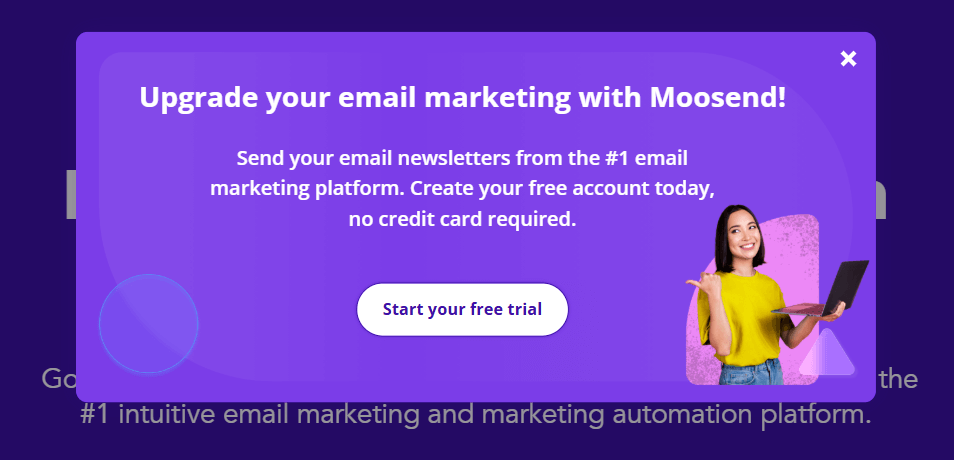
Some additional steps you can take are:
- Reordering fields by effort. You can start with the easiest question (like email) to build momentum.
- Adding microcopy and pinpointing mistakes, like “No spam” or “This is a required field.”
- Using visual cues to clearly separate required and optional fields.
- Testing various form types. A full-page form may perform better on marketing pages, while a floating bar could be the wise choice for a content-heavy page.
After you design your form, start measuring your submission and abandonment rates, your field-level drop-offs, and the time it took to complete the form by device.

Here’s a great example where each field includes helpful placeholder text to help with entering information. What’s more, the required fields are clearly marked. This means that prospects who want to be a part of Cuddle Clone’s promotion will know what information to give right off the bat.
Optimize targeting
This is where you could identify your best-performing channels and audiences. Not all traffic is equal, after all. Use your form metadata and post-signup behavior to see which channels deliver the subscribers who actually engage and convert.
Here’s what you can do:
- Tag signups with source (or use UTMs) and segment by campaign.
- Create high-priority segments (e.g., webinar, paid social, blog, email, etc.) and compare conversions by channel or campaign.
- Reallocate your budget or tweak messaging toward channels with higher LTV per lead.
- Match form messaging to the traffic source. For example, LinkedIn visitors may need a different CTA than blog readers.
- Add a short “why subscribe” near the form to clearly show what the subscriber gets. This way, you’ll attract leads interested in a specific value proposition.
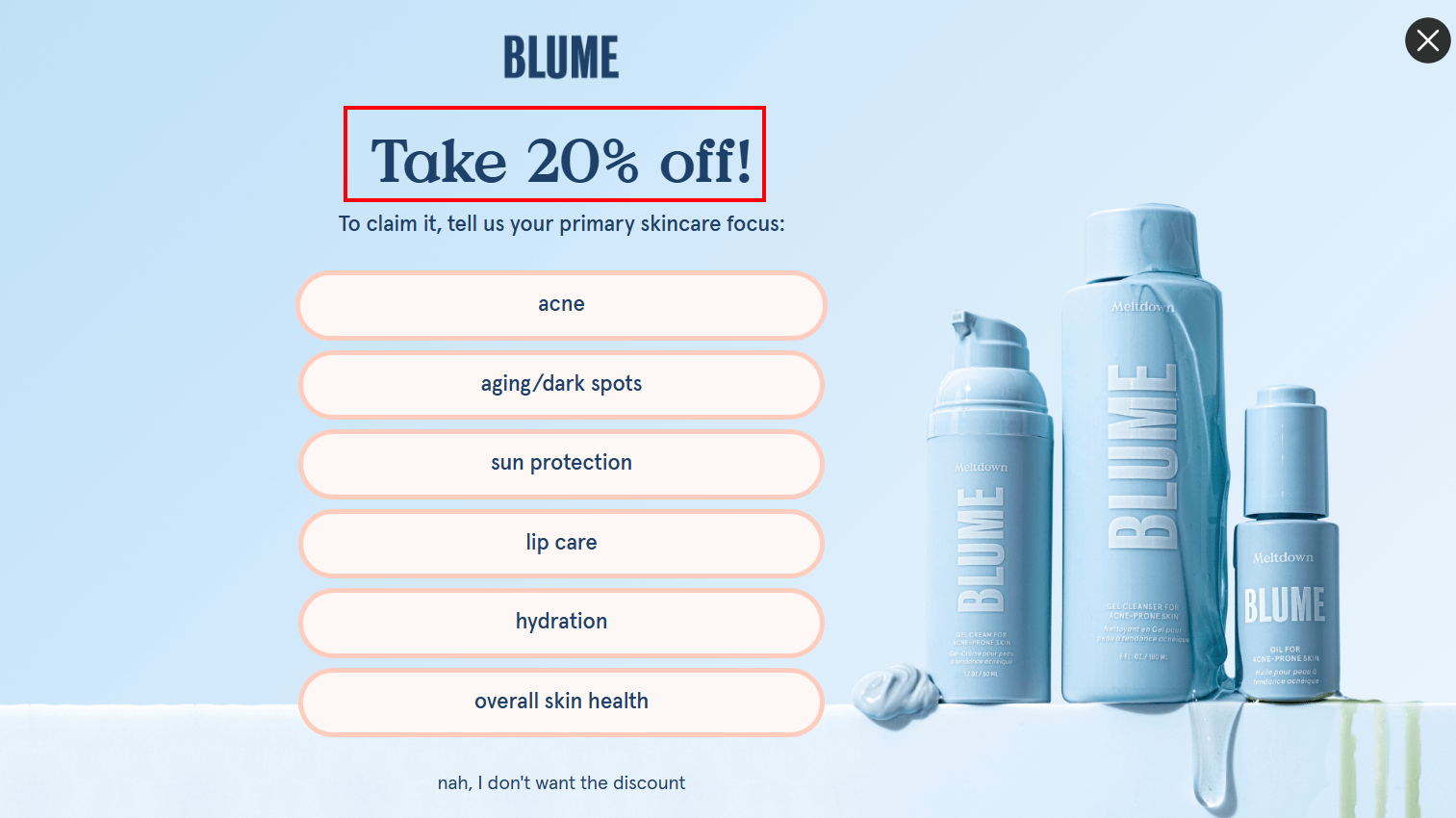
Blume does a great job of showing why a prospective subscriber should follow through with the action, which means getting 20% off their first order.
Once you follow through with those actions, measure which actions converted best by source, and your engagement rates per channel. If, for example, email leads convert faster than paid social, shift spend to your email campaigns and refine the CTAs based on that audience’s behavior.
Enhance lead quality
This is where you need to filter bots, use double opt-ins, and track post-signup engagement. Volume is useless if your leads are not qualified. Here’s how to improve the quality of leads without killing conversions:
- Add simple email validation to block disposable domains and invalid email addresses.
- Use CAPTCHA. They might increase friction, but they’ll filter out the bots.
- Ask for minimal data initially, then gather more info later. An email address, a name, and perhaps a location would do.
- Trigger welcome sequences based on page or channel source.
- Use lead scoring for new subscribers from the start with behavior signals like early opens or page history.
- Segment “silent subscribers” quickly and start nurturing them to lead them down the funnel smoothly, and protect your campaigns from the “Mark as spam” button.
Let’s see an example: Enabling email validation on email campaigns helped measure hard bounces. This, in turn, increased the percentage of users who open the welcome email. This is a clear win for sender reputation and ROI.
How to Track Subscription Form Analytics
Knowing which subscription form analytics matter is one thing. Knowing which ones matter is another. Actually capturing them is another. Tracking subscription form performance doesn’t have to be complicated, but using the right tools ensures you’re not just creating and hoping your form works.
You can start with native tools in your email platform, layer in external solutions for deeper insights, and then combine all data for a complete view.
Using Moosend’s native subscription form analytics
Moosend’s built-in analytics go beyond email metrics, giving you a clear view of form performance without needing extra setup. Each form automatically tracks Impressions, Conversions, and Conversion Percentage, helping you measure visibility and effectiveness at a glance:

- Impressions show that our form was displayed 5,000 times.
- Conversions show that we had 200 successful Halloween submissions.
- Conversion Rate ties it together. It’s the percentage of impressions that turned into signups—in our case, 4%.
The status shows that our form is still published. You can also use labels on your forms to easily filter and sort them according to action, audience, or any other label necessary for internal use.
Now, back to our analytics. Impressions, conversions, and conversion rate can already tell you a lot. As we mentioned before, high impressions but low conversions suggest issues with your form copy, CTA, or layout.
Low impressions but a high conversion rate indicate that your placement is working, and you just need to increase visibility.
Lastly, low impressions and conversions mean you need to revisit where the form appears and whether it aligns with user intent.
While Moosend doesn’t offer native A/B testing for forms, you can still compare performance by creating variations manually. For example, using one form on blog post A and another on blog post B. Over time, you’ll see which design, message, or placement consistently drives higher conversion.
The tool’s simplicity can help you spot whether your audience sees your form and whether they act on it quickly and easily. That’s enough to guide smart, data-backed adjustments before moving on to more advanced tracking.
Using dedicated tools
Dedicated forms analytics tools help you understand why you see the numbers you see, and what happens next. Use lightweight, marketer-friendly tools to add behavior, funnel, and downstream value signals.
Google Analytics 4
Using GA4 can help you determine and understand event tracking (form views, starts, submissions). Use it to capture three easy events:
- The form_view (when the form became visible)
- The form_start (when the user focuses or clicks into the form)
- The form_submit (completed submission).
Those events let you measure visibility versus intent versus completion across landing pages, blog posts, webinar pages, and other traffic sources.
GA4 can help you see which campaign performs best by using UTMs, spot pages where many prospects start completing your form but drop off at some point (signaling field friction or bad UX), or which forms people view but don’t start completing.
Heatmaps like Hotjar and Microsoft Clarity
Heatmaps and session recordings help you visualize behavior and drop-offs. Tools like Hotjar and Microsoft Clarity can help you understand where users hesitate, which fields they ignore, and whether the form is actually visible on mobile.
Look for scroll depth before the form to understand if it’s too low or too high on the page, or if there is frequent abandonment right after a specific field. These visual signals are the fastest way to decide if the fix is copy, placement, or user intent.
CRM or ESP reports
CRM tools like HubSpot can help you link signups to lead quality and campaign engagement. Export or sync form signups into your CRM—or use your email marketing service—and track early signals of quality, such as welcome-open rates, click-throughs, trial starts, or assigned lead score.
You can perform practical checks, like identifying which source produces the highest 7-day open rate. Or which form (or form variant, if you’re performing A/B checks) generates the most qualified leads. This is where you stop optimizing for volume and start optimizing for value.
Best Practices for Accurate Tracking
Good subscription form analytics start with predictable data. Small mistakes like inconsistent naming or broken events produce misleading signals that lead to bad decisions. Below are focused, practical rules to keep your tracking honest and useful.
- Use consistent tagging and naming conventions: Pick a simple, team-wide taxonomy for UTMs, form IDs, and event names. Consistency makes it trivial to compare forms, channels, and campaigns across tools. If your naming is messy, you’ll spend more time cleaning data than optimizing. Pick one format, document it on one page, and require it in every campaign brief.
- Test forms across devices and browsers: Forms behave differently on mobile browsers, older browser versions, and small viewports. A change that looks fine on a desktop can break the submit button on smartphones. Test the subscription form across both and do a quick smoke test after any copy or embed change.
- Validate that analytics tools capture submissions correctly: Ensure your numbers match reality. Small divergences are normal, but large gaps usually show an implementation issue.
- Track performance over time, not just per campaign: Short-term spikes or dips mislead. Use frequent and seasonal comparisons to tell if a change is real or noise. Track core trends like impressions and conversion rate monthly. Look for sustained uplifts, not just one-off gains.
- Respect privacy and ensure GDPR compliance: Tracking must be compliant and respectful. Only collect data you need, show explicit consent when required, and persist consent records. If you use behavioral tools like heatmaps, make sure they anonymize personal data and run only after consent where required.
Following these simple, repeatable best practices keeps your tracking reliable and makes your optimization work efficient. Clean, trusted data makes a huge difference and helps you lose between tactical guesswork and move towards clear, repeatable marketing wins.
Track Smarter, Not Harder
Form analytics can help you understand how early interactions shape your audience and, ultimately, your revenue. Treat your subscription forms as measurable, optimizable assets, and you’ll see how less guesswork leads to data-backed improvements that drive consistent growth.
Start simple: track impressions, submissions, and conversion rates in Moosend to spot quick wins. Then layer in external tools for deeper insights like user behavior or post-signup engagement. The more complete your view, the better your strategy. Keep testing, refining, and let your data show you where your best subscribers are coming from.
FAQs
Let’s take a look at some frequently asked questions on subscription form analytics.
1. What’s the most important metric to track for a subscription form?
Conversion rate is your primary performance metric that shows how efficiently visitors turn into subscribers. But don’t look at it alone; pair it with impressions and post-signup engagement for real context.
2. How often should I review my form analytics?
This depends on your industry and your goals. A good rule of thumb is weekly for active campaigns and monthly for evergreen forms. Regular reviews help you catch drops early and understand if changes you made (like copy or placement) are actually working.
3. How do I know if low conversions are a placement issue or a UX issue?
If impressions are low, it’s likely placement. If impressions are fine but conversions drop, you’re looking at a UX or copy problem like unclear CTAs, too many fields, or poor mobile layout.
4. Should I remove underperforming forms or try to fix them?
This is up to you, but generally it’s best to fix first. Start by adjusting CTA copy, placement, or form length. If a form stays flat after several tweaks and its traffic is low-quality, it’s better to retire it.
5. How do I balance data tracking with privacy compliance?
Collect only what you need (usually an email and name), include clear consent language, and ensure any behavioral tools you use mask personal information. Finally, always follow GDPR or local privacy laws.
What if you could skip the slow, complex website building process and jump straight to collecting leads or making sales?
Despite what some marketers still believe, you don’t need an entire website to launch an idea, promote a product, or grow your audience. A single landing page can do all of that, and sometimes, even better. Because it’s faster to set up, easier to manage, and way more focused on one goal: getting people to take action.
In this guide, we’ll show you how to create a landing page without a website, using beginner-friendly tools and smart marketing strategies. Learn how to make these digital assets work seamlessly to meet your marketing goals.
Turn ideas into polished landing pages with ease
Launch custom landing pages fast with our intuitive builder.
Try MoosendLanding Pages vs. Websites: What’s The Difference?
A landing page is a standalone page designed with a singular marketing goal in mind, such as collecting emails or promoting a service.
A website, on the other hand, is like your digital headquarters. It’s where visitors explore who you are, what you offer, and maybe get lost clicking through your blog, about pages, and contact forms.
While a website typically contains large amounts of content, linking to both internal and external pages that serve different purposes, a landing page has one clear goal, one call to action, and most importantly, zero distractions. Instead of saying, “Here’s everything we do,” it says, “Here’s what you should do, right now.”
Explore their key differences in the table below:
| Website | Landing Page | |
| Purpose | Brand awareness and long-term growth | Lead generation and direct sales |
| Structure | Multi-page, with navigation | Single-page, no navigation |
| Audience | Visitors exploring your business | Visitors from a specific source |
| Setup time | Longer (requires hosting, structure, design) | Short (can go live on the same day) |
Can a Landing Page Act as a Website?
Short answer: yes, it can. A landing page can replace a website, especially if your main goal is to create an online space where people can learn who you are and take a clear action, like subscribing, booking, or buying. This setup works surprisingly well for small businesses, freelancers, and creators.
Think of it as a one-page website. It still represents your brand, highlights your offer, and guides visitors toward a conversion, all from a single, focused space. Plus, you can save the time and budget required to build a full site.
Here’s how SimplyDigital’s agency used landing pages to expand its audience:
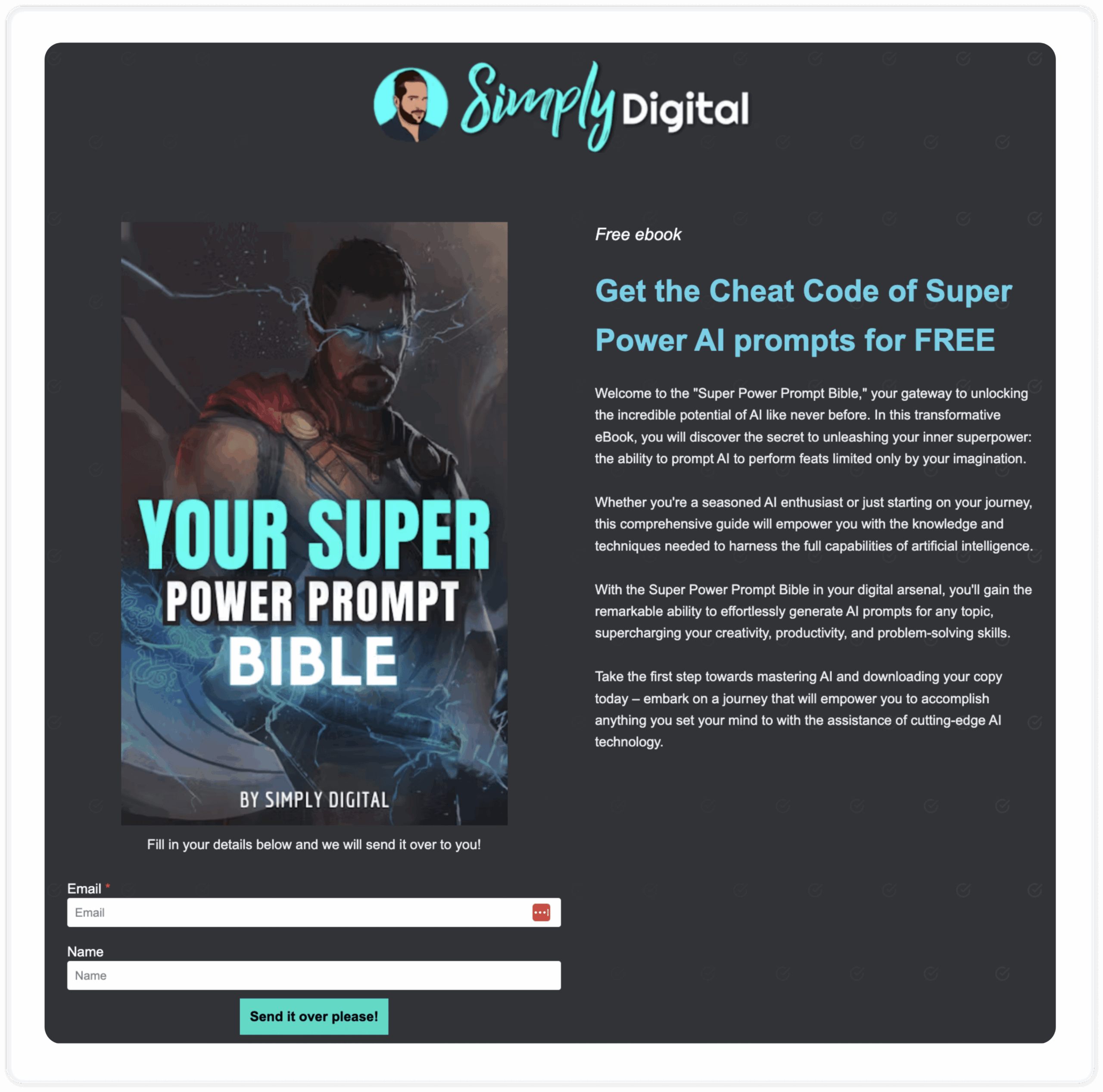
Moreover, some businesses even use multiple types of landing pages covering different purposes, such as lead generation and event promotion, that also work as “mini-sites,” instead of investing in a website.
Pros and Cons of Creating a Landing Page Without an Existing Website
While a landing page can absolutely take the place of a website, it’s not a one-size-fits-all solution. Whether it’s the right move for you depends on your goals, resources, and how fast you want to get things rolling. Let’s explore its main perks and drawbacks:
Pros
- Better ad performances: When you run paid ads, sending visitors to a focused landing page instead of a full website increases the conversion potential. There are no menus, no navigation links, just one clear call to action.
- Faster to launch: You can have a landing page live within a day. It’s the ultimate quick-start option for creators, small businesses, or anyone who wants fast results.
- Lower investment: With landing pages, you won’t need to pay for a domain, hosting, or web development. You can launch your offer for a fraction of the cost and test ideas before committing to a full site.
- Easier to test and optimize: A single page means fewer moving parts. You can quickly A/B test headlines, visuals, and CTAs to see what converts best.
- Ideal for limited-time offers: Landing pages are great for campaigns that don’t need a permanent home. These include flash sales, event registrations, product pre-launches, and more.
Cons
- Limited content flexibility: If you want your landing pages to work, you’ll need to keep your message short and strategic. This can be a problem if you have a complicated product, since readers may find your page weak.
- Reduced brand awareness: Without a full website, it’s harder to showcase your entire brand story or product variability. Since a landing page focuses on a single goal, there is limited space for storytelling.
- Harder to build long-term SEO: Search engines love websites with structured content and multiple pages. A single landing page won’t drive much organic traffic on its own.
- Perception of legitimacy: Some users may expect a full website to feel reassured that your business is credible. This is especially true if they’re about to make a purchase or share personal data.
How to Create a Flawless Landing Page Without a Website
Ready to go from idea to live page? Here’s how you can create a fully functional landing page without owning a domain or writing a single line of code.
Step #1: Define your landing page goal
Before you start designing your landing page, the first thing you need to do is establish its purpose. For example:
- Lead generation: Collecting email addresses for future marketing efforts.
- Direct sales: Selling a product or service immediately.
- Event promotion: Drive sign-ups for a specific event or webinar.
Establishing a clear goal will help you determine the exact information and arguments needed to convince your target audience to take action, and will ultimately inform your entire strategy.
#Step 2: Choose a landing page builder
Once you define the goal of your landing page, the next step is choosing the right tool. Luckily, there are several great landing page builders in the market, with both free and paid options.
A good builder should offer features that help you design quickly, test variations, and optimize for conversions. At a minimum, look for:
- Premade templates so you can start with a proven layout
- A drag-and-drop editor to customize your page without coding
- Mobile-responsive designs that look great on all devices
- SEO settings support (e.g., meta title, description, URL slug)
- A/B testing options to compare versions and improve performance
- Integrations with your email marketing platform or CRM
If you want a simple, beginner-friendly tool that checks the above boxes, Moosend’s landing page builder is a solid choice. You can create a free Moosend account, pick from professionally designed templates, and customize everything using the intuitive drag-and-drop editor.
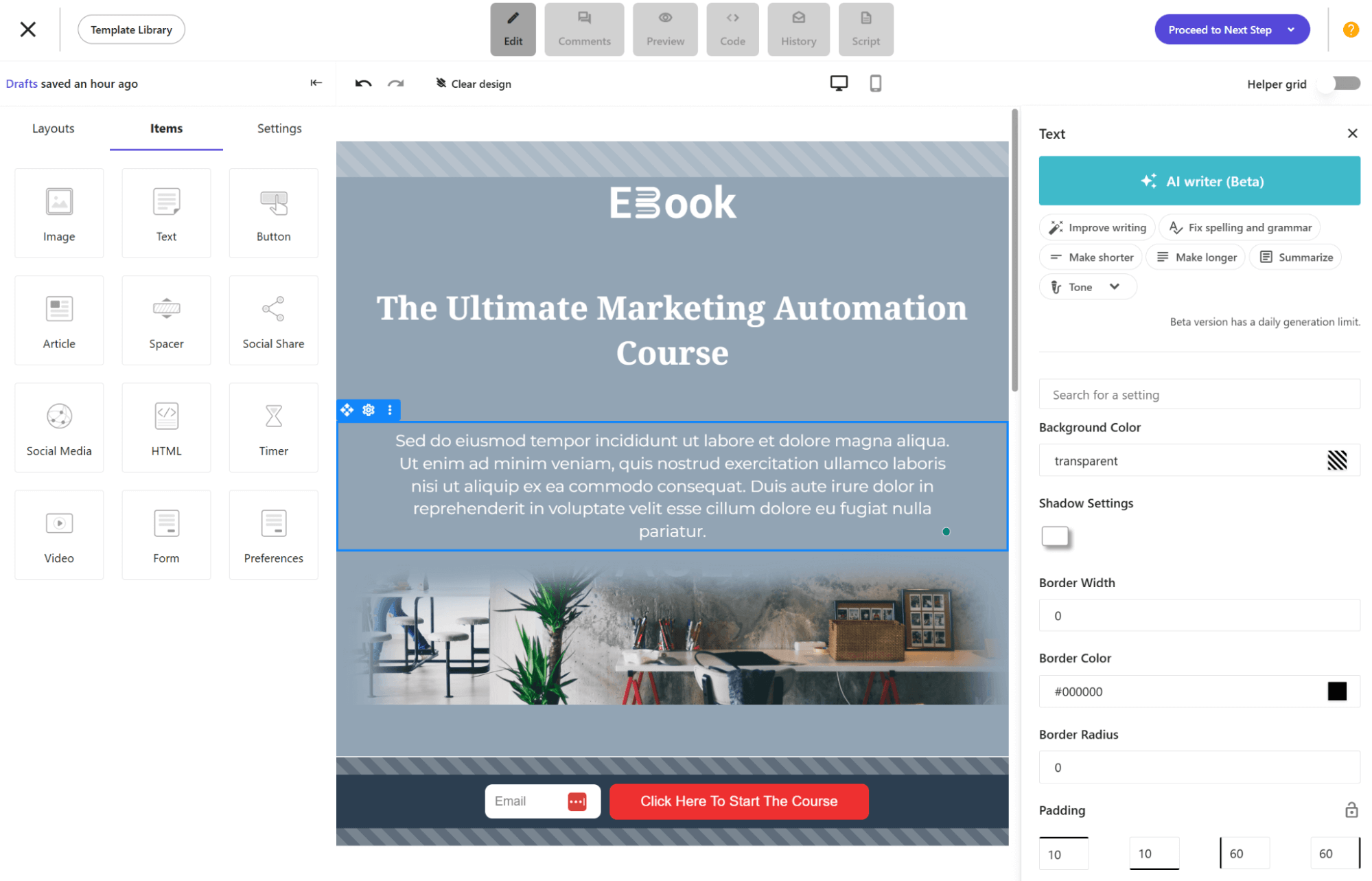
Create your first landing page
Step #3: Design your landing page
You’ve reached the fun part. Now, you can begin with the landing page creation. You can either start building a design from scratch or select a landing page template.
If you don’t want to involve a designer, selecting a template is the best option. Many landing page builders offer pre-made landing page templates that you can use as a starting point to save time and effort.
For example, Moosend offers 40+ templates for lead generation, promotions, events, and more.
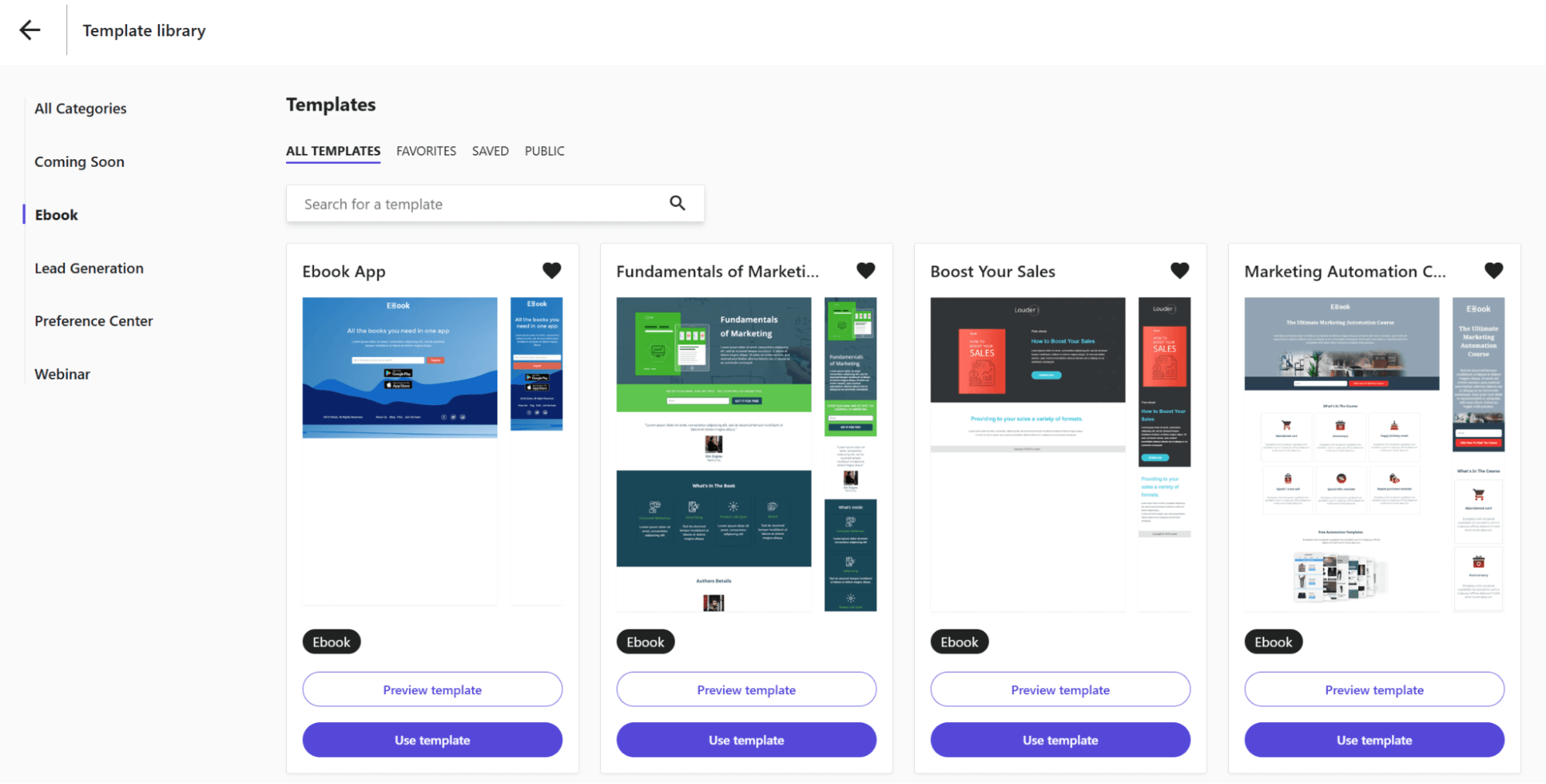
Step #4: Write engaging copy
As we said before, landing pages are focused pages. So, your landing page copy matters more than you think. Write clear, benefit-focused copy that tells visitors exactly what they’ll get and what to do next.
First, think of an eye-catching headline that grabs attention and aligns with your landing page goal. You’ll also need to create short supporting text that encourages readers to delve deeper, while also highlighting how your offer differentiates from the competition.
The better you communicate your Unique Selling Proposition (USP), the more value your readers will see in your offer.
At this step, you can leverage AI writing tools that are integrated into your landing page software. For example, Moosend has an AI Writer that assists users with creating and proofreading copy for email campaigns and landing pages.
Next, you’ll need to create a compelling CTA button, such as “Sign up now” or “Grab your eBook”. It’s advisable to use contrasting colors for your CTA to make it stand out.
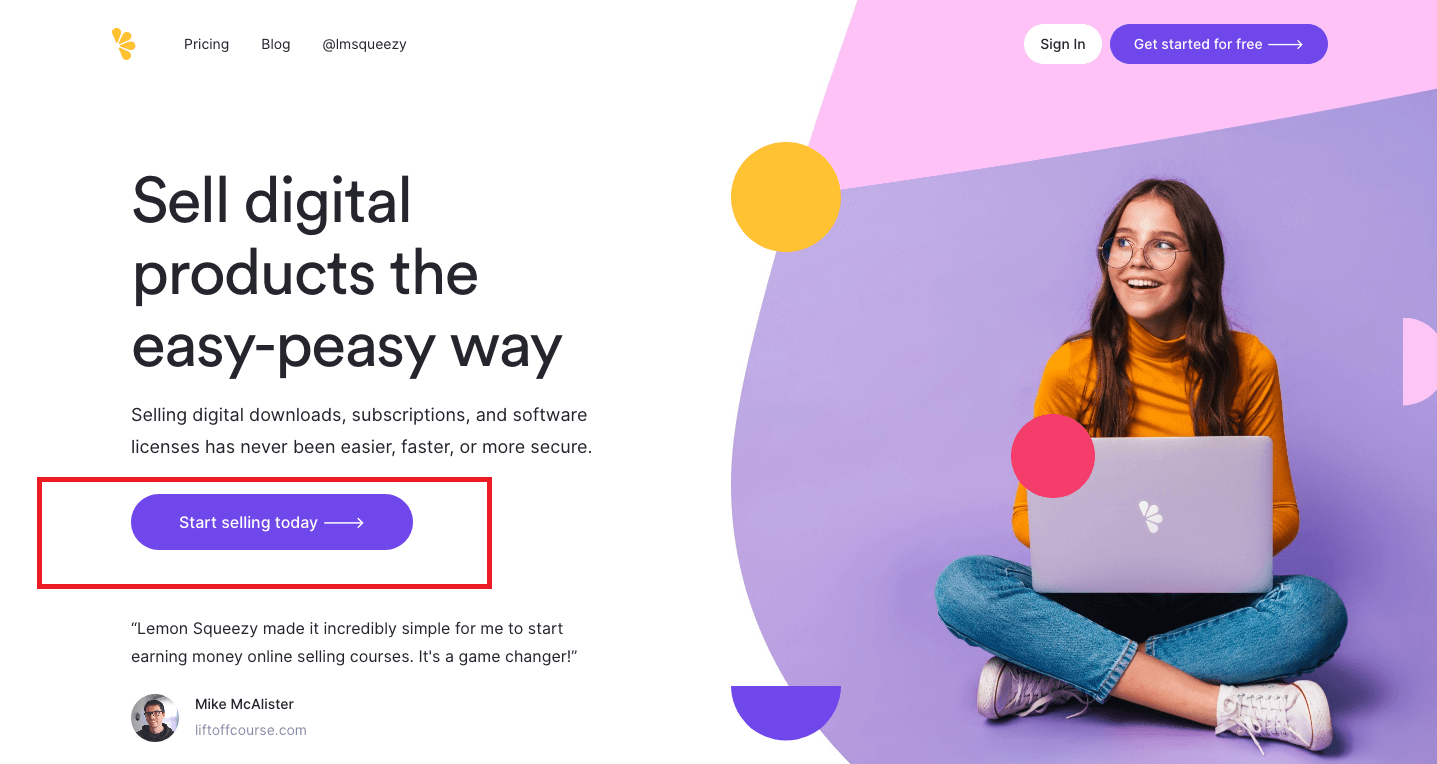
Keep the message consistent, from your ad or email to your landing page, so users know they’re in the right place.
Step #5: Customize visuals and layout
Use the drag-and-drop editor to add images, forms, buttons, social icons, and even countdown timers. Try to use visuals that support your offer, such as product photos, mockups, or screenshots, in order to help people understand what they’re getting.
Alternatively, it’s a great idea to add testimonials or a quick explainer video.
Tip: Avoid lengthy forms as they can “intimidate” potential customers.
Step #6: Set up conversion tracking
After you finalize your design and proofread for any typos and errors, it’s time to decide how you want to track conversions.
Many landing page builders let you track your conversions in two ways:
- When someone submits a form
- When someone clicks a button
Additionally, you can enable tracking with Google Analytics and Facebook Pixel by following your builder’s instructions.
Step #7: Set SEO settings
After finalizing the content of your landing page, your landing page builder will usually ask you to fill in some SEO details to boost visibility via search engines. These can include your page title, meta description, and an internal name to help you identify the page in your dashboard.
Here are two quick tips:
- Keep your title under 60 characters and include your main keyword (e.g., “Free Webinar on Email Marketing”).
- Write a meta description around 150–160 characters that clearly tells users what they’ll get when they visit your page.
You can also upload a favicon, which is the small image that represents your website in web browser tabs.
Step #8: Publish your landing page
Now, you’re ready for publishing. Most landing page builders will host the landing page for you, so you don’t need your own domain or hosting service. You’ll get a shareable link you can use on social media, in ads, or in your email campaigns.
And just like that, you’ve launched your first page without ever touching a website builder.
Actionable Landing Page Design Best Practices
If you want your landing page to actually perform, here are a few quick strategies you can apply right away:
- Put the value upfront: Your headline should answer the question: “Why should I care?” Make the benefit clear in the first few seconds.
- Use one clear CTA: Use bold color and clear text (“Get the guide,” “Join the webinar”), and remove distractions like menus or external links. Place the CTA button above the fold and after key sections as you see fit.
- Add social proof: Testimonials, reviews, logos, and anything that shows real people already trust you can boost your credibility.
- Keep forms short: Ask only for what you truly need. Failing to do so might discourage visitors from providing their details and reduce overall landing page performance.
- Optimize for mobile: More than half of your visitors are probably on their phones. Check spacing, button size, and load time on these devices.
- Use consistent messaging: Match the promise from your ad, email, or social post. Otherwise, your page will feel “foreign” and won’t deliver the expected results.
- Test one thing at a time: When A/B testing your page, change one thing at a time (e.g., the headline or CTA color). Otherwise, you won’t be able to track what worked (or didn’t).
Ready To Launch Your Landing Page?
What’s the aftermath? A simple landing page can give you all the visibility and functionality you need, without the high costs or the wait for someone to “get back to you next week.”
And now that you know exactly how to build one, there’s nothing stopping you from getting started.
If you’re ready to try it for yourself, creating a free Moosend account is all it takes. Your first landing page is only a few clicks away.
Let’s talk about the future of spending: Generation Z. By 2030, their spending power is projected to reach $12T globally, and you can’t afford to ignore them. Born between 1997 and 2012, this demographic is the first truly digitally native generation, raised with immediate access to online information.
The result? Their consumer behavior has changed significantly compared to previous generations. They grew up spotting marketing tricks from a mile away, care about real value, and question every ad that comes their way.
In this article, you’ll discover key insights about marketing to Gen Z, along with their traits, preferred marketing channels, and tactics that can help you reach them more effectively. Also, you’ll learn tips to address them without compromising your brand’s core identity.
Decoding Gen Z’s Consumer DNA & Key Marketing Trends
Gen Zers have a unique consumer mindset. Let’s explore their main traits to understand them better.
Authenticity and transparency
Young consumers seek value and authenticity. They support brands that align with their personal ethics and are brave enough to take a public standpoint. Moreover, Gen Z can easily distinguish between proactive and performative marketing.
For example, they’re more likely to choose brands that follow environmentally friendly practices. Eco-friendly packaging, sustainable sourcing, and social responsibility actions should be high on every retailer’s and manufacturer’s agenda to win the trust of Gen Z. These practices should be presented with full transparency. Brands should openly share data on their initiatives and impact, not just make generic statements.
So what makes an authentic marketing experience for Gen Z? It’s a “come as you are” brand mindset. They want brands that welcome individuality, whether through online and offline engagement events or gamified spaces where they can create profiles or avatars and show who they are.
Conversational and real-time communication
Being digital natives definitely changed the game for Gen Z’s communication preferences. They pretty much live in digital messaging channels and social media, which they can easily access on their smartphones, and often skip traditional ones. Instagram and WhatsApp, for instance, are essential for them.
This generation is all about immediacy and speed. They don’t want lengthy conversations, but quick responses. Emojis, memes, GIFs, and reels are sent more often and win out over text-heavy messages. Plus, Internet slang, acronyms, and lo-fi content are definitely on their bucket list.
Finally, Gen Z wants to keep it real. They prefer to communicate in ways that let them express their authentic selves, rather than participate in formal transactions. And of course, they expect the same energy from the brands they interact with.
Social media shopping
For younger generations, social media platforms aren’t just for communication. Social commerce is already dominating their shopping habits, with 58% of Gen Zers having made a purchase directly through a social media channel.
Short-form video platforms like TikTok, Instagram Reels, and YouTube Shorts are often outperforming traditional search engines for this cohort. To keep up, brands are now incorporating Video Search Optimization (VSO) into their overall SEO strategy.
Influencer marketing and user-generated content (UGC) play a key role here. This trend reflects Gen Z’s preference for community and peer validation over fancy brand messaging.
Since all this shopping is happening on social media, Gen Z’s purchase journey is mainly mobile-first. Every experience should be responsive and seamless. Offering dedicated apps and implementing one-click checkout are essential for maximizing conversion rates.
Hyper-personalization and data privacy
Gen Z expects deep customization rather than simple personalization. That’s why many brands are introducing features like Augmented Reality (AR) try-ons, custom recommendations, and interactive design tools.
Also, since this generation was practically raised by the internet, they demand immediacy and have short attention spans. To tackle this, marketers must hook them straight away.
Brands use machine learning to adjust their messaging and tailor the experience as much as possible. AI-driven gamification, real-time performance previews, or live events that seamlessly blend online and traditional marketing drive more engagement.
All this customization comes with a trade-off, as Gen Z is usually concerned about sharing their private data. However, when presented with the right incentives, they’re more willing to share it.
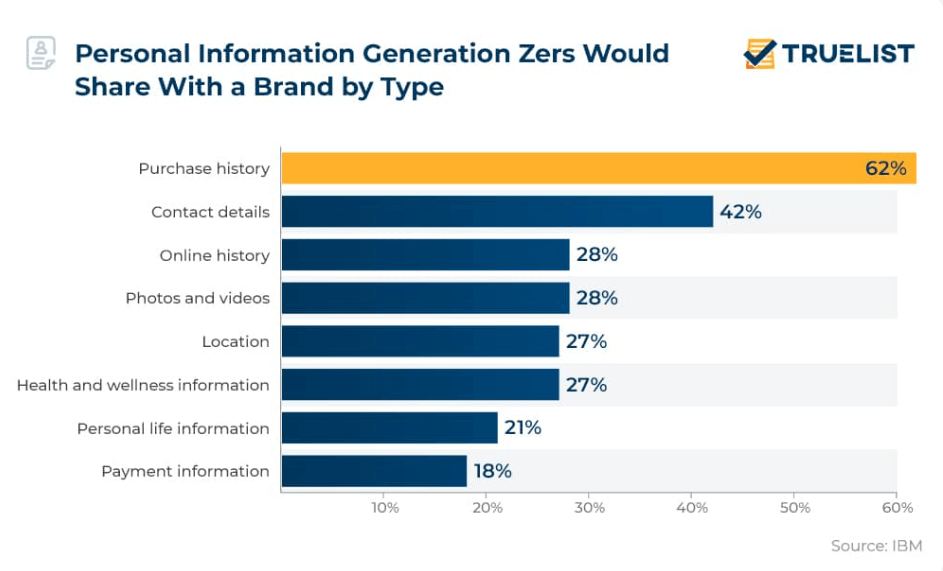
Social responsibility
Mental health, sustainability, and inclusivity are not just trending topics for this generation of consumers, but top priorities. Gen Z is deeply attuned to these causes and actively supports brands that take a similar stance. If you follow and believe in an ethical marketing agenda, you can gain their trust.
Remember, this generation isn’t just a passive observer. For them, by-standing is a major red flag. Brands are expected to integrate these values into their business, and anything less will be seen as a failure of social responsibility.
Budget-consciousness and impulse-buying
While they’re often described as super risk-averse, almost one in two Gen Zers actually admit to making emotional, impulsive purchases. This clearly shows that emotions often drive their behavior.
However, brands should handle this sensitivity with care. Given their high standards for authenticity and genuineness, manipulative tactics like FOMO and fake scarcity are instantly spotted. Trying those old tricks often backfires, leading straight to distrust.
Does Gen Z Require A Whole New Marketing Approach?
Are you wondering if your existing marketing strategy is enough to appeal to younger audiences? The answer is, it depends on your mindset. If segmentation and personalization are already in your toolkit, you’re definitely headed in the right direction. However, if you’re still relying on a one-size-fits-all strategy, it’s time to rethink your approach.
The opportunity for growth lies in moving beyond mass broadcast messaging and embracing data-driven personalization and conversational tools. Gen Z can easily tell when their data is used responsibly and view thoughtful personalization as a sign of responsible marketing.
So, what happens to businesses that aren’t inherently digital-first or currently lack the “Z-friendly” go-to tactics? Are they doomed or obsolete?
As long as authentic and transparent methods remain key for your business, you’re already halfway there. You can embrace the new and strategically evolve in the areas you can.
How to Include Gen Z Tactics into Core Marketing Functions
Here are some quick, non-disruptive fixes to target Gen Z, allowing you to gradually evolve your strategy without changing it to the core.
1. Turn long-form content into snackable
Their preference for short-form video and reels shows that Gen Z is less likely to read through long text, especially if it isn’t easily scannable. The same limited attention applies to videos that require extended watch time.
Propose rich, long-form content for this segment by slicing it into smaller, digestible formats. A quick TikTok video, a Snapchat reel, or even an engaging LinkedIn infographic can significantly move the needle.
For example, if email works well for your brand, segment your Gen Z audience and send them short, visual emails instead of long newsletters, and then adjust based on how they engage.
Check out this email from Bubble. The content is playful, inclusive, and snappy, which is the perfect formula for attracting young people.

2. Prioritize micro-influencers and user-generated content
While many brands focus on broad partnerships and paid media campaigns, micro-influencers seem to have greater influence over Generation Z. Niche content creators with in-depth knowledge thrive within their smaller communities. This lets them form stronger, more credible connections with customers, and that’s something the new generation trusts immediately.
To double this effect, brands need to actively encourage their own customers to share content online using their products and services. This is how you gain organic traction.
A highly effective approach is to run a giveaway contest where you invite followers to share your new products online using a specific branded hashtag. In exchange, offer a prize to a lucky winner. This tactic transforms customers into genuine brand advocates and generates a steady stream of authentic UGC that Gen Z favors over traditional ads.
3. Hyper-personalize content with AI
The rise of AI is not a future trend for Gen Z. They grew up on the TikTok “For You” algorithm and Netflix’s tailored home screens. As a result, they do not just accept AI personalization; they absolutely expect it.
Here’s how to future-proof your marketing strategy and stay relevant to Gen Z:
- Deliver real-time product recommendations based on interests and behavior
- Craft ads and content that look and feel like they belong on the feed of each social platform
- Improve customer service through AI chatbots and virtual assistants for immediate response
Many marketing tools, such as email and CRM software, have integrated AI recommendation capabilities. By integrating them with your eCommerce store, you can access lookalike audiences and group prospects by interests or customer behavioral data to deliver relevant recommendations.
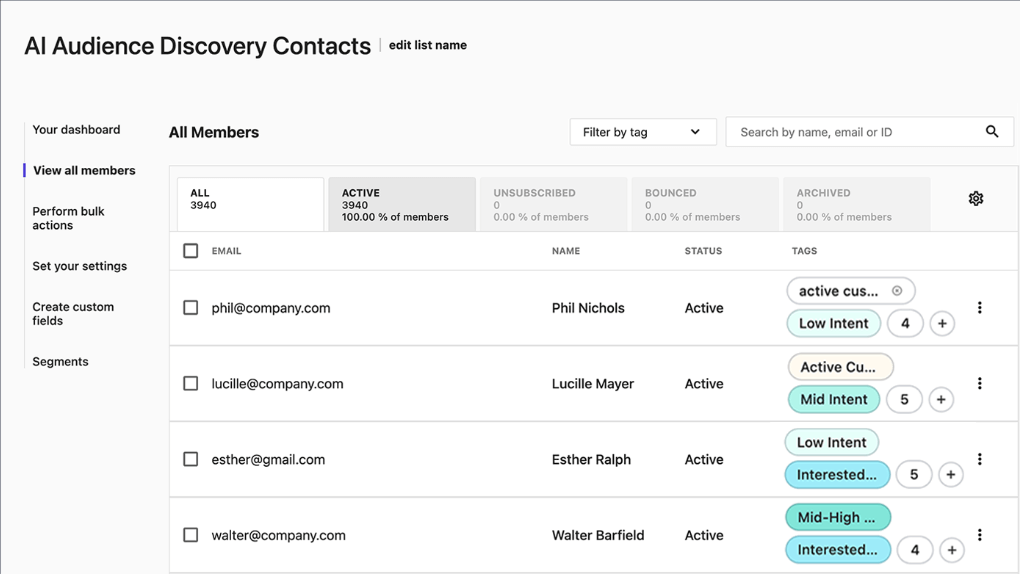
An ethical warning: Request an explicit data disclosure agreement and an opt-in to deliver those experiences. Gen Z consumers are oversensitive to data violations and eager to point them out, so do everything by the book.
4. Optimize the mobile social commerce journey
Gen Z expects mobile-first shopping, and a standalone website isn’t always where discovery happens. You must actively leverage social media shopping options, such as Instagram Shop, to create a unified mobile-first experience.
Every single customer who discovers your products on their smartphone needs to be just one or two clicks away from checkout. Social commerce options help remove that friction by letting users browse, select, and buy without ever leaving the platform.
On top of that, make sure you offer a variety of secure payment methods, including “Buy Now, Pay Later” (BNPL) options, because this is heavily favored by the generation that prioritizes savings.
Also, adding interactive elements, such as AI-powered product recommendations and custom filters, will win you extra loyalty points by making the process seamless and engaging.
5. Embrace community marketing methods
If you’re serious about building strong connections with your younger audience, you need more than basic transactional campaigns. Your goal should be to create opportunities for real-time communication through community marketing efforts.
Think about hosting online live sessions, dedicated private groups, or engaging Q&A sessions. These are the conversations that build genuine loyalty.
These vital connections can also take place offline. For example, you can invite Gen Z customers to pop-up events, offering selfie spots or photo-friendly setups, allowing them to hang out with other Gen Zers, and offering behind-the-scenes access that feels exclusive and “postable.”
This approach is powerful because it rewards customers with experiences, transforming them into a loyal community and fostering authentic, long-term brand advocacy.
6. Show your brand’s values through action
Generation Z strongly disapproves of brands that fail to live up to their mission and disrespect their public values. To earn their trust, you have to walk the walk, not just talk the talk.
To reduce the risk of a PR disaster, you should prioritize subtle, verifiable cues over loud marketing campaigns that can be instantly dismissed as greenwashing or performative activism.
For instance, embed ethical resources directly on your product pages and commit to full transparency about business processes. This quiet confidence will prove that your values are integrated into your daily operations, not just something you say in your advertising.
7. Optimize your content for AI tools
Gen Z already treats AI tools as part of their daily workflow. Early data shows they see ChatGPT as a resource and even a coworker. As these tools become embedded in shopping journeys, brands will need to consider how their product catalogs, messaging, and recommendations appear within AI-driven chats.
You should actively monitor these integrations and prepare for conversational shopping as an emerging channel. This trend reinforces the broader narrative that Gen Z expects speed, convenience, and conversational interactions across every touchpoint.
Move Beyond Gen Z Marketing Trends
Even though Generation Z is a force in the spending economy, their core values and consumer habits are still in progress. Technology is moving so fast that predicting exactly how this generation will adapt to our ever-evolving economic environment is challenging.
So, what’s the ultimate strategy? Move beyond just tracking trends. Create an open, genuine communication channel with young consumers to learn first-hand what they need and how they want it delivered. This continuous dialogue is what builds authenticity and, ultimately, secures the long-term loyalty of a generation that puts values and transparency above all else.
FAQs
Let’s explore the most frequently asked questions regarding marketing to Gen Z:
1. What are the best social platforms for reaching Gen Z?
The most popular social platforms for Gen Z are YouTube (especially Shorts), Instagram (Reels), TikTok, and Snapchat. These are closely followed by Facebook, Discord, and X.
2. How can brands leverage TikTok to reach Gen Z?
To use TikTok effectively, brands should prioritize authentic and entertaining short-form videos. This includes actively participating in platform challenges and trends, and creating genuine collaborations with their favorite content creators and micro-influencers.
3. What does Gen Z value in marketing?
Gen Z supports brands that align with their values and prioritize authenticity. They appreciate flexible payment options (like BNPL), hyper-personalized marketing experiences, and genuine community participation initiatives.
4. What role does gamification play in Gen Z marketing strategies?
Generation Z is fond of interactive experiences that adhere to their preference for engaging, short-form content and personalization.
